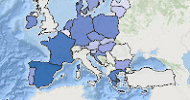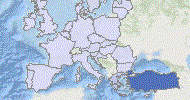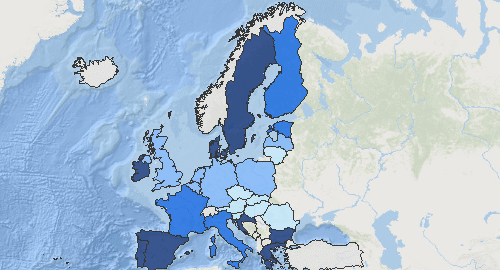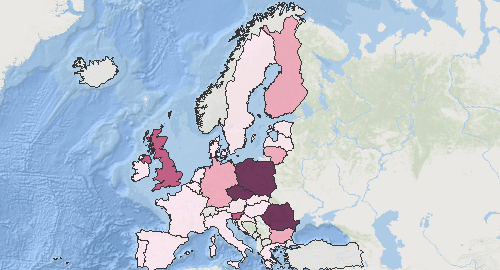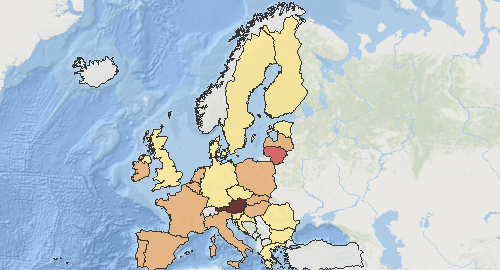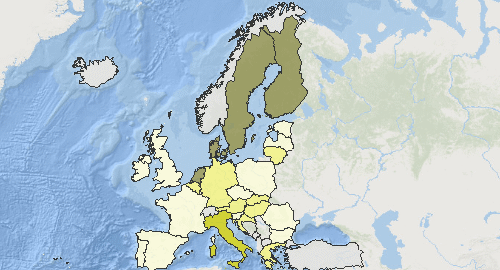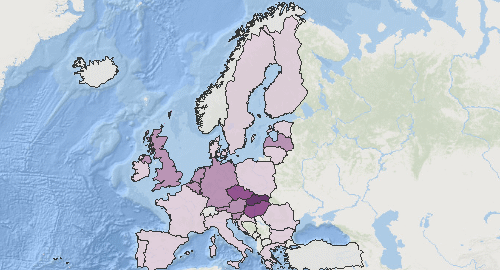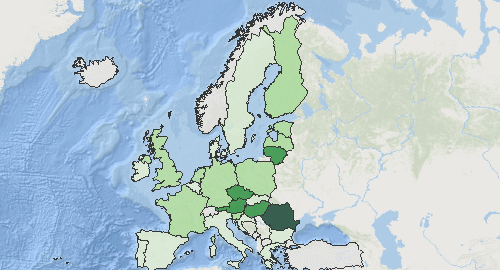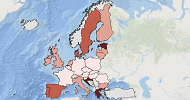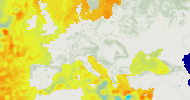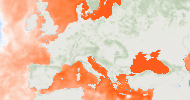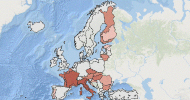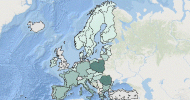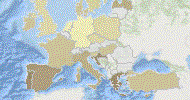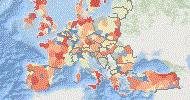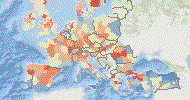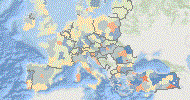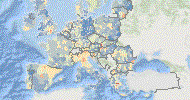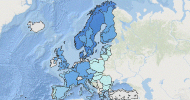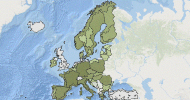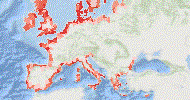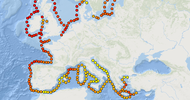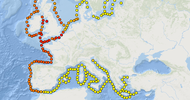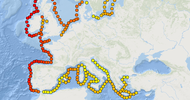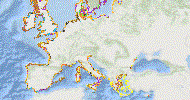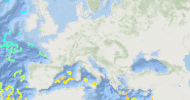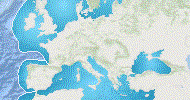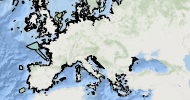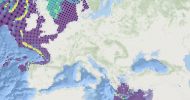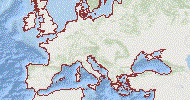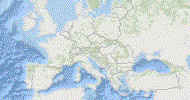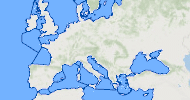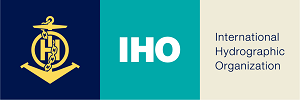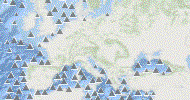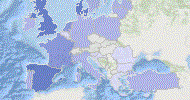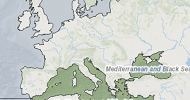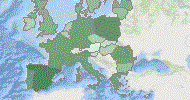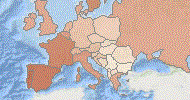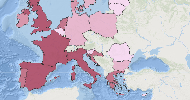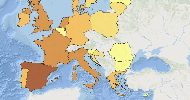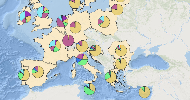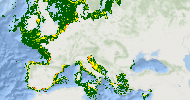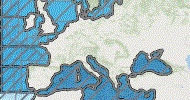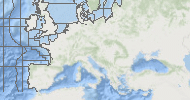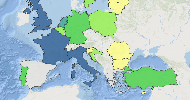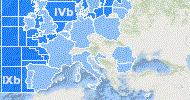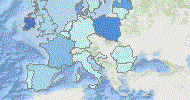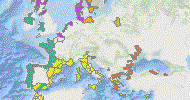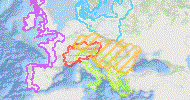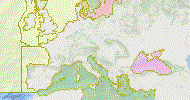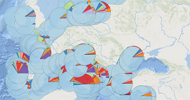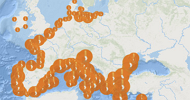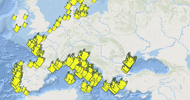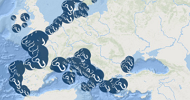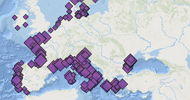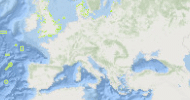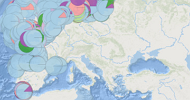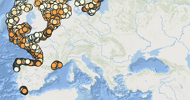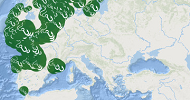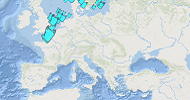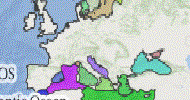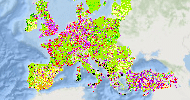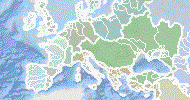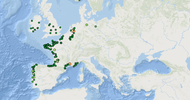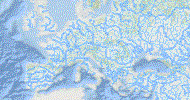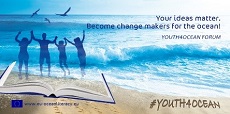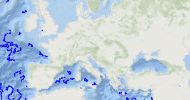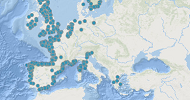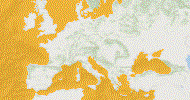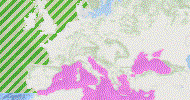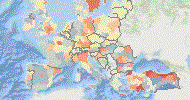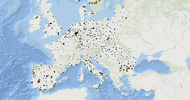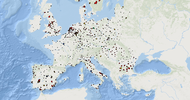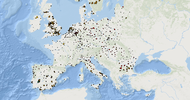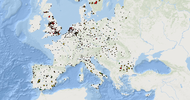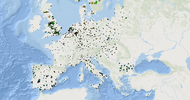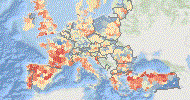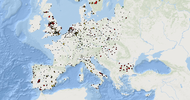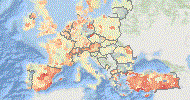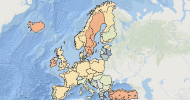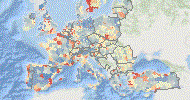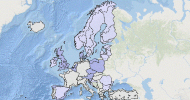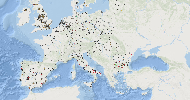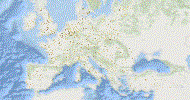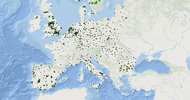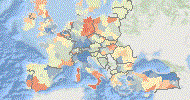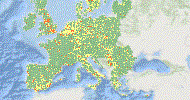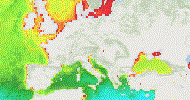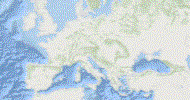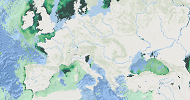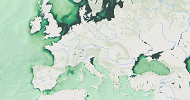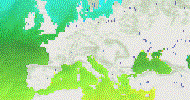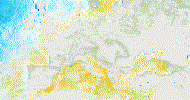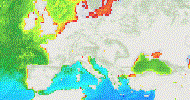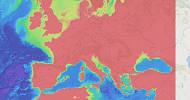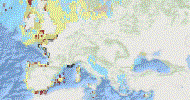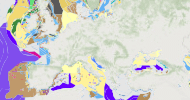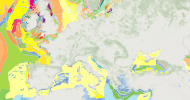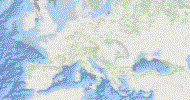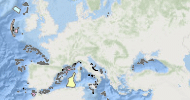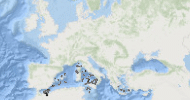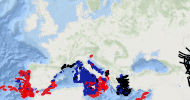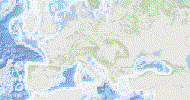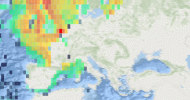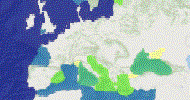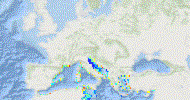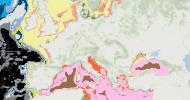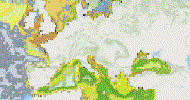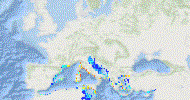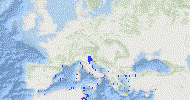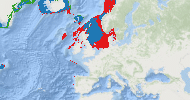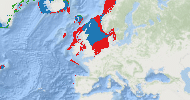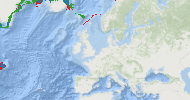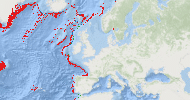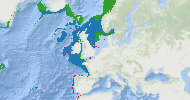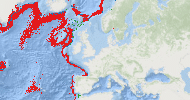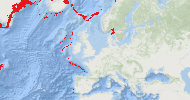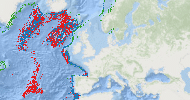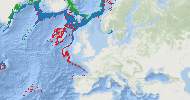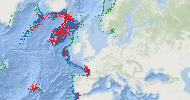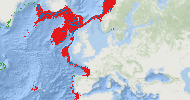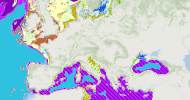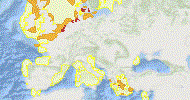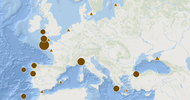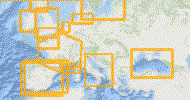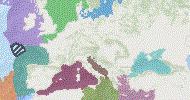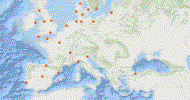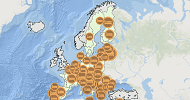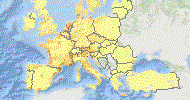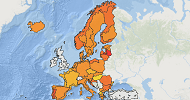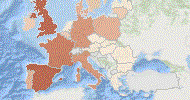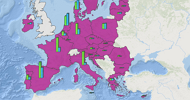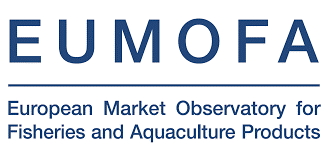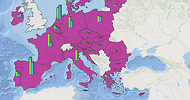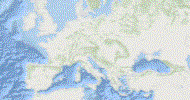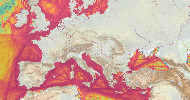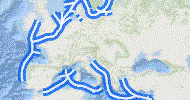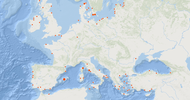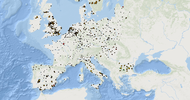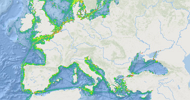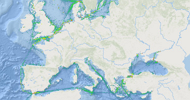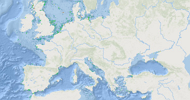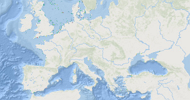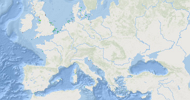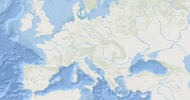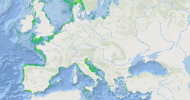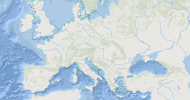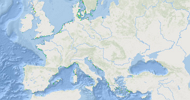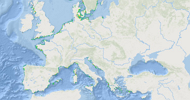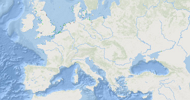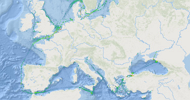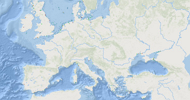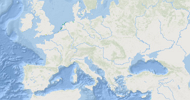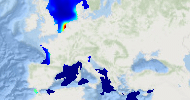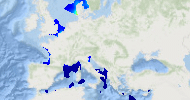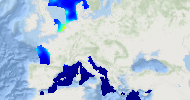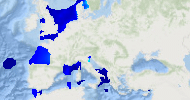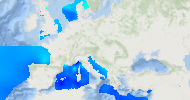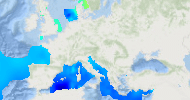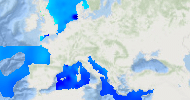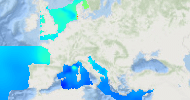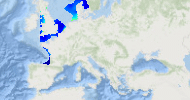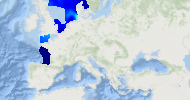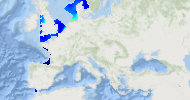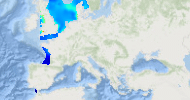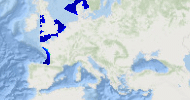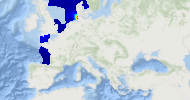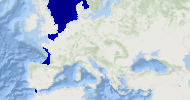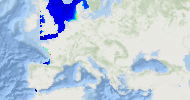
European Atlas of the Seas
Explore, collate and create your own sea map.
Learn more about Europe's seas and coasts, their environment, related human activities and European policies.
Go back to the Atlas
List of layers:
- Algae production
- Aquaculture
- Blue indicators
- Climate change
- Employment
- Energy
- Environment
- Europe
- Fisheries
- Governance
- Litter
- Nature
- Ocean literacy
- Oceanographic instruments
- Organisations and councils
- Pipelines and cables
- Population
- Satellite images
- Sea bottom
- Sea life
- Seabed habitats
- Security
- Spatial planning
- Tourism
- Trade
- Transport
- Water analysis
Algae production
Macroalgae production facilities
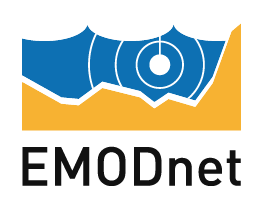 This map shows macroalgae-producing facilities by production methods (land-based, offshore and coastal aquaculture or harvesting). Data have been collected in the following countries: Belgium, Denmark, Estonia, France, Germany, Ireland, Italy, Norway, Portugal, Spain, Sweden, and UK. Macroalgae, also commonly known as seaweeds, have been part of East and South-East Asian citizens’ daily diet for centuries. Nowadays, they are becoming increasingly popular in Europe too for many purposes other than food, as a source material for use in pharmaceuticals, cosmetics, nutrition or energy (biofuel). Companies across Europe are now harvesting, cultivating, or processing them to create high-value products.
This map shows macroalgae-producing facilities by production methods (land-based, offshore and coastal aquaculture or harvesting). Data have been collected in the following countries: Belgium, Denmark, Estonia, France, Germany, Ireland, Italy, Norway, Portugal, Spain, Sweden, and UK. Macroalgae, also commonly known as seaweeds, have been part of East and South-East Asian citizens’ daily diet for centuries. Nowadays, they are becoming increasingly popular in Europe too for many purposes other than food, as a source material for use in pharmaceuticals, cosmetics, nutrition or energy (biofuel). Companies across Europe are now harvesting, cultivating, or processing them to create high-value products.Microalgae production facilities
 This map shows the microalgae-producing facilities by production methods (photobioreactors, open ponds, fermenters, photobioreactors and open ponds, photobioreactors and fermenters). Data have been collected in the following countries: Belgium, Denmark, Estonia, France, Germany, Ireland, Italy, Norway, Portugal, Spain, Sweden, and UK. Microalgae are microscopic plants, typically found in freshwater and marine systems, living in both the water column and sediment. Harvesting, cultivating, or processing algae to create high-value products can make an invaluable contribution to a cleaner and healthier environment. Therefore, the production of algae is an important part of the “blue bioeconomy”.
This map shows the microalgae-producing facilities by production methods (photobioreactors, open ponds, fermenters, photobioreactors and open ponds, photobioreactors and fermenters). Data have been collected in the following countries: Belgium, Denmark, Estonia, France, Germany, Ireland, Italy, Norway, Portugal, Spain, Sweden, and UK. Microalgae are microscopic plants, typically found in freshwater and marine systems, living in both the water column and sediment. Harvesting, cultivating, or processing algae to create high-value products can make an invaluable contribution to a cleaner and healthier environment. Therefore, the production of algae is an important part of the “blue bioeconomy”.Aquaculture
Aquaculture production
 This map shows aquaculture production by country in thousand of tonnes from 2008 onwards. Aquaculture production refers to the farming of aquatic (freshwater or saltwater) organisms (e.g. fish, molluscs, crustaceans and plants) for human use or consumption, under controlled conditions. Aquaculture implies some form of intervention in the natural rearing process such as regular stocking, feeding and protection from predators. Aquaculture plays a key role in many emerging economies, by virtue of its potential to increase food production while helping to reduce pressure on fish resources.
This map shows aquaculture production by country in thousand of tonnes from 2008 onwards. Aquaculture production refers to the farming of aquatic (freshwater or saltwater) organisms (e.g. fish, molluscs, crustaceans and plants) for human use or consumption, under controlled conditions. Aquaculture implies some form of intervention in the natural rearing process such as regular stocking, feeding and protection from predators. Aquaculture plays a key role in many emerging economies, by virtue of its potential to increase food production while helping to reduce pressure on fish resources.(2008-2019)
Aquaculture production by species
 This map shows aquaculture production by species and country. Aquaculture production refers to the farming of aquatic (freshwater or saltwater) organisms (e.g. fish, molluscs, crustaceans and plants) for human use or consumption, under controlled conditions. Aquaculture implies some form of intervention in the natural rearing process such as regular stocking, feeding and protection from predators. Aquaculture plays a key role in many emerging economies, by virtue of its potential to increase food production while helping to reduce pressure on fish resources. More information
This map shows aquaculture production by species and country. Aquaculture production refers to the farming of aquatic (freshwater or saltwater) organisms (e.g. fish, molluscs, crustaceans and plants) for human use or consumption, under controlled conditions. Aquaculture implies some form of intervention in the natural rearing process such as regular stocking, feeding and protection from predators. Aquaculture plays a key role in many emerging economies, by virtue of its potential to increase food production while helping to reduce pressure on fish resources. More information(2008-2018)
Freshwater finfish farms
 This map provides information about the location of freshwater finfish farms in the EU and partner countries where data are available. Finfish is the term used for bony fish, such as salmon, and cartilaginous fish, such as sharks. This is in contrast to shellfish or other aquatic animals. A wide range of species is cultivated, and the diversity of culture is also steadily increasing. The map is based on data collected in the framework of Council Directive 2006/88/EC on animal health requirements which obliges EU Member States to inventory all authorized aquaculture sites under their jurisdiction. Available information on species has been harmonised. Filters are available for the following main species: carp, catfish, “other freshwater pond fish” (zander, pike, perch, tench, etc. – mostly cyprinidae), trout, salmon (smolt and juveniles), eel, sturgeon, tilapia, ornamental fish and other.
This map provides information about the location of freshwater finfish farms in the EU and partner countries where data are available. Finfish is the term used for bony fish, such as salmon, and cartilaginous fish, such as sharks. This is in contrast to shellfish or other aquatic animals. A wide range of species is cultivated, and the diversity of culture is also steadily increasing. The map is based on data collected in the framework of Council Directive 2006/88/EC on animal health requirements which obliges EU Member States to inventory all authorized aquaculture sites under their jurisdiction. Available information on species has been harmonised. Filters are available for the following main species: carp, catfish, “other freshwater pond fish” (zander, pike, perch, tench, etc. – mostly cyprinidae), trout, salmon (smolt and juveniles), eel, sturgeon, tilapia, ornamental fish and other.Seawater finfish farms
 This map provides information about the location of seawater finfish farms in the EU and partner countries (for the year 2017). Finfish is the term used for bony fish, such as salmon, and cartilaginous fish, such as sharks. This is in contrast to shellfish or other aquatic animals. Finfish farming has been well established globally and is growing rapidly. A wide range of species is cultivated, and the diversity of culture is also steadily increasing. The map is based on data collected in the framework of Council Directive 2006/88/EC on animal health requirements which obliges EU Member States to inventory all authorized aquaculture sites under their jurisdiction.
This map provides information about the location of seawater finfish farms in the EU and partner countries (for the year 2017). Finfish is the term used for bony fish, such as salmon, and cartilaginous fish, such as sharks. This is in contrast to shellfish or other aquatic animals. Finfish farming has been well established globally and is growing rapidly. A wide range of species is cultivated, and the diversity of culture is also steadily increasing. The map is based on data collected in the framework of Council Directive 2006/88/EC on animal health requirements which obliges EU Member States to inventory all authorized aquaculture sites under their jurisdiction. Shellfish farms
 This map shows the locations of shellfish farms, which are generally highly specialised in the production of one species. Shellfish are animals that dwell in water and have a shell or shell-like exterior. The major categories of production are mussels, oysters, clams, cockles and scallops. An important characteristic of shellfish is their ability to filter plankton, clearing seawater of whatever excess of these microscopic green plants and effectively improving water quality. The information in the map is provided by Euroshell.
This map shows the locations of shellfish farms, which are generally highly specialised in the production of one species. Shellfish are animals that dwell in water and have a shell or shell-like exterior. The major categories of production are mussels, oysters, clams, cockles and scallops. An important characteristic of shellfish is their ability to filter plankton, clearing seawater of whatever excess of these microscopic green plants and effectively improving water quality. The information in the map is provided by Euroshell.Blue indicators
Employment in coastal tourism
 Europe’s oceans, seas and coasts are a major driver for the European economy, creating both jobs and value. Blue economy is economic activities related to the oceans, seas and coasts and covers a wide range of interlinked established and emerging sectors. This map shows employment information regarding the coastal tourism sector in the European Union. More specifically, the map displays information on the percentage of people employed in this sector compared to the overall employees in the blue economy per Member State. In each country, you can find information regarding the employment in each sub-sector (accommodation, transport and other), the evolution of the overall employment in coastal tourism since 2009 and the exact number of persons employed in coastal tourism each year.
Europe’s oceans, seas and coasts are a major driver for the European economy, creating both jobs and value. Blue economy is economic activities related to the oceans, seas and coasts and covers a wide range of interlinked established and emerging sectors. This map shows employment information regarding the coastal tourism sector in the European Union. More specifically, the map displays information on the percentage of people employed in this sector compared to the overall employees in the blue economy per Member State. In each country, you can find information regarding the employment in each sub-sector (accommodation, transport and other), the evolution of the overall employment in coastal tourism since 2009 and the exact number of persons employed in coastal tourism each year.Data owner: DG MARE
View dashboardsEmployment in marine extraction of minerals, oil and gas
 Europe’s oceans, seas and coasts are a major driver for the European economy, creating both jobs and value. Blue economy is economic activities related to the oceans, seas and coasts and covers a wide range of interlinked established and emerging sectors. This map shows employment information regarding marine extraction of minerals, oil and gas in the European Union. It displays the percentage of people employed in the sector compared to the overall employees in the blue economy. In each country, you can find information regarding the employment in each sub-sector (extraction and support activities), the evolution of the overall employment in the sector since 2009 and the number of persons employed in the sector each year.
Europe’s oceans, seas and coasts are a major driver for the European economy, creating both jobs and value. Blue economy is economic activities related to the oceans, seas and coasts and covers a wide range of interlinked established and emerging sectors. This map shows employment information regarding marine extraction of minerals, oil and gas in the European Union. It displays the percentage of people employed in the sector compared to the overall employees in the blue economy. In each country, you can find information regarding the employment in each sub-sector (extraction and support activities), the evolution of the overall employment in the sector since 2009 and the number of persons employed in the sector each year.Data owner: DG MARE
View dashboardsEmployment in marine fisheries, aquaculture and processing
 Europe’s oceans, seas and coasts are a major driver for the European economy, creating both jobs and value. Blue economy is economic activities related to the oceans, seas and coasts and covers a wide range of interlinked established and emerging sectors. This map shows employment information regarding extraction (i.e., fisheries and aquaculture) and commercialisation of marine living resources in the European Union. It displays the percentage of people working in the sector compared to the overall employees in the blue economy per Member State. In each country, you can find information regarding the employment in each sub-sector (aquaculture, capture fisheries, processing and distribution), the evolution of the overall employment in marine living resources since 2009 and the exact number of persons employed in the sector each year.
Europe’s oceans, seas and coasts are a major driver for the European economy, creating both jobs and value. Blue economy is economic activities related to the oceans, seas and coasts and covers a wide range of interlinked established and emerging sectors. This map shows employment information regarding extraction (i.e., fisheries and aquaculture) and commercialisation of marine living resources in the European Union. It displays the percentage of people working in the sector compared to the overall employees in the blue economy per Member State. In each country, you can find information regarding the employment in each sub-sector (aquaculture, capture fisheries, processing and distribution), the evolution of the overall employment in marine living resources since 2009 and the exact number of persons employed in the sector each year.Data owner: DG MARE
View dashboardsEmployment in maritime transport
 Europe’s oceans, seas and coasts are a major driver for the European economy, creating both jobs and value. Blue economy is economic activities related to the oceans, seas and coasts and covers a wide range of interlinked established and emerging sectors. This map shows employment information regarding maritime transport in the European Union. It displays the percentage of the people working in the sector compared to the overall employees in the blue economy. In each Member State, you can find information regarding the employment in each sub-sector (sea and coastal water transport, inland water transport, renting) and the evolution of the overall employment in the sector since 2009 and the number of persons employed in the sector per country each year.
Europe’s oceans, seas and coasts are a major driver for the European economy, creating both jobs and value. Blue economy is economic activities related to the oceans, seas and coasts and covers a wide range of interlinked established and emerging sectors. This map shows employment information regarding maritime transport in the European Union. It displays the percentage of the people working in the sector compared to the overall employees in the blue economy. In each Member State, you can find information regarding the employment in each sub-sector (sea and coastal water transport, inland water transport, renting) and the evolution of the overall employment in the sector since 2009 and the number of persons employed in the sector per country each year.Data owner: DG MARE
View dashboardsEmployment in ports, warehousing and water projects
 Europe’s oceans, seas and coasts are a major driver for the European economy, creating both jobs and value. Blue Economy is economic activities related to the oceans, seas and coasts and covers a wide range of interlinked established and emerging sectors.This map shows employment information regarding ports, warehousing and construction of water projects in the European Union. It displays the percentage of the people employed in the sector compared to the overall employees in the blue economy. In each country, you can find information regarding the employment in each sub-sector (cargo and warehousing, water projects, service activities), the evolution of the overall employment in the sector since 2009 and the number of persons employed in the sector.
Europe’s oceans, seas and coasts are a major driver for the European economy, creating both jobs and value. Blue Economy is economic activities related to the oceans, seas and coasts and covers a wide range of interlinked established and emerging sectors.This map shows employment information regarding ports, warehousing and construction of water projects in the European Union. It displays the percentage of the people employed in the sector compared to the overall employees in the blue economy. In each country, you can find information regarding the employment in each sub-sector (cargo and warehousing, water projects, service activities), the evolution of the overall employment in the sector since 2009 and the number of persons employed in the sector.Data owner: DG MARE
View dashboardsEmployment in shipbuilding and repair
 Europe’s oceans, seas and coasts are a major driver for the European economy, creating both jobs and value. Blue economy is economic activities related to the oceans, seas and coasts and covers a wide range of interlinked established and emerging sectors.This map shows employment information regarding shipbuilding and repair in the European Union. It displays the percentage of the people working in the sector compared to the overall employees in the blue economy. In each Member State you can find information regarding the employment in each sub-sector (building of ships, repair, equipment, machinery), the evolution of the overall employment in the sector since 2009 and the exact number of persons employed in the sector each year.
Europe’s oceans, seas and coasts are a major driver for the European economy, creating both jobs and value. Blue economy is economic activities related to the oceans, seas and coasts and covers a wide range of interlinked established and emerging sectors.This map shows employment information regarding shipbuilding and repair in the European Union. It displays the percentage of the people working in the sector compared to the overall employees in the blue economy. In each Member State you can find information regarding the employment in each sub-sector (building of ships, repair, equipment, machinery), the evolution of the overall employment in the sector since 2009 and the exact number of persons employed in the sector each year.Data owner: DG MARE
View dashboardsEmployment in the established blue economy
 Europe’s oceans, seas and coasts are a major driver for the European economy, creating both jobs and value. Blue economy is economic activities related to the oceans, seas and coasts and covers a wide range of interlinked established and emerging sectors.This map shows information regarding the overall employment in the main established blue economy sectors (coastal tourism, marine living resources, marine non-living resources, port activities, shipbuilding and repair and maritime transport) in the European Union, per Member State. It displays the percentage of people working in the blue economy compared to the overall working population, while in each country you can find information regarding the employment in each sector and the evolution of the overall blue economy since 2009.
Europe’s oceans, seas and coasts are a major driver for the European economy, creating both jobs and value. Blue economy is economic activities related to the oceans, seas and coasts and covers a wide range of interlinked established and emerging sectors.This map shows information regarding the overall employment in the main established blue economy sectors (coastal tourism, marine living resources, marine non-living resources, port activities, shipbuilding and repair and maritime transport) in the European Union, per Member State. It displays the percentage of people working in the blue economy compared to the overall working population, while in each country you can find information regarding the employment in each sector and the evolution of the overall blue economy since 2009.Data owner: DG MARE
View dashboardsClimate change
Global mean sea level regional trend
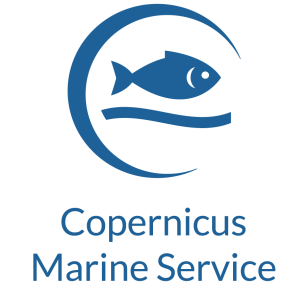 The Global mean sea level regional trend (Millimeters per year) is provided by the Copernicus Marine Service. Sea level is rising as a result of ocean heating and land ice -mass loss. Water expands when heated and about 30% of contemporary global mean sea level rise can be attributed to this thermal expansion alone. Sea level rise can seriously affect human populations in coastal and island regions as well as natural environments such as marine ecosystems.
The Global mean sea level regional trend (Millimeters per year) is provided by the Copernicus Marine Service. Sea level is rising as a result of ocean heating and land ice -mass loss. Water expands when heated and about 30% of contemporary global mean sea level rise can be attributed to this thermal expansion alone. Sea level rise can seriously affect human populations in coastal and island regions as well as natural environments such as marine ecosystems.The time series shows that the average global sea level has risen by more than 8 cm since the early 1990’s and it continues to rise at a rate of 3.3 mm each year. New calculations reveal that global mean sea level rise is accelerating, with this rate increasing by 0.12 ± 0.073 mm each year.
Sea levels do not rise homogeneously and thus some regions are more threatened than others. The map shows the spatial distribution of sea level trends since 1993. It reveals that sea level is rising for the vast majority of the global ocean but there is large-scale variation with regions like the western tropical Pacific Ocean reaching amplitudes of up to +8 mm/year. In this area, the regional trends are mainly due to thermal expansion. The regional sea level trend uncertainty is on the order of 2-3 mm/year with values as low as 0.5 mm/year or as high as 5.0 mm/year depending on the region.
This sea level ocean monitoring indicator is derived from the DUACS delayed-time (DT-2018 version). These products are distributed by the Copernicus Climate Change Service and also available in the Copernicus Marine Service catalogue.
Global sea surface temperature regional trend
 The Global sea surface temperature regional trend (degree Celsius (ºC) per year) is provided by the Copernicus Marine Service. Sea surface temperature is one of the Essential Climate Variables, defined by the Global Climate Observing System, required for monitoring and characterizing the state of the global climate.
The Global sea surface temperature regional trend (degree Celsius (ºC) per year) is provided by the Copernicus Marine Service. Sea surface temperature is one of the Essential Climate Variables, defined by the Global Climate Observing System, required for monitoring and characterizing the state of the global climate.The time series shows that the average global sea surface temperature has risen by more than 0.3 °C since the early 1990s and continues to rise at an unprecedented rate of 0.014 ± 0.001 °C per year. The past four years we observed the warmest ocean surface temperatures since records began.
Sea Surface Temperature does not rise homogeneously and thus some regions are more threatened than others. The map shows the spatial distribution of the mean sea surface temperature trends over the Global Ocean since 1993. It reveals that warming is occurring for the vast majority of the globe between 1993 and 2018. One of the exceptions to this trend is the North Atlantic, particularly the region south of Greenland where a cooling trend is observed.
This sea surface temperature ocean monitoring indicator is based on daily, global climate sea surface temperature (SST) analyses generated by the European Space Agency (ESA), SST Climate Change Initiative (CCI) and the Copernicus Climate Change Service (C3S) and is available from the Copernicus Marine Service catalogue.
Employment
Business demography and high growth enterprise by coastal/non-coastal regions
 This map shows the number of enterprises with growth by 10% or more in coastal vs non-coastal regions. Business demography provides information for births, deaths and survival rates of enterprises, as well as information on related employment data. Business demography data can be used to analyse the dynamics and innovation of different markets, and it delivers key information for policy decision-making. The two main measures used for employment are the number of persons employed and the number of employees.
This map shows the number of enterprises with growth by 10% or more in coastal vs non-coastal regions. Business demography provides information for births, deaths and survival rates of enterprises, as well as information on related employment data. Business demography data can be used to analyse the dynamics and innovation of different markets, and it delivers key information for policy decision-making. The two main measures used for employment are the number of persons employed and the number of employees.Employment by coastal/non-coastal regions
 This map compares employment in both coastal and non-coastal regions. This statistical analysis brings together the employment activities sector in the EU covered by NACE Rev. 2, which is the statistical classification of economic activities.
This map compares employment in both coastal and non-coastal regions. This statistical analysis brings together the employment activities sector in the EU covered by NACE Rev. 2, which is the statistical classification of economic activities.Employment in fisheries and aquaculture
 The fisheries and aquaculture sectors include the jobs range from the production and sale (vessels, fishing gear, bait, etc.) to farming and harvesting, processing, marketing and distribution of fish. These jobs secure sustainable marine and freshwater resource management while also contributing to global economic and social development. This map shows employment in the fisheries and aquaculture sectors by Member State.
The fisheries and aquaculture sectors include the jobs range from the production and sale (vessels, fishing gear, bait, etc.) to farming and harvesting, processing, marketing and distribution of fish. These jobs secure sustainable marine and freshwater resource management while also contributing to global economic and social development. This map shows employment in the fisheries and aquaculture sectors by Member State.Employment in the primary sector
 Employment in the primary sector consists of extraction activities such as mining, agriculture and active fishing. This map shows the share of primary sector employment in overall employment in regions, in comparison with the national average that equals 100. When the indicator's value is below 100, the value in the region is below the national average. When the indicator's value is above 100, the value in the region is above the national average.
Employment in the primary sector consists of extraction activities such as mining, agriculture and active fishing. This map shows the share of primary sector employment in overall employment in regions, in comparison with the national average that equals 100. When the indicator's value is below 100, the value in the region is below the national average. When the indicator's value is above 100, the value in the region is above the national average. Employment in the secondary sector
 Employment in the secondary sector is employment in fisheries related activities, which are not considered as active fishing activities. The secondary sector of the economy produces finished goods from the raw materials extracted by the primary economy. All manufacturing, processing, and construction jobs lie within this sector. This map shows the share of secondary sector employment in overall employment in regions, in comparison with the national average that equals 100. When the indicator's value is below 100, the value in the region is below the national average. When the indicator's value is above 100, the value in the region is above the national average.
Employment in the secondary sector is employment in fisheries related activities, which are not considered as active fishing activities. The secondary sector of the economy produces finished goods from the raw materials extracted by the primary economy. All manufacturing, processing, and construction jobs lie within this sector. This map shows the share of secondary sector employment in overall employment in regions, in comparison with the national average that equals 100. When the indicator's value is below 100, the value in the region is below the national average. When the indicator's value is above 100, the value in the region is above the national average.Employment in the tertiary sector
 Employment in the tertiary sector, also known as the service industry, consists of supplier activities such as retail and wholesale sales, transportation and distribution, restaurants, clerical services, media, tourism, insurance, banking, health care, and law. This map shows the share of tertiary sector employment in overall employment in regions, in comparison with the national average. The national average equals 100. When the indicator's value is below 100, the value in the region is below the national average. When the indicator's value is above 100, the value in the region is above the national average.
Employment in the tertiary sector, also known as the service industry, consists of supplier activities such as retail and wholesale sales, transportation and distribution, restaurants, clerical services, media, tourism, insurance, banking, health care, and law. This map shows the share of tertiary sector employment in overall employment in regions, in comparison with the national average. The national average equals 100. When the indicator's value is below 100, the value in the region is below the national average. When the indicator's value is above 100, the value in the region is above the national average.Gross domestic product (GDP)
 Gross domestic product (GDP) is a measure of the economic activity, defined as the value of all goods and services produced less the value of any goods or services used in their creation. It is widely used to compare living standards, or to monitor economic convergence or divergence within the European Union. The GDP components and related indicators can give valuable insights into the main drivers of economic activity and thus be the basis for the design, monitoring and evaluation of specific EU policies. This map shows gross domestic product in comparison with the national average that equals 100. When the indicator’s value is below 100, the value in the region is below the national average. When the indicator’s value is above 100, the value in the region is above the national average. Additional information: GDP for beginners
Gross domestic product (GDP) is a measure of the economic activity, defined as the value of all goods and services produced less the value of any goods or services used in their creation. It is widely used to compare living standards, or to monitor economic convergence or divergence within the European Union. The GDP components and related indicators can give valuable insights into the main drivers of economic activity and thus be the basis for the design, monitoring and evaluation of specific EU policies. This map shows gross domestic product in comparison with the national average that equals 100. When the indicator’s value is below 100, the value in the region is below the national average. When the indicator’s value is above 100, the value in the region is above the national average. Additional information: GDP for beginnersGross domestic product (GDP) by coastal/non-coastal regions
 This map shows gross domestic product (GDP) at market prices by coastal/non-coastal regions. GDP at market prices is the final result of the production activity of resident producer units. It is defined as the value of all goods and services produced less the value of any goods or services used in their creation. The ESA 2010 (European System of Accounts) regulation may be referred to for more specific explanations on methodology.
This map shows gross domestic product (GDP) at market prices by coastal/non-coastal regions. GDP at market prices is the final result of the production activity of resident producer units. It is defined as the value of all goods and services produced less the value of any goods or services used in their creation. The ESA 2010 (European System of Accounts) regulation may be referred to for more specific explanations on methodology.Gross value added at basic prices by coastal/non-coastal regions
 This map shows the gross value added (GVA) at basic prices by coastal and non-coastal regions. GVA is defined as output value at basic prices minus intermediate consumption valued at purchaser prices. It is the balancing item of the national accounts' production account. GVA can be broken down by industry and institutional sector.More specifically, the sum of GVA over all industries or sectors plus taxes on products minus subsidies on products gives gross domestic product. By subtracting consumption of fixed capital from GVA the corresponding net value added (NVA) is obtained. The concepts of 'GVA at market prices', 'GVA at producer prices' and 'GVA at basic prices' are no longer used in ESA 2010.
This map shows the gross value added (GVA) at basic prices by coastal and non-coastal regions. GVA is defined as output value at basic prices minus intermediate consumption valued at purchaser prices. It is the balancing item of the national accounts' production account. GVA can be broken down by industry and institutional sector.More specifically, the sum of GVA over all industries or sectors plus taxes on products minus subsidies on products gives gross domestic product. By subtracting consumption of fixed capital from GVA the corresponding net value added (NVA) is obtained. The concepts of 'GVA at market prices', 'GVA at producer prices' and 'GVA at basic prices' are no longer used in ESA 2010.Maritime impact
 This map shows the percentage of population impacted by maritime activities, e.g. the share of the population of the EU regions living in maritime service areas. A maritime service area is an area that can be reached within a given travelling time, starting from a location at the coast and using the existing transport network.
This map shows the percentage of population impacted by maritime activities, e.g. the share of the population of the EU regions living in maritime service areas. A maritime service area is an area that can be reached within a given travelling time, starting from a location at the coast and using the existing transport network.Energy
Average wind speed and direction
 This map shows the average wind speed and direction in 237 locations placed at approximately 100 km intervals some 50 to 100 km off Europe's coastline. The observations of wind speed and direction were collected using the altimeter and scatterometer sensors carried by the ERS-1, ERS-2, Topex/Poseidon and Geosat satellites available in the waveclimate.com database. From these observations, averages were calculated in a 200 by 200 kilometre box centred on each location.
This map shows the average wind speed and direction in 237 locations placed at approximately 100 km intervals some 50 to 100 km off Europe's coastline. The observations of wind speed and direction were collected using the altimeter and scatterometer sensors carried by the ERS-1, ERS-2, Topex/Poseidon and Geosat satellites available in the waveclimate.com database. From these observations, averages were calculated in a 200 by 200 kilometre box centred on each location.Coastal nuclear power plants
 In modern nuclear power plants, heat is generated by nuclear fission, meaning that uranium atoms are split to release large amounts of energy. This heat is used to convert water to steam and drive an electricity-generating turbine. In order to safely handle the enormous amounts of heat produced by nuclear fission, these power plants rely on a cooling system. As water is a great way to cool down a reactor, many plants are located along rivers and coasts where water is plentiful and free. This map shows the locations, operational status and other characteristics of coastal nuclear power plants. It is the result of the aggregation and harmonization of data provided by several EU and non-EU sources and is updated every year.
In modern nuclear power plants, heat is generated by nuclear fission, meaning that uranium atoms are split to release large amounts of energy. This heat is used to convert water to steam and drive an electricity-generating turbine. In order to safely handle the enormous amounts of heat produced by nuclear fission, these power plants rely on a cooling system. As water is a great way to cool down a reactor, many plants are located along rivers and coasts where water is plentiful and free. This map shows the locations, operational status and other characteristics of coastal nuclear power plants. It is the result of the aggregation and harmonization of data provided by several EU and non-EU sources and is updated every year.Locations of wind farms
 Wind power, in which a wind turbine converts wind into electricity, is one of the leading sustainable energy sources. As the winds at sea are more consistent and tend to blow harder, large collections of offshore windmills, known as wind farms, have the potential to generate a steady supply of clean wind energy. The map shows the point locations and operational status of offshore wind farms in European seas. The information was aggregated from several sources across the EU by CETMAR for the European Marine Observation and Data Network (EMODnet).
Wind power, in which a wind turbine converts wind into electricity, is one of the leading sustainable energy sources. As the winds at sea are more consistent and tend to blow harder, large collections of offshore windmills, known as wind farms, have the potential to generate a steady supply of clean wind energy. The map shows the point locations and operational status of offshore wind farms in European seas. The information was aggregated from several sources across the EU by CETMAR for the European Marine Observation and Data Network (EMODnet).Locations of wind farms (polygons)
 Wind power, in which a wind turbine converts wind into electricity, is one of the leading sustainable energy sources. As the winds at sea are more consistent and tend to blow harder, large collections of offshore windmills, known as wind farms, have the potential to generate a steady supply of clean wind energy. The map shows the extent, operational status and other characteristics of offshore wind farms in European seas. The information was aggregated from several sources across the EU by CETMAR for the European Marine Observation and Data Network (EMODnet).
Wind power, in which a wind turbine converts wind into electricity, is one of the leading sustainable energy sources. As the winds at sea are more consistent and tend to blow harder, large collections of offshore windmills, known as wind farms, have the potential to generate a steady supply of clean wind energy. The map shows the extent, operational status and other characteristics of offshore wind farms in European seas. The information was aggregated from several sources across the EU by CETMAR for the European Marine Observation and Data Network (EMODnet).Ocean energy - Project locations
 Marine energy or marine power (sometimes referred to as ocean energy, ocean power, or marine and hydrokinetic energy) refers to the energy carried by ocean waves, wind, tides, salinity and temperature differences. The movement of water in the world's oceans creates a vast store of kinetic energy, or energy in motion. The map shows the location of projects that harness this energy and turn it into electricity to power homes, transport and industries.
Marine energy or marine power (sometimes referred to as ocean energy, ocean power, or marine and hydrokinetic energy) refers to the energy carried by ocean waves, wind, tides, salinity and temperature differences. The movement of water in the world's oceans creates a vast store of kinetic energy, or energy in motion. The map shows the location of projects that harness this energy and turn it into electricity to power homes, transport and industries.Ocean energy - Test sites
 Marine energy or marine power (sometimes referred to as ocean energy, ocean power, or marine and hydrokinetic energy) refers to the energy carried by ocean waves, wind, tides, salinity and temperature differences. The movement of water in the world's oceans creates a vast store of kinetic energy, or energy in motion. The map shows sites where new technologies are being developed to harness this energy and turn it into electricity to power homes, transport and industries.
Marine energy or marine power (sometimes referred to as ocean energy, ocean power, or marine and hydrokinetic energy) refers to the energy carried by ocean waves, wind, tides, salinity and temperature differences. The movement of water in the world's oceans creates a vast store of kinetic energy, or energy in motion. The map shows sites where new technologies are being developed to harness this energy and turn it into electricity to power homes, transport and industries.Offshore installations (oil & gas)
 Offshore installations are structures and facilities in a marine environment, usually for the production and transmission of electricity, oil, gas and other resources. The map shows the location and operational status of such offshore installations. The information was derived from the convention for the Protection of the Marine Environment of the North-East Atlantic (OSPAR), which monitors the development of offshore installations and maintains an updated inventory of all oil and gas offshore installations in the OSPAR maritime area.
Offshore installations are structures and facilities in a marine environment, usually for the production and transmission of electricity, oil, gas and other resources. The map shows the location and operational status of such offshore installations. The information was derived from the convention for the Protection of the Marine Environment of the North-East Atlantic (OSPAR), which monitors the development of offshore installations and maintains an updated inventory of all oil and gas offshore installations in the OSPAR maritime area.Tidal amplitude
 This map displays the average tidal amplitude, half of the height difference between low and high tide, in 237 locations placed at approximately 100 km intervals some 50 to 100 km off Europe's coastline. The observations were calculated using a tidal model derived from eight years of satellite altimeter measurements as well as tidal gauge measurements from approximately 7300 coastal stations.
This map displays the average tidal amplitude, half of the height difference between low and high tide, in 237 locations placed at approximately 100 km intervals some 50 to 100 km off Europe's coastline. The observations were calculated using a tidal model derived from eight years of satellite altimeter measurements as well as tidal gauge measurements from approximately 7300 coastal stations.Wave height and direction
 This map shows the significant wave height and direction in 237 locations placed at approximately 100 km intervals some 50 to 100 km off Europe's coastline. The observations of wave height and direction were collected using the altimeter sensors carried by the ERS-1, ERS-2, Topex/Poseidon and Geosat satellites available in the waveclimate.com database. From these observations, averages were calculated in a 200 by 200 kilometre box centred on each location.
This map shows the significant wave height and direction in 237 locations placed at approximately 100 km intervals some 50 to 100 km off Europe's coastline. The observations of wave height and direction were collected using the altimeter sensors carried by the ERS-1, ERS-2, Topex/Poseidon and Geosat satellites available in the waveclimate.com database. From these observations, averages were calculated in a 200 by 200 kilometre box centred on each location.Environment
Coastal geology
 This map shows the geological patterns of the European coastline. The data show different types of shoreline and coastline formations, with 13 geological types and 20 geo-morphological types, ranging from hard rock to soft muddy sediments and from natural beaches to harbor areas and coastal defences. These data were produced by the EUROSION project using multiple digital images to create a shoreline segmentation. Shoreline identification is an important step in the monitoring of coastal areas in order to analyse the effects of erosion and to support Integrated Coastal Zone Management (ICZM).
This map shows the geological patterns of the European coastline. The data show different types of shoreline and coastline formations, with 13 geological types and 20 geo-morphological types, ranging from hard rock to soft muddy sediments and from natural beaches to harbor areas and coastal defences. These data were produced by the EUROSION project using multiple digital images to create a shoreline segmentation. Shoreline identification is an important step in the monitoring of coastal areas in order to analyse the effects of erosion and to support Integrated Coastal Zone Management (ICZM).Coastline changes based on satellite data (2019)
 This map shows the coastal migration in Europe. This gives information on how the coastline – where the land meets the sea or the ocean – is changing. The shoreline-migration map is produced by EMODnet Geology and allows the visualisation of the pan-European coastal behaviour for 2007-2017. This identifies areas of landward migration (erosion or submergence), stability, and seaward migration (accretion or emergence) at different spatial scales. The map provides a useful insight into one of Europeans most obvious climate-change effects. The monitoring of coastal areas in order to analyse the effects of erosion can support Integrated Coastal Zone Management (ICZM).
This map shows the coastal migration in Europe. This gives information on how the coastline – where the land meets the sea or the ocean – is changing. The shoreline-migration map is produced by EMODnet Geology and allows the visualisation of the pan-European coastal behaviour for 2007-2017. This identifies areas of landward migration (erosion or submergence), stability, and seaward migration (accretion or emergence) at different spatial scales. The map provides a useful insight into one of Europeans most obvious climate-change effects. The monitoring of coastal areas in order to analyse the effects of erosion can support Integrated Coastal Zone Management (ICZM).Drifting buoy temperature tracks (Monthly)
 Sea surface temperature is the water temperature close to the ocean’s surface. The temperature in the ocean depends on the amount of solar energy that is absorbed at the surface, which is determined by the latitude, weather patterns and sea ice, and on how this energy is distributed throughout the ocean by mixing, tides and currents. Scientists measure the ocean temperature as it is an important parameter in weather and climate predictions. One of the oceanographic instruments used to automatically collect these temperature measurements are drifting buoys that freely move around the ocean depending on the water currents and host sensors. These observations are relayed by satellite, used immediately to improve forecasts and increase marine safety and are made available through open marine data initiatives like EMODnet. This global data collection effort is coordinated by the Data Buoy Cooperation Panel (DBCP). This map shows the temperature measurements recorded over the previous month by the worldwide array of drifting buoys.
Sea surface temperature is the water temperature close to the ocean’s surface. The temperature in the ocean depends on the amount of solar energy that is absorbed at the surface, which is determined by the latitude, weather patterns and sea ice, and on how this energy is distributed throughout the ocean by mixing, tides and currents. Scientists measure the ocean temperature as it is an important parameter in weather and climate predictions. One of the oceanographic instruments used to automatically collect these temperature measurements are drifting buoys that freely move around the ocean depending on the water currents and host sensors. These observations are relayed by satellite, used immediately to improve forecasts and increase marine safety and are made available through open marine data initiatives like EMODnet. This global data collection effort is coordinated by the Data Buoy Cooperation Panel (DBCP). This map shows the temperature measurements recorded over the previous month by the worldwide array of drifting buoys.Integrated coastal zone management (ICZM)
This map presents information on Integrated Coastal Zone Management (ICZM) across Europe. These data are the outcomes of the European project OURCOAST. Integrated coastal zone management is a process for the management of the coast using an integrated approach, regarding all aspects of the coastal zone, including geographical and political boundaries. This allows an assessment and adaptation to the risks and impacts of climate change and helps to promote sustainable solutions to their coastal management practices.
Large marine ecosystems
www.oceansatlas.org - This map shows the world’s oceans divided into Large Marine Ecosystems (LMEs) that each have distinct seafloor, physical and biological characteristics. The size of an LME is about 200,000 km2 or more and focuses on coastal areas connecting estuaries and river basins seaward to the edge of continental margins. LMEs are useful to help sustainable management of ocean resources (e.g. fish).
Marine Natura 2000 sites
 This map shows the network of marine Natura 2000 sites across Europe. Natura 2000 is based on the 1979 Birds Directive and the 1992 Habitats Directive which have designated Special Protection Areas (SPA’s) and areas of Special Conservation Interest (or Sites of Community Importance; SCI’s) to ensure the long-term survival of Europe's most valuable and threatened species and habitats. Natura 2000 stretches across all EU countries, both on land and at sea over 18% of the EU’s land area and almost 6% of its marine territory. It is the largest coordinated network of conservation areas in the world and a key instrument to protect biodiversity in the European Union.
This map shows the network of marine Natura 2000 sites across Europe. Natura 2000 is based on the 1979 Birds Directive and the 1992 Habitats Directive which have designated Special Protection Areas (SPA’s) and areas of Special Conservation Interest (or Sites of Community Importance; SCI’s) to ensure the long-term survival of Europe's most valuable and threatened species and habitats. Natura 2000 stretches across all EU countries, both on land and at sea over 18% of the EU’s land area and almost 6% of its marine territory. It is the largest coordinated network of conservation areas in the world and a key instrument to protect biodiversity in the European Union.Marine protected areas (by country)
 This map shows the ratio (%) of Marine Protected Area (MPA) and terrestrial area for each European country. Marine Protected Areas (MPAs) have been set up across the world’s oceans to protect vulnerable species and ecosystems, to conserve biodiversity and minimise extinction risk, to re-establish ecosystem integrity, to segregate uses to avoid user conflicts, and to enhance the productivity of fish and marine invertebrate populations. They provide a public focus for marine conservation and are commonly used around the world as management tools to promote the sustainable use of marine resources. Many MPAs also serve as living laboratories – critical to scientific research and discoveries that benefit humanity. When effectively managed, MPAs support the blue economy by helping to sustain fish stocks and bolstering tourism.
This map shows the ratio (%) of Marine Protected Area (MPA) and terrestrial area for each European country. Marine Protected Areas (MPAs) have been set up across the world’s oceans to protect vulnerable species and ecosystems, to conserve biodiversity and minimise extinction risk, to re-establish ecosystem integrity, to segregate uses to avoid user conflicts, and to enhance the productivity of fish and marine invertebrate populations. They provide a public focus for marine conservation and are commonly used around the world as management tools to promote the sustainable use of marine resources. Many MPAs also serve as living laboratories – critical to scientific research and discoveries that benefit humanity. When effectively managed, MPAs support the blue economy by helping to sustain fish stocks and bolstering tourism.(2011-2019)
Spatial prioritization for conserving the deep-sea ecosystems
 Climate change is projected to threaten many commercial deep-sea fishes, sponge and cold-water coral reefs and the services they provide to humans (for example, food resources). Area-based conservation measures like Marine Protected Areas (MPAs) are key tools to protect these vulnerable marine ecosystems. However, these measures should be located in the best areas for conserving the ecosystems efficiently and in the long-term, and if possible, should have a minimum impact on human activities like fishing. Spatial conservation scenarios were run, based on spatial information of multiple types (species, habitats, human uses…), and allowed to identify the areas that best answered specific conservation objectives. The map displays the priority areas for conservation of several vulnerable marine ecosystems of the deep sea, taking into account the predicted change in habitat under a business-as-usual climate change scenario, the connectivity between different areas as well as the economic implications for human activities like fishing and deep-sea mining. The study providing these data is part of the Horizon 2020 ATLAS project, a transatlantic assessment and deep-water ecosystem-based spatial management plan for Europe.
Climate change is projected to threaten many commercial deep-sea fishes, sponge and cold-water coral reefs and the services they provide to humans (for example, food resources). Area-based conservation measures like Marine Protected Areas (MPAs) are key tools to protect these vulnerable marine ecosystems. However, these measures should be located in the best areas for conserving the ecosystems efficiently and in the long-term, and if possible, should have a minimum impact on human activities like fishing. Spatial conservation scenarios were run, based on spatial information of multiple types (species, habitats, human uses…), and allowed to identify the areas that best answered specific conservation objectives. The map displays the priority areas for conservation of several vulnerable marine ecosystems of the deep sea, taking into account the predicted change in habitat under a business-as-usual climate change scenario, the connectivity between different areas as well as the economic implications for human activities like fishing and deep-sea mining. The study providing these data is part of the Horizon 2020 ATLAS project, a transatlantic assessment and deep-water ecosystem-based spatial management plan for Europe.Europe
Coastline
The EEA - The coastline is the area where the land meets the sea or the ocean. This coastline map for highly detailed analysis, e.g. 1:100.000 map scale, for geographical Europe, has been created by the European Environment Agency (EEA). The data is obtained from satellite imagery (e.g. EUHYDRO and GSHHG). A few manual amendments were necessary to meet requirements from EU Nature Directives, Water Framework Directive and Marine Strategy Framework Directive.
Countries
Geographic grid lines
 A geographic grid is an imaginary network of lines superimposed on the earth, serving as a reference system to pinpoint any location on Earth. The vertical lines are called the longitude and the horizontal lines are the latitude. The intersection of these two points determines the exact location. Longitudinal lines measure degrees east to west, running vertically between the north and south poles. Latitudinal lines measure degrees north to south, with 0 degrees being the exact halfway point between the north and south poles.
A geographic grid is an imaginary network of lines superimposed on the earth, serving as a reference system to pinpoint any location on Earth. The vertical lines are called the longitude and the horizontal lines are the latitude. The intersection of these two points determines the exact location. Longitudinal lines measure degrees east to west, running vertically between the north and south poles. Latitudinal lines measure degrees north to south, with 0 degrees being the exact halfway point between the north and south poles.Sea names
Undersea relief names
National Geospatial-Intelligence Agency - The bottom surface of the ocean shows complex and varied geographical features, formed due to tectonic, volcanic, erosional and depositional processes and their interactions. This map shows the names of undersea reliefs (Mid-ocean ridges, Trenches, Submarine canyons, Seamounts, etc.).
Fisheries
Catches by country
 This map displays the total annual catch of fishery products by Member States and some other major fishing nations, such as the UK, Norway, Iceland and Turkey. The data are expressed in the live weight equivalent of the landings. This is the weight as the product is taken from the water (that is, before processing) but excludes any products which, for a variety of reasons, are not landed catches by Member State.
This map displays the total annual catch of fishery products by Member States and some other major fishing nations, such as the UK, Norway, Iceland and Turkey. The data are expressed in the live weight equivalent of the landings. This is the weight as the product is taken from the water (that is, before processing) but excludes any products which, for a variety of reasons, are not landed catches by Member State.(2000-2019)
Catches by fishing zone
 Fish catches cover fish, molluscs, crustaceans and other aquatic animals and plants that are taken for all purposes, by all types and class of vessel, gear and fishermen, operated in all marine areas: high-sea fishing areas, offshore, inshore or brackish water areas. The production from aquaculture and catches in fresh water are excluded.
Fish catches cover fish, molluscs, crustaceans and other aquatic animals and plants that are taken for all purposes, by all types and class of vessel, gear and fishermen, operated in all marine areas: high-sea fishing areas, offshore, inshore or brackish water areas. The production from aquaculture and catches in fresh water are excluded.More info
European structural aid (EFF-EMFF)
 This map highlights one of the European Commission’s initiatives to improve the lives of EU citizens and the marine environment. The European Fisheries Fund (EFF; 2007-2013) and its successor, the European Maritime and Fisheries Fund (EMFF; 2014-2020), have supported the European fisheries sector to transition to ecologically sustainable fishing and aquaculture practices, create jobs and diversify the economies in coastal communities. This maps shows how the EFF budget of €4.3 billion was distributed over the EU member states and over the 5 different priorities (axes):
This map highlights one of the European Commission’s initiatives to improve the lives of EU citizens and the marine environment. The European Fisheries Fund (EFF; 2007-2013) and its successor, the European Maritime and Fisheries Fund (EMFF; 2014-2020), have supported the European fisheries sector to transition to ecologically sustainable fishing and aquaculture practices, create jobs and diversify the economies in coastal communities. This maps shows how the EFF budget of €4.3 billion was distributed over the EU member states and over the 5 different priorities (axes):AXE1: Adjustments and improvements to the fishing fleet.
AXE2: Development of environmentally friendly aquaculture and inland fishing, diversification of aquaculture species as well as processing and marketing of fisheries and aquaculture products.
AXE3: Measures of common interest like the protection of aquatic fauna and flora, the development of ports, improving fishing products traceability, etc.
AXE4: Sustainable development of fisheries areas and communities (e.g. adding value to fisheries products, development of tourism infrastructure, environmental protection) in order to reduce their economic dependency on fish catches.
AXE5: Technical assistance in the form of studies, reports and actions to assist the implementation of operational programs.
Fisheries and aquaculture product consumption
 Aquaculture refers to the farming of aquatic organisms including fish, molluscs, crustaceans and aquatic plants. Fisheries and aquaculture products are an important source of protein and a crucial component of a healthy diet. This map shows the annual per capita consumption of fisheries and aquaculture products.
Aquaculture refers to the farming of aquatic organisms including fish, molluscs, crustaceans and aquatic plants. Fisheries and aquaculture products are an important source of protein and a crucial component of a healthy diet. This map shows the annual per capita consumption of fisheries and aquaculture products.Fisheries local action groups (FLAGs)
 Fish are a vital food source for humanity and the fisheries industry is an important employment sector around the world. However, this resource is under threat due, among others, to overfishing. In order to ensure this food source will be available for future generations, EU’s common fisheries policy is committed to set sustainable fishing limitations in European waters. In addition, the policy also includes funding for Fisheries Local Action Groups (FLAGs) across Europe. These are local, bottom-up initiatives that aim to develop the local fisheries sector in an environmentally friendly as well as socially and economically sustainable way. They design and implement integrated local development strategies for the sustainable development of fisheries areas. This map identifies where the FLAGs are located. To find out more about your local FLAG and the projects they are undertaking you can click on it to go to their website.
Fish are a vital food source for humanity and the fisheries industry is an important employment sector around the world. However, this resource is under threat due, among others, to overfishing. In order to ensure this food source will be available for future generations, EU’s common fisheries policy is committed to set sustainable fishing limitations in European waters. In addition, the policy also includes funding for Fisheries Local Action Groups (FLAGs) across Europe. These are local, bottom-up initiatives that aim to develop the local fisheries sector in an environmentally friendly as well as socially and economically sustainable way. They design and implement integrated local development strategies for the sustainable development of fisheries areas. This map identifies where the FLAGs are located. To find out more about your local FLAG and the projects they are undertaking you can click on it to go to their website.Fishing fleet - Engine power by ports
 This map shows the total engine power of the fishing fleet by port. The engine power shall be the total of the maximum continuous power which can be obtained at the flywheel of each engine and which can, by mechanical, electrical, hydraulic or other means, be applied to vessel propulsion. However, where a gearbox is incorporated into the engine, the power shall be measured at gearbox output flange.
This map shows the total engine power of the fishing fleet by port. The engine power shall be the total of the maximum continuous power which can be obtained at the flywheel of each engine and which can, by mechanical, electrical, hydraulic or other means, be applied to vessel propulsion. However, where a gearbox is incorporated into the engine, the power shall be measured at gearbox output flange.Fishing fleet - Number of vessels by ports
 This map shows the number of vessels of the fishing fleet by port. A fishing fleet is an aggregate of commercial fishing vessels. All EU vessels in the database should have a Community Fleet Register (CFR) number, a unique vessel identifier which is permanently assigned to an EU vessel and cannot be reassigned to another. The Community Fishing Fleet Register, commonly called 'Fleet Register', is an essential tool to implement and monitor the Common Fisheries Policy. It is a database where all the fishing vessels flying the flag of a Member State have to be registered in accordance with Community legislation.
This map shows the number of vessels of the fishing fleet by port. A fishing fleet is an aggregate of commercial fishing vessels. All EU vessels in the database should have a Community Fleet Register (CFR) number, a unique vessel identifier which is permanently assigned to an EU vessel and cannot be reassigned to another. The Community Fishing Fleet Register, commonly called 'Fleet Register', is an essential tool to implement and monitor the Common Fisheries Policy. It is a database where all the fishing vessels flying the flag of a Member State have to be registered in accordance with Community legislation.Fishing fleet - Tonnage by ports
Fishing fleet by engine power
 While fish are an important natural resource, populations are also finite and decades of overfishing have resulted in the decline of some fish stocks. In order to make sure the European fishing industry is sustainable and fair, the EU Common Fisheries Policy sets a number of rules for managing European fishing fleets and catches. Each country’s fishing fleet is monitored in a national register and a capacity ceiling of total vessel engine power and total vessel weight is established. This map shows the total engine power (in kilowatts) of vessels in the fishing fleets of EU and EEA countries.
While fish are an important natural resource, populations are also finite and decades of overfishing have resulted in the decline of some fish stocks. In order to make sure the European fishing industry is sustainable and fair, the EU Common Fisheries Policy sets a number of rules for managing European fishing fleets and catches. Each country’s fishing fleet is monitored in a national register and a capacity ceiling of total vessel engine power and total vessel weight is established. This map shows the total engine power (in kilowatts) of vessels in the fishing fleets of EU and EEA countries.(1990-2018)
Fishing fleet by gross tonnage
 While fish are an important natural resource, populations are also finite and decades of overfishing have resulted in the decline of some fish stocks. In order to make sure the European fishing industry is sustainable and fair, the EU Common Fisheries Policy sets a number of rules for managing European fishing fleets and catches. Each country’s fishing fleet is monitored in a national register and a capacity ceiling of total vessel engine power and total vessel weight is established. This map shows the total weight of vessels (in gross tonnage) in the fishing fleets of EU and EEA countries.
While fish are an important natural resource, populations are also finite and decades of overfishing have resulted in the decline of some fish stocks. In order to make sure the European fishing industry is sustainable and fair, the EU Common Fisheries Policy sets a number of rules for managing European fishing fleets and catches. Each country’s fishing fleet is monitored in a national register and a capacity ceiling of total vessel engine power and total vessel weight is established. This map shows the total weight of vessels (in gross tonnage) in the fishing fleets of EU and EEA countries.(1990-2018)
Fishing fleet by type of gear
 While fish are an important natural resource, populations are also finite and decades of overfishing have resulted in the decline of some fish stocks. In order to make sure the European fishing industry is sustainable and fair, the EU Common Fisheries Policy sets a number of rules for managing European fishing fleets and catches. Each country’s fishing fleet is monitored in a national register and a capacity ceiling of total vessel engine power and total vessel weight is established. The type of fishing gear is also monitored and in some European seas, there are requirements for selective gear to reduce unwanted bycatch. This map shows the distribution of different fishing gear used by the fleets of EU and EEA countries.
While fish are an important natural resource, populations are also finite and decades of overfishing have resulted in the decline of some fish stocks. In order to make sure the European fishing industry is sustainable and fair, the EU Common Fisheries Policy sets a number of rules for managing European fishing fleets and catches. Each country’s fishing fleet is monitored in a national register and a capacity ceiling of total vessel engine power and total vessel weight is established. The type of fishing gear is also monitored and in some European seas, there are requirements for selective gear to reduce unwanted bycatch. This map shows the distribution of different fishing gear used by the fleets of EU and EEA countries.(1990-2018)
Fishing intensity
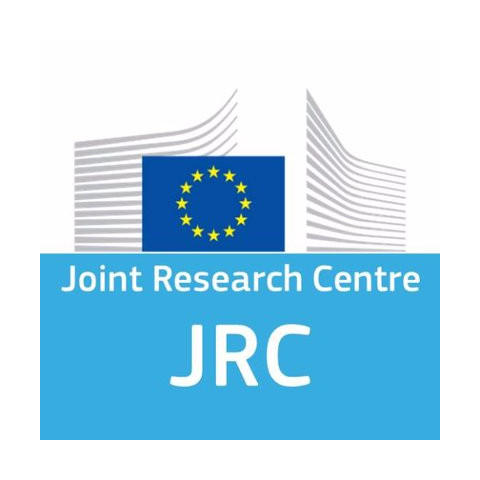 This map of fishing intensity allows to explore in great detail the intensity of fishing activity over all EU waters. The data analysed to create this map consists of around 150 million positions reports from EU fishing vessels above 15 m of length, operating in the Food and Agriculture Organisation (FAO) areas 27, 34 and 37, in the period between September 2014 and September 2015. Each Automatic Identification System (AIS) message provides the position of the vessel, its speed and a timestamp, at intervals of five minutes. These messages were classified as either related to fishing or to steaming through a classification algorithm based on the analysis of individual vessels speed profiles.
This map of fishing intensity allows to explore in great detail the intensity of fishing activity over all EU waters. The data analysed to create this map consists of around 150 million positions reports from EU fishing vessels above 15 m of length, operating in the Food and Agriculture Organisation (FAO) areas 27, 34 and 37, in the period between September 2014 and September 2015. Each Automatic Identification System (AIS) message provides the position of the vessel, its speed and a timestamp, at intervals of five minutes. These messages were classified as either related to fishing or to steaming through a classification algorithm based on the analysis of individual vessels speed profiles.Fishing ports equipped with electronic recording & Reporting System (ERS)
 This map shows the Electronic Recording & Reporting System (ERS) fishing ports. The ERS is the EU system for fisheries controls. It is used to record, report, process, store and send fisheries data (catch, landing, sales and transshipment). The key element is the electronic logbook where the master of a fishing vessel keeps a record of fishing operations, which is then sent to the national authorities and stored in a secure database.
This map shows the Electronic Recording & Reporting System (ERS) fishing ports. The ERS is the EU system for fisheries controls. It is used to record, report, process, store and send fisheries data (catch, landing, sales and transshipment). The key element is the electronic logbook where the master of a fishing vessel keeps a record of fishing operations, which is then sent to the national authorities and stored in a secure database.Fishing zones (FAO)
FAO - This map shows the international fishing zones defined by the Food and Agriculture Organization (FAO) of the United Nations. For statistical purposes, 27 major fishing zones have been internationally established to date. These comprise eight major inland fishing zones covering the inland waters of the continents, and nineteen major marine fishing zones covering the waters of the Atlantic, Indian, Pacific and Southern Oceans, with their adjacent seas. The fishing zones, inland and marine, are identified by their names and by two-digit codes.)
Fishing zones (ICES)
Landings of fishery products
 Landings statistics relate to fisheries products (product weight and value) landed in a country regardless of the nationality of the vessel making the landings, but also to fisheries products landed by the country’s vessels in non-EU ports and then imported into the EU. Landlocked EU countries without a marine fishing fleet are not included (Czechia, Luxembourg, Hungary, Austria and Slovakia).
Landings statistics relate to fisheries products (product weight and value) landed in a country regardless of the nationality of the vessel making the landings, but also to fisheries products landed by the country’s vessels in non-EU ports and then imported into the EU. Landlocked EU countries without a marine fishing fleet are not included (Czechia, Luxembourg, Hungary, Austria and Slovakia).(2000-2018)
Quotas by country and fishing zone
 Illegal, unreported and unregulated (IUU) fishing practices are damaging for the marine environment, present a threat to sustainable fishing and an unfair competition to legitimate fishing operators.
Illegal, unreported and unregulated (IUU) fishing practices are damaging for the marine environment, present a threat to sustainable fishing and an unfair competition to legitimate fishing operators.Cooperation between EU and non-EU countries is important to fight IUU activities, ensure food security and compliance with international rules. The Common Fisheries Policy (CFP) is the fisheries policy of the European Union (EU). It sets quotas for the amount of a specific fish species each country is allowed to catch.
This map presents the catch limits (expressed in tonnes) that are set for most commercial fish stocks. The Commission prepares the proposals, based on scientific advice on the stock status from advisory bodies such as ICES and STECF. By clicking on the map, you will see the corresponding quotas by species, as fixed by Council Regulations.
Quotas by species
 Fish have been an important and abundant source of food for millennia. As the human population size has exploded and fishing practices have become more efficient, fish catches have increased dramatically, becoming more important than what the fish populations are able to regenerate, leading to a decline in the total number of fish.This map shows the national fishing quotas in thousands of tonnes per fish species in the EU countries. Select a species from the drop-down menu to display the quotas allocated to the countries for this species, as fixed by Council Regulations (EU).
Fish have been an important and abundant source of food for millennia. As the human population size has exploded and fishing practices have become more efficient, fish catches have increased dramatically, becoming more important than what the fish populations are able to regenerate, leading to a decline in the total number of fish.This map shows the national fishing quotas in thousands of tonnes per fish species in the EU countries. Select a species from the drop-down menu to display the quotas allocated to the countries for this species, as fixed by Council Regulations (EU).Stocks by fishing zone
 The chart shows the proportion of assessed fish stocks that are overfished (red) and those within safe biological limits (green) in the ICES and GFCM fishing regions of Europe. The numbers in the circles indicate the number of stocks assessed within the given region. The size of the circles relates to the size of the catch in that region.
The chart shows the proportion of assessed fish stocks that are overfished (red) and those within safe biological limits (green) in the ICES and GFCM fishing regions of Europe. The numbers in the circles indicate the number of stocks assessed within the given region. The size of the circles relates to the size of the catch in that region.Governance
Conference of Peripheral Maritime Regions
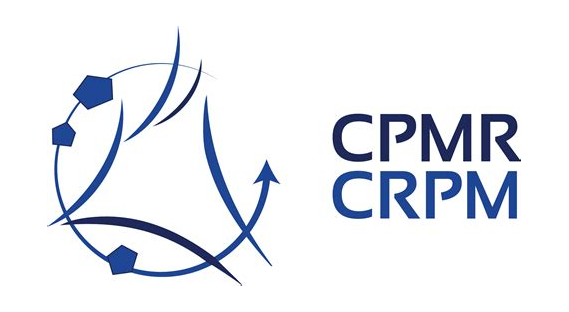 Around 160 regions from 28 countries have come together to form the Conference of Peripheral Maritime Regions of Europe (CPMR). The CPMR organised itself into geographical commissions in order to promote its specific identity and cooperate on subjects of common interest of each of the major sea basins: Atlantic Arc, Balkan and Black Sea, Islands, Inter-mediterranean, Baltic Sea, North Sea. This map shows the member regions of the CPMR, which acts towards ensuring the needs and interests of its member regions among the EU institutions and national governments. In particular, the CPMR works to enhance Europe’s maritime dimension, underlining the importance of an integrated maritime policy, greater regionalisation of the common fisheries policy and a maritime safety system designed to cope with increased shipping traffic.
Around 160 regions from 28 countries have come together to form the Conference of Peripheral Maritime Regions of Europe (CPMR). The CPMR organised itself into geographical commissions in order to promote its specific identity and cooperate on subjects of common interest of each of the major sea basins: Atlantic Arc, Balkan and Black Sea, Islands, Inter-mediterranean, Baltic Sea, North Sea. This map shows the member regions of the CPMR, which acts towards ensuring the needs and interests of its member regions among the EU institutions and national governments. In particular, the CPMR works to enhance Europe’s maritime dimension, underlining the importance of an integrated maritime policy, greater regionalisation of the common fisheries policy and a maritime safety system designed to cope with increased shipping traffic.European Maritime Day
 Established in 2008, European Maritime Day (EMD) is the annual EU meeting point on maritime affairs and sustainable blue growth. This conference connects policy makers, scientists, industry and society through high-level plenary and thematic sessions, workshops and an exhibition area. This map shows the venues for the annual European Maritime Day stakeholder conference since its launch.
Established in 2008, European Maritime Day (EMD) is the annual EU meeting point on maritime affairs and sustainable blue growth. This conference connects policy makers, scientists, industry and society through high-level plenary and thematic sessions, workshops and an exhibition area. This map shows the venues for the annual European Maritime Day stakeholder conference since its launch.European Maritime Day in My Country 2021
 In parallel to the annual European Maritime Day (EMD) conference (this year in Den Helder, The Netherlands, 20 & 21 May 2021), a series of local related events are organised across Europe, reaching out to young people and citizens under the ‘EMD in my Country’ label.
In parallel to the annual European Maritime Day (EMD) conference (this year in Den Helder, The Netherlands, 20 & 21 May 2021), a series of local related events are organised across Europe, reaching out to young people and citizens under the ‘EMD in my Country’ label.EMD In My Country is an important part of the wave of ocean awareness and activism that has been rising steadily in recent years, and the events under its brand have become more and more popular, attracting more than 30.000 participants every year. Local activities such as beach clean-ups, guided tours of ports, art exhibitions, workshops, conferences, seminars, exhibitions on maritime themes, ocean literacy actions, eco-tours and walks in areas with significant maritime heritage, boat excursions, visits to maritime museums, ships, aquaria, shipyards etc. aim to a wide audience across Europe, with a 'fun and game' component directly appealing to a younger public. These activities enable the many European regions with a maritime culture to join in the celebrations and highlight the vital role of the seas and oceans for the local societies.
As the COVID-19 crisis is not yet over, EMD In My Country this year includes both virtual and, where possible, physical events that take place in 2021.
This map offers an overview of the 232 EMD in my Country 2021 local events in 25 different countries (21 EU and 4 non-EU). Many organisers also use their events to demonstrate the European Atlas of the Seas to students and pupils across the EU!
To make this map even more unique, we have hidden something special in it. Join the celebrations, explore the map and try to solve the EMD in My Country 2021 treasure hunt.
European Maritime Day in My Country 2022
 In parallel to the annual European Maritime Day (EMD) conference (this year in Ravenna, Italy, 19 & 20 May 2022), a series of local related events are organised across Europe, reaching out to young people and citizens under the 'EMD in my Country' label.
In parallel to the annual European Maritime Day (EMD) conference (this year in Ravenna, Italy, 19 & 20 May 2022), a series of local related events are organised across Europe, reaching out to young people and citizens under the 'EMD in my Country' label.EMD In My Country is an important part of the wave of ocean awareness and activism that has been rising steadily in recent years, and the events under its brand have become more and more popular, attracting more than 50.000 participants every year. Local activities such as beach clean-ups, guided tours of ports, art exhibitions, workshops, conferences, seminars, exhibitions on maritime themes, ocean literacy actions, eco-tours and walks in areas with significant maritime heritage, boat excursions, visits to maritime museums, ships, aquaria, shipyards etc. aim to a wide audience across Europe, with a 'fun and game' component directly appealing to a younger public. These activities enable the many European regions with a maritime culture to join in the celebrations and highlight the vital role of the seas and oceans for the local societies.
As the COVID-19 crisis is not yet over, EMD In My Country this year includes both virtual and, where possible, physical events that take place in 2022.
This map offers an overview of the EMD in my Country 2022 local events in 29 different countries (22 EU and 7 non-EU). Many organisers also use their events to demonstrate the European Atlas of the Seas to students and pupils across the EU!
To make this map even more unique, we have hidden something special in it. Join the celebrations, explore the map and try to solve the EMD in My Country 2022 Boat Race.
European Maritime Day in My Country 2023
 In parallel to the annual European Maritime Day (EMD) conference (this year in Brest, France, 24 & 25 May 2023), a series of local related events are organised across Europe, reaching out to young people and citizens under the ‘EMD in my Country’ label.
In parallel to the annual European Maritime Day (EMD) conference (this year in Brest, France, 24 & 25 May 2023), a series of local related events are organised across Europe, reaching out to young people and citizens under the ‘EMD in my Country’ label.EMD In My Country is an important part of the wave of ocean awareness and activism that has been rising steadily in recent years, and the events under its brand have become more and more popular, attracting more than 50.000 participants every year. Local activities such as beach clean-ups, guided tours of ports, art exhibitions, workshops, conferences, seminars, exhibitions on maritime themes, ocean literacy actions, eco-tours and walks in areas with significant maritime heritage, boat excursions, visits to maritime museums, ships, aquaria, shipyards etc. aim to a wide audience across Europe, with a 'fun and game' component directly appealing to a younger public. These activities enable the many European regions with a maritime culture to join in the celebrations and highlight the vital role of the seas and oceans for the local societies.
EMD In My Country this year includes physical, virtual and hybrid events.
This map offers an overview of the EMD in my Country 2023 local events in different countries. Many organisers also use their events to demonstrate the European Atlas of the Seas to citizens, students and pupils across the EU!
To make this map even more unique, we have hidden something special in it. Join the celebrations, explore the map and try to solve the Atlas Geocaching Game.
European Maritime Day in My Country 2024
 In parallel to the annual European Maritime Day (EMD) conference (this year in Svendborg, Denmark, on 30-31 May 2024), a series of local related events are organised across Europe, reaching out to young people and citizens under the ‘EMD in my Country’ label. The objective is for people to realise that activities at sea (coastal tourism, fishing, sailing, shipping, offshore renewable energy, aquaculture etc.) are key for the EU’s citizens and economies. The EU has 68,000 km of coastline and about one third of the EU population lives within 50 km of the coast.
In parallel to the annual European Maritime Day (EMD) conference (this year in Svendborg, Denmark, on 30-31 May 2024), a series of local related events are organised across Europe, reaching out to young people and citizens under the ‘EMD in my Country’ label. The objective is for people to realise that activities at sea (coastal tourism, fishing, sailing, shipping, offshore renewable energy, aquaculture etc.) are key for the EU’s citizens and economies. The EU has 68,000 km of coastline and about one third of the EU population lives within 50 km of the coast.Since the first edition in 2018, the number of European Maritime Day in My Country events has increased significantly, with a wide range of activities such as beach clean-ups, guided tours, art exhibitions, workshops, and conferences. In 2023, 494 events were organised in 31 countries, both in the EU and outside the EU.
EMD In My Country this year includes physical, virtual and hybrid events.
This map offers an overview of the EMD in my Country 2024 local events in different countries. Many organisers also use their events to demonstrate the European Atlas of the Seas to citizens, students and pupils across
To make this map even more unique, we have hidden something special in it. Join the celebrations, explore the map and try to solve the Blue Economy Challenge.
European Maritime Day in my country (2019)
 In parallel to the European Maritime Day (EMD) conference, a series of local related events are organised across Europe, reaching out to young people and citizens under the ‘EMD in my Country’ label. This enables the many European regions with a maritime culture to join in the celebrations and highlight the vital role of the seas and oceans for the local societies. This map offers an overview of the 150 EMD in my Country local events organised between April and July 2019 in 21 different countries (15 EU and 6 non-EU) including beach-cleaning activities, guided tours of ports, exhibitions on maritime themes, eco-tours in areas with significant maritime heritage, excursions by boat, etc. Many organisers also used their events to demonstrate the European Atlas of the Seas to students and pupils across the EU! To make this map even more unique, we have hidden something special in it. Join the celebrations, explore the map and try to solve the EMD in my country 2019 challenge!
In parallel to the European Maritime Day (EMD) conference, a series of local related events are organised across Europe, reaching out to young people and citizens under the ‘EMD in my Country’ label. This enables the many European regions with a maritime culture to join in the celebrations and highlight the vital role of the seas and oceans for the local societies. This map offers an overview of the 150 EMD in my Country local events organised between April and July 2019 in 21 different countries (15 EU and 6 non-EU) including beach-cleaning activities, guided tours of ports, exhibitions on maritime themes, eco-tours in areas with significant maritime heritage, excursions by boat, etc. Many organisers also used their events to demonstrate the European Atlas of the Seas to students and pupils across the EU! To make this map even more unique, we have hidden something special in it. Join the celebrations, explore the map and try to solve the EMD in my country 2019 challenge!Macro-Regional Strategies and the Atlantic Strategy
 This map presents the four EU Macro-Regional Strategies and the Maritime Strategy for the Atlantic Ocean Area. A 'Macro-regional strategy' is an integrated framework endorsed by the European Council to address common challenges faced by a defined geographical area relating to Member States and third countries located in the same geographical area which thereby benefit from strengthened cooperation contributing to achievement of economic, social and territorial cohesion.
This map presents the four EU Macro-Regional Strategies and the Maritime Strategy for the Atlantic Ocean Area. A 'Macro-regional strategy' is an integrated framework endorsed by the European Council to address common challenges faced by a defined geographical area relating to Member States and third countries located in the same geographical area which thereby benefit from strengthened cooperation contributing to achievement of economic, social and territorial cohesion.Marine installations
 Europe has an extensive network of marine research infrastructure which incorporates a wide range of facilities including research vessels and embarkable equipment, on-land and offshore research and test facilities in the physical, biological and chemical domain as well as numerous remote and in-situ observation facilities. This map shows the different facilities based on the Marine Research Infrastructures database from EurOcean . Click on the map to see the key characteristics for each facility, including links and contacts in order to access further details provided by the operators of these facilities.
Europe has an extensive network of marine research infrastructure which incorporates a wide range of facilities including research vessels and embarkable equipment, on-land and offshore research and test facilities in the physical, biological and chemical domain as well as numerous remote and in-situ observation facilities. This map shows the different facilities based on the Marine Research Infrastructures database from EurOcean . Click on the map to see the key characteristics for each facility, including links and contacts in order to access further details provided by the operators of these facilities.Mission Actions - EU Mission Restore our Ocean and Waters
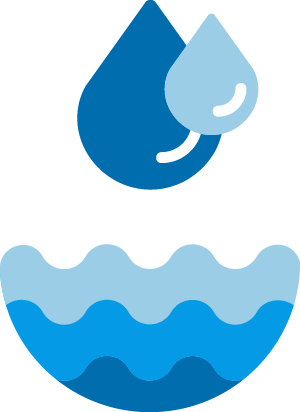 The Mission Actions present the joint efforts to achieve the three objectives of the Mission Restore our Ocean and Waters by 2030 to:
The Mission Actions present the joint efforts to achieve the three objectives of the Mission Restore our Ocean and Waters by 2030 to: 1. Protect and restore marine and freshwater ecosystems and biodiversity, in line with the EU Biodiversity Strategy 2030;
2. Prevent and eliminate pollution of our ocean, seas and waters, in line with the EU Action Plan Towards Zero Pollution for Air, Water and Soil;
3. Make the sustainable blue economy carbon-neutral and circular, in line with the proposed European Climate Law and the holistic vision enshrined in the Sustainable Blue Economy Strategy.
To reach these objectives the Mission is also putting in place two enablers:
- Digital Ocean and Water Knowledge System;
- Public mobilisation and engagement.
(2021-2030)
Regional sea conventions
 In Europe, there are four cooperation structures which aim to protect the marine environment and bring together Member States and neighbouring countries that share marine waters: the Regional Sea Conventions. This map shows the maritime regions covered by the Regional Sea Conventions (Helsinki Convention, Barcelona Convention, Bucharest Convention and OSPAR Convention) on protection of the marine environment. In developing their marine strategies, Member States use these existing regional cooperation structures to coordinate among themselves.
In Europe, there are four cooperation structures which aim to protect the marine environment and bring together Member States and neighbouring countries that share marine waters: the Regional Sea Conventions. This map shows the maritime regions covered by the Regional Sea Conventions (Helsinki Convention, Barcelona Convention, Bucharest Convention and OSPAR Convention) on protection of the marine environment. In developing their marine strategies, Member States use these existing regional cooperation structures to coordinate among themselves.Litter
Beach Clean Up Events
Beach Litter - Composition of litter according to material categories - Official monitoring
 Every year, millions of tons of litter are generated through a variety of human activities and much of this ends up in our oceans, posing environmental, economic and public health problems. It is not surprising that marine litter is identified as one of the fastest growing threats to the health of the world’s oceans, the diverse marine life it supports and, ultimately, humans consuming food from the ocean. This map identifies the kind of litter that ends up on European beaches. Divided into several categories (glass, textile, metal, polymer, etc.), the map shows the percentage of each that have been monitored on Europe’s coastline under the Marine Strategy Framework Directive (MSFD). Litter may have been directly left on beaches or it may be marine litter that has been washed up on the shore. As part of its plastics strategy, the EU adopted a directive to restrict the use of several disposable plastic products and fishing gear. More information on the impact assessment. In addition, it also adopted a directive on port reception facilities for the delivery of waste from ships. This map shows the results from 2001 to 2020.
Every year, millions of tons of litter are generated through a variety of human activities and much of this ends up in our oceans, posing environmental, economic and public health problems. It is not surprising that marine litter is identified as one of the fastest growing threats to the health of the world’s oceans, the diverse marine life it supports and, ultimately, humans consuming food from the ocean. This map identifies the kind of litter that ends up on European beaches. Divided into several categories (glass, textile, metal, polymer, etc.), the map shows the percentage of each that have been monitored on Europe’s coastline under the Marine Strategy Framework Directive (MSFD). Litter may have been directly left on beaches or it may be marine litter that has been washed up on the shore. As part of its plastics strategy, the EU adopted a directive to restrict the use of several disposable plastic products and fishing gear. More information on the impact assessment. In addition, it also adopted a directive on port reception facilities for the delivery of waste from ships. This map shows the results from 2001 to 2020.Beach Litter - Median total number of litter items per 100m & to 1 survey - Official monitoring
 Every year, millions of tons of litter are generated through a variety of human activities and much of this ends up in our oceans, posing environmental, economic and public health problems. It is not surprising that marine litter is identified as one of the fastest growing threats to the health of the world’s oceans, the diverse marine life it supports and, ultimately, humans consuming food from the ocean. This map shows the total abundance (number of items) of marine litter per beach per year from Marine Strategy Framework Directive (MSFD) monitoring. Data have been homogenised and filtered in order to allow comparisons among countries. As part of its plastics strategy, the EU adopted a directive to restrict the use of several disposable plastic products and fishing gear. More information on the impact assessment. In addition, it also adopted a directive on port reception facilities for the delivery of waste from ships. This map shows the results from 2001 to 2022.
Every year, millions of tons of litter are generated through a variety of human activities and much of this ends up in our oceans, posing environmental, economic and public health problems. It is not surprising that marine litter is identified as one of the fastest growing threats to the health of the world’s oceans, the diverse marine life it supports and, ultimately, humans consuming food from the ocean. This map shows the total abundance (number of items) of marine litter per beach per year from Marine Strategy Framework Directive (MSFD) monitoring. Data have been homogenised and filtered in order to allow comparisons among countries. As part of its plastics strategy, the EU adopted a directive to restrict the use of several disposable plastic products and fishing gear. More information on the impact assessment. In addition, it also adopted a directive on port reception facilities for the delivery of waste from ships. This map shows the results from 2001 to 2022.Dredge spoil dumping (points)
 Dredge spoil refers to unconsolidated, randomly mixed sediments composed of rock, soil, and/or shell materials extracted and deposited during dredging and dumping activities. Dredge spoils lie unconformably upon natural, undisturbed soil or regolith and can form anthropogenic landforms (e.g., dredge spoil bank). Dredging for navigation (e.g. creation of ports and boat harbor areas) and for engineering purposes (e.g. digging for cables and pipes) lead to significant amounts of spoil deposited at sea. The environmental impacts, such as interference with fisheries activities or contamination of ecosystems, have now been increasingly recognized. Nowadays, national authorities of many countries have selected dumping zones where those negative consequences would be minimised. This map identifies spoil dumping locations.
Dredge spoil refers to unconsolidated, randomly mixed sediments composed of rock, soil, and/or shell materials extracted and deposited during dredging and dumping activities. Dredge spoils lie unconformably upon natural, undisturbed soil or regolith and can form anthropogenic landforms (e.g., dredge spoil bank). Dredging for navigation (e.g. creation of ports and boat harbor areas) and for engineering purposes (e.g. digging for cables and pipes) lead to significant amounts of spoil deposited at sea. The environmental impacts, such as interference with fisheries activities or contamination of ecosystems, have now been increasingly recognized. Nowadays, national authorities of many countries have selected dumping zones where those negative consequences would be minimised. This map identifies spoil dumping locations. Dredge spoil dumping sites (polygons)
 Dredge spoil refers to unconsolidated, randomly mixed sediments composed of rock, soil, and/or shell materials extracted and deposited during dredging and dumping activities. Dredge spoils lie unconformably upon natural, undisturbed soil or regolith and can form anthropogenic landforms (e.g., dredge spoil bank). Dredging for navigation (e.g. creation of ports and boat harbor areas) and for engineering purposes (e.g. digging for cables and pipes) lead to significant amounts of spoil deposited at sea. The environmental impacts, such as interference with fisheries activities or contamination of ecosystems, have now been increasingly recognized. Nowadays, national authorities of many countries have selected dumping zones where those negative consequences would be minimised. This map identifies spoil dumping areas.
Dredge spoil refers to unconsolidated, randomly mixed sediments composed of rock, soil, and/or shell materials extracted and deposited during dredging and dumping activities. Dredge spoils lie unconformably upon natural, undisturbed soil or regolith and can form anthropogenic landforms (e.g., dredge spoil bank). Dredging for navigation (e.g. creation of ports and boat harbor areas) and for engineering purposes (e.g. digging for cables and pipes) lead to significant amounts of spoil deposited at sea. The environmental impacts, such as interference with fisheries activities or contamination of ecosystems, have now been increasingly recognized. Nowadays, national authorities of many countries have selected dumping zones where those negative consequences would be minimised. This map identifies spoil dumping areas. Dumped munitions (points)
 Munitions dumped on the seabed represent a global source of concern for countries, regional and international organisations, researchers, etc. These can include weapons such as unexploded bombs, including chemical weapons that were dumped after World Wars I and II. These pose a threat to the marine environment, human health, and represent a real challenge to blue economic activities and marine spatial planning, not to mention the risks associated in removing those munitions and technical issues faced in the disposal. In the map, you can identify points which confirm the presence of conventional, chemical or unknown munitions in that area.
Munitions dumped on the seabed represent a global source of concern for countries, regional and international organisations, researchers, etc. These can include weapons such as unexploded bombs, including chemical weapons that were dumped after World Wars I and II. These pose a threat to the marine environment, human health, and represent a real challenge to blue economic activities and marine spatial planning, not to mention the risks associated in removing those munitions and technical issues faced in the disposal. In the map, you can identify points which confirm the presence of conventional, chemical or unknown munitions in that area. Dumped munitions (polygons)
 Munitions dumped on the seabed represent a global source of concern for countries, regional and international organisations, researchers, etc. These can include weapons such as unexploded bombs, including chemical weapons that were dumped after World Wars I and II. These pose a threat to the marine environment, human health, and represent a real challenge to blue economic activities and marine spatial planning, not to mention the risks associated in removing those munitions and technical issues faced in the disposal. In the map, you can identify polygons representing conventional, chemical or unknown munitions.
Munitions dumped on the seabed represent a global source of concern for countries, regional and international organisations, researchers, etc. These can include weapons such as unexploded bombs, including chemical weapons that were dumped after World Wars I and II. These pose a threat to the marine environment, human health, and represent a real challenge to blue economic activities and marine spatial planning, not to mention the risks associated in removing those munitions and technical issues faced in the disposal. In the map, you can identify polygons representing conventional, chemical or unknown munitions.Seabed Litter - Material categories percentage per year
 Every year, millions of tonnes of litter are generated through a variety of human activities and much of this ends up in our oceans, posing environmental, economic and public health problems. It is not surprising that marine litter is identified as one of the fastest growing threats to the health of the world’s oceans, the diverse marine life it supports and, ultimately, humans consuming food from the ocean. This map identifies the percentage of litter divided into several categories (glass, textile, metal, polymer, etc.). As part of its plastics strategy, the EU adopted a directive to restrict the use of several disposable plastic products and fishing gear. More information on the impact assessment. In addition, it also adopted a directive on port reception facilities for the delivery of waste from ships. This map shows the results from 2007 to 2021.
Every year, millions of tonnes of litter are generated through a variety of human activities and much of this ends up in our oceans, posing environmental, economic and public health problems. It is not surprising that marine litter is identified as one of the fastest growing threats to the health of the world’s oceans, the diverse marine life it supports and, ultimately, humans consuming food from the ocean. This map identifies the percentage of litter divided into several categories (glass, textile, metal, polymer, etc.). As part of its plastics strategy, the EU adopted a directive to restrict the use of several disposable plastic products and fishing gear. More information on the impact assessment. In addition, it also adopted a directive on port reception facilities for the delivery of waste from ships. This map shows the results from 2007 to 2021.Seabed litter - Density (Nb. Items/km2)
 Marine litter cause a major hazard for marine life as animals can get entangled or ingest the trash, exposing them to harmful chemicals. These can also make their way up through the food chain threatening human health on a global scale. Furthermore, marine litter causes serious economic damage with valuable, recyclable resources lost at sea, polluted beaches driving away tourism and fishermen’s catches including more and more litter. This map shows the density of seafloor litter (all categories) expressed as the number of litter collected by fish-trawl surveys over the period of one year. Note that the absence of collected data in some areas does not mean they are free from seafloor litter. As part of its plastics strategy, the EU adopted a directive to restrict the use of several disposable plastic products and fishing gear. More information on the impact assessment. In addition, it also adopted a directive on port reception facilities for the delivery of waste from ships.This map shows the results from 2011 to 2022.
Marine litter cause a major hazard for marine life as animals can get entangled or ingest the trash, exposing them to harmful chemicals. These can also make their way up through the food chain threatening human health on a global scale. Furthermore, marine litter causes serious economic damage with valuable, recyclable resources lost at sea, polluted beaches driving away tourism and fishermen’s catches including more and more litter. This map shows the density of seafloor litter (all categories) expressed as the number of litter collected by fish-trawl surveys over the period of one year. Note that the absence of collected data in some areas does not mean they are free from seafloor litter. As part of its plastics strategy, the EU adopted a directive to restrict the use of several disposable plastic products and fishing gear. More information on the impact assessment. In addition, it also adopted a directive on port reception facilities for the delivery of waste from ships.This map shows the results from 2011 to 2022.Seafloor litter - Plastic bags density (Nb. items/km2)
 Plastic material is increasingly polluting our shores and oceans. The plastic pollution does not just clutter our beaches, it forms a deadly trap for many marine animals. They get tangled up in larger pieces of plastic or mistake smaller pieces for food. This map shows the density of plastic bags at the seafloor expressed as the number of bags collected by fish-trawl surveys over the period of one year. Note that the absence of collected data in some areas does not mean they are free from plastic bags. As part of its plastics strategy, the EU adopted a directive to restrict the use of several disposable plastic products and fishing gear. More information on the impact assessment. In addition, it also adopted a directive on port reception facilities for the delivery of waste from ships.
Plastic material is increasingly polluting our shores and oceans. The plastic pollution does not just clutter our beaches, it forms a deadly trap for many marine animals. They get tangled up in larger pieces of plastic or mistake smaller pieces for food. This map shows the density of plastic bags at the seafloor expressed as the number of bags collected by fish-trawl surveys over the period of one year. Note that the absence of collected data in some areas does not mean they are free from plastic bags. As part of its plastics strategy, the EU adopted a directive to restrict the use of several disposable plastic products and fishing gear. More information on the impact assessment. In addition, it also adopted a directive on port reception facilities for the delivery of waste from ships.Waste discharged in ports
 This map is the result of the aggregation and harmonisation of datasets provided by several sources from all across the EU. Following the International Convention for the Prevention of Pollution from Ships (MARPOL Convention), waste at ports are quantified in metric tons (m3) and classified as oily waste, garbage, sewage, harbor waste (garbage) and total amount. These datasets are updated on an annual basis and includes annual data from 2004 to 2017 (where available) from the following countries: Estonia, Finland, France, Latvia, Portugal and Spain.
This map is the result of the aggregation and harmonisation of datasets provided by several sources from all across the EU. Following the International Convention for the Prevention of Pollution from Ships (MARPOL Convention), waste at ports are quantified in metric tons (m3) and classified as oily waste, garbage, sewage, harbor waste (garbage) and total amount. These datasets are updated on an annual basis and includes annual data from 2004 to 2017 (where available) from the following countries: Estonia, Finland, France, Latvia, Portugal and Spain.Nature
Coasts affected by tsunamis
 A tsunami is a series of waves in a water body caused by the displacement of a large volume of water, generally in an ocean or a large lake. As they approach the coast and waters become shallow, the tsunamic waves become compressed and the wave height increases dramatically causing widespread flooding of the coastal region. This map shows the locations along the European coasts which have been affected by tsunamis as well as the process that caused the tsunami. The information was mapped by various national and regional mapping projects and compiled from the literature.
A tsunami is a series of waves in a water body caused by the displacement of a large volume of water, generally in an ocean or a large lake. As they approach the coast and waters become shallow, the tsunamic waves become compressed and the wave height increases dramatically causing widespread flooding of the coastal region. This map shows the locations along the European coasts which have been affected by tsunamis as well as the process that caused the tsunami. The information was mapped by various national and regional mapping projects and compiled from the literature.Land cover
 Land cover is the physical material at the earth’s surface which has important implications for potential land use. This map shows the land cover in Europe. It was derived from interpretations of satellite images by national teams participating in the Corine Land Cover (CLC) programme. This programme is part of the Copernicus Land Monitoring Service initiative, run by the European Commission and the European Environment Agency, which provide environmental information from a combination of air- and space-based observation systems and in-situ monitoring.
Land cover is the physical material at the earth’s surface which has important implications for potential land use. This map shows the land cover in Europe. It was derived from interpretations of satellite images by national teams participating in the Corine Land Cover (CLC) programme. This programme is part of the Copernicus Land Monitoring Service initiative, run by the European Commission and the European Environment Agency, which provide environmental information from a combination of air- and space-based observation systems and in-situ monitoring.Relative sea level trends
 The relative sea level change is the rate at which the sea surface height rises or falls relative to the land at a particular coastal location. In other words, it indicates the change in the sea level relative to the continental crust, which can be caused by changes of the absolute sea level (the sea surface height relative the centre of the earth) and/or by movements of the continental crust. This map shows the relative sea level trends derived from tidal gauge measurements and bottom pressure recorders, provided by the Permanent Service for Mean Sea Level (PSMSL).
The relative sea level change is the rate at which the sea surface height rises or falls relative to the land at a particular coastal location. In other words, it indicates the change in the sea level relative to the continental crust, which can be caused by changes of the absolute sea level (the sea surface height relative the centre of the earth) and/or by movements of the continental crust. This map shows the relative sea level trends derived from tidal gauge measurements and bottom pressure recorders, provided by the Permanent Service for Mean Sea Level (PSMSL).River basins
 This map shows the various river drainage basins, grouped according to the sea into which the water drains. Drainage networks and associated drainage basins form complex functional entities important not only for hydrological processes but also for environmental processes at large. This has been recognised in recent European legislation such as the Water Framework Directive (WFD).
This map shows the various river drainage basins, grouped according to the sea into which the water drains. Drainage networks and associated drainage basins form complex functional entities important not only for hydrological processes but also for environmental processes at large. This has been recognised in recent European legislation such as the Water Framework Directive (WFD). River runoff trends
Rivers and lakes
 This map shows the main European rivers and lakes. Drainage networks and associated drainage basins form complex functional entities important not only for hydrological processes but also for environmental processes at large. This has been recognised in recent European legislation such as the Water Framework Directive (WFD).
This map shows the main European rivers and lakes. Drainage networks and associated drainage basins form complex functional entities important not only for hydrological processes but also for environmental processes at large. This has been recognised in recent European legislation such as the Water Framework Directive (WFD).Sea level anomalies
 A sea level anomaly reveals the regional extent of anomalous (i.e. deviating from what is normal or expected) water levels in the coastal seas for a certain time period. This maps shows the sea level anomalies derived from tidal gauge measurements and bottom pressure recorders, provided by the Permanent Service for Mean Sea Level (PSMSL).
A sea level anomaly reveals the regional extent of anomalous (i.e. deviating from what is normal or expected) water levels in the coastal seas for a certain time period. This maps shows the sea level anomalies derived from tidal gauge measurements and bottom pressure recorders, provided by the Permanent Service for Mean Sea Level (PSMSL).Sea level change
 This map shows the predicted sea level change in 237 locations placed at approximately 100 km intervals some 50 to 100 km off Europe's coastline. Relative sea level rise (RSLR) at the locations are extrapolated from the digitisation of two maps, namely the map by Douglas et al. (2001) which provides an estimate of RSLR for the whole of Europe and the map by Lambeck et al. (1997) which covers a smaller area in more detail, i.e. the North Sea.
This map shows the predicted sea level change in 237 locations placed at approximately 100 km intervals some 50 to 100 km off Europe's coastline. Relative sea level rise (RSLR) at the locations are extrapolated from the digitisation of two maps, namely the map by Douglas et al. (2001) which provides an estimate of RSLR for the whole of Europe and the map by Lambeck et al. (1997) which covers a smaller area in more detail, i.e. the North Sea.Tsunamis origin points
 A tsunami is a series of waves in a water body caused by the displacement of a large volume of water, generally in an ocean or a large lake. Events such as earthquakes, volcanic eruptions, landslides and other disturbances above or below water have the potential to generate a tsunami. This map shows the location of events which produced tsunamis. They were mapped by various national and regional mapping projects and compiled from the literature.
A tsunami is a series of waves in a water body caused by the displacement of a large volume of water, generally in an ocean or a large lake. Events such as earthquakes, volcanic eruptions, landslides and other disturbances above or below water have the potential to generate a tsunami. This map shows the location of events which produced tsunamis. They were mapped by various national and regional mapping projects and compiled from the literature.Underwater noise indicator
 Impulsive underwater noise events are high volume, short duration sounds bursts produced by human licensed activities like pile driving for offshore construction, seismic surveys for oil and gas exploration and underwater explosions. Although its effects are not well understood, this noise may adversely affect marine life, especially mammals that use underwater sound for communication. Within the framework of the Marine Strategy Framework Directive (MSFD), the D11 Commission’s Decision requires that the introduction of energy, including underwater noise, is at levels that do not adversely affect the marine environment. This map shows the number of calendar days during which impulsive noise was registered in an area defined by a common grid (1/3° by 1/6°), known as Pulse Block Day units. The information was derived from the Regional Impulsive Noise Event registries that are collected by OSPAR (in the North East Atlantic) and HELCOM (in Baltic Sea) hosted and managed by ICES, as well as Barcelona Convention and ACCOBAMS (Mediterranean Sea, Black Sea).
Impulsive underwater noise events are high volume, short duration sounds bursts produced by human licensed activities like pile driving for offshore construction, seismic surveys for oil and gas exploration and underwater explosions. Although its effects are not well understood, this noise may adversely affect marine life, especially mammals that use underwater sound for communication. Within the framework of the Marine Strategy Framework Directive (MSFD), the D11 Commission’s Decision requires that the introduction of energy, including underwater noise, is at levels that do not adversely affect the marine environment. This map shows the number of calendar days during which impulsive noise was registered in an area defined by a common grid (1/3° by 1/6°), known as Pulse Block Day units. The information was derived from the Regional Impulsive Noise Event registries that are collected by OSPAR (in the North East Atlantic) and HELCOM (in Baltic Sea) hosted and managed by ICES, as well as Barcelona Convention and ACCOBAMS (Mediterranean Sea, Black Sea).Ocean literacy
EU4Ocean Coalition for Ocean Literacy – EU4Ocean Platform members
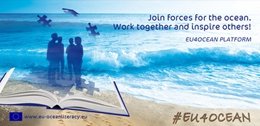 The EU4Ocean Coalition for Ocean Literacy connects diverse organisations, projects and people that contribute to ocean literacy and the sustainable management of the ocean. Supported by the European Commission, this bottom-up inclusive initiative aims at uniting the voices of Europeans to make the ocean a concern of everyone. The Coalition is made up of three components: a Platform for organisations and individuals engaged in Ocean Literacy initiatives, a European Youth Forum for the Ocean and a Network of European Blue Schools.
The EU4Ocean Coalition for Ocean Literacy connects diverse organisations, projects and people that contribute to ocean literacy and the sustainable management of the ocean. Supported by the European Commission, this bottom-up inclusive initiative aims at uniting the voices of Europeans to make the ocean a concern of everyone. The Coalition is made up of three components: a Platform for organisations and individuals engaged in Ocean Literacy initiatives, a European Youth Forum for the Ocean and a Network of European Blue Schools.The EU4Ocean Platform brings together a wide diversity of stakeholders spanning the areas of marine research, science-policy, blue economy industry and the private sector, civil society, arts, education, youth and media. This includes multiple scales from local and national organisations to regional sea and European initiatives. Platform Member Pages.
Platform members can share ideas, build partnerships and collaborate to ensure a more coordinated approach to ocean literacy in Europe and develop concrete activities that creates real awareness, engagement and momentum across society for action and change. The members are mobilised around three Working Groups (WGs) themes: Climate and Ocean, Food from the Ocean and Healthy and Clean Ocean. More information.
Education for Climate: Water surface temperature measured by students
 This educational map shows the outcome of the challenge 'Be a scientist! Mapping climate change at seas & waterways' launched by the Education for Climate Coalition and the European Atlas of the Seas in 2022. Schools across Europe were invited to become data providers for a new map layer in the Atlas. The challenge included 7 phases. The first two phases allowed participants to discover how the Atlas works. Teachers then voted for the topic of the map to be developed: water surface temperature at sea, in rivers, lakes or ponds. Schools could measure the water temperature in different locations and at different times. They provided the results of their measurements and all necessary related information (e.g.; name of the school/group, geographical coordinates of the location where the measurement was made, date and time of the measurement, method used to measure the temperature…) by completing an online form during the data collection phase which ended on 31 March 2023. By doing so, students learned about data collection, data harmonisation, data visualisation and data sharing. How did the schools measure the water temperature? Several schools used a thermometer but – thanks to the collaboration of the Partnership for Observation of the Global Ocean (POGO) and Educational Passages – the Atlas Team also received data from schools who have built miniboats deployed at sea which are equipped with temperature sensors! With this map layer, everyone now has access to the data collected by the schools. The map can be used as teaching material by these schools, other schools and anyone interested! Thank you to all contributing schools, to POGO and to Educational Passage for their wonderful contribution!
This educational map shows the outcome of the challenge 'Be a scientist! Mapping climate change at seas & waterways' launched by the Education for Climate Coalition and the European Atlas of the Seas in 2022. Schools across Europe were invited to become data providers for a new map layer in the Atlas. The challenge included 7 phases. The first two phases allowed participants to discover how the Atlas works. Teachers then voted for the topic of the map to be developed: water surface temperature at sea, in rivers, lakes or ponds. Schools could measure the water temperature in different locations and at different times. They provided the results of their measurements and all necessary related information (e.g.; name of the school/group, geographical coordinates of the location where the measurement was made, date and time of the measurement, method used to measure the temperature…) by completing an online form during the data collection phase which ended on 31 March 2023. By doing so, students learned about data collection, data harmonisation, data visualisation and data sharing. How did the schools measure the water temperature? Several schools used a thermometer but – thanks to the collaboration of the Partnership for Observation of the Global Ocean (POGO) and Educational Passages – the Atlas Team also received data from schools who have built miniboats deployed at sea which are equipped with temperature sensors! With this map layer, everyone now has access to the data collected by the schools. The map can be used as teaching material by these schools, other schools and anyone interested! Thank you to all contributing schools, to POGO and to Educational Passage for their wonderful contribution!(September 2022 – March 2023)
European Atlas of the Seas Ambassadors
 The European Atlas of the Seas is available in 24 languages. For each language, the Atlas has an ambassador who explained, during a communication campaign which ran from September 2020 to September 2021, why the ocean is important to her/him and why we should all care for the ocean and seas. Ambassadors include Commissioner Virginijus Sinkevičius, Director-General for Maritime Affairs and Fisheries Charlina Vitcheva, European Commission Policy Officer Māris Stuļğis, representatives of public authorities in different European Union Member States, directors of institutes and of an aquarium, scientists, coordinators of NGOs, a surfer, a skipper, a diver and a Michelin Star Chef. Explore the map to discover who they are and read the banners with their quotes about the ocean and seas. Note that the ambassadors are mapped according to the countries in which the language they represent is spoken.
The European Atlas of the Seas is available in 24 languages. For each language, the Atlas has an ambassador who explained, during a communication campaign which ran from September 2020 to September 2021, why the ocean is important to her/him and why we should all care for the ocean and seas. Ambassadors include Commissioner Virginijus Sinkevičius, Director-General for Maritime Affairs and Fisheries Charlina Vitcheva, European Commission Policy Officer Māris Stuļğis, representatives of public authorities in different European Union Member States, directors of institutes and of an aquarium, scientists, coordinators of NGOs, a surfer, a skipper, a diver and a Michelin Star Chef. Explore the map to discover who they are and read the banners with their quotes about the ocean and seas. Note that the ambassadors are mapped according to the countries in which the language they represent is spoken.Network of European Blue Schools
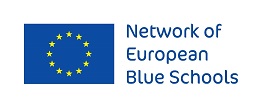 The Network of European Blue Schools is part of the EU4Ocean Coalition and aims to inspire teachers, school directors or staff of education services, to challenge their students, from kindergarten, primary, lower and upper secondary, technical or vocational schools, to Find the Blue and develop a project that links them to the ocean or the sea.
The Network of European Blue Schools is part of the EU4Ocean Coalition and aims to inspire teachers, school directors or staff of education services, to challenge their students, from kindergarten, primary, lower and upper secondary, technical or vocational schools, to Find the Blue and develop a project that links them to the ocean or the sea.Projects of Young Ocean Advocates
Oceanographic instruments
Argo floats
 This map shows the position of Argo floats currently in seas and oceans worldwide. This information is supplied in near real-time by EMODnet Physics. Argo is a global array of 3,800 free-drifting profiling floats that collect environmental ocean data, including measurements of the temperature and salinity of and current velocity (speed) of the upper 2000m of the ocean. The Argo floats are automated with data transmitted and made publicly available within a few hours after collection. In 20 years Argo ocean floats have achieved 2 million ocean profiles. The data are revolutionising our knowledge of ocean dynamics and heat content. Data are also assimilated in near real-time into operational computer models to produce short-term predictions of currents (e.g. offshore oil spills, search and rescue) and temperature (e.g. for fisheries), seasonal-to-interannual forecasting (e.g. El Niño), and for longer-term decadal predictions of the ocean/atmosphere climate system, such as those of the Intergovernmental Panel on Climate Change (IPCC).
This map shows the position of Argo floats currently in seas and oceans worldwide. This information is supplied in near real-time by EMODnet Physics. Argo is a global array of 3,800 free-drifting profiling floats that collect environmental ocean data, including measurements of the temperature and salinity of and current velocity (speed) of the upper 2000m of the ocean. The Argo floats are automated with data transmitted and made publicly available within a few hours after collection. In 20 years Argo ocean floats have achieved 2 million ocean profiles. The data are revolutionising our knowledge of ocean dynamics and heat content. Data are also assimilated in near real-time into operational computer models to produce short-term predictions of currents (e.g. offshore oil spills, search and rescue) and temperature (e.g. for fisheries), seasonal-to-interannual forecasting (e.g. El Niño), and for longer-term decadal predictions of the ocean/atmosphere climate system, such as those of the Intergovernmental Panel on Climate Change (IPCC).Drifting buoy tracks (Monthly)
 Drifting buoys are oceanographic instruments that automatically collect environmental data about the ocean. They are free-drifting and move depending on the water currents and host sensors. Autonomous measuring systems on buoys allow measurement of standard oceanographic parameters (temperature, salinity, currents) and, in some cases, other parameters, e.g. turbidity, oxygen and chlorophyll fluorescence. These observations are relayed by satellite, used immediately to improve forecasts and increase marine safety and are made available through open marine data initiatives like EMODnet. This global data collection effort is coordinated by the Data Buoy Cooperation Panel (DBCP). This map shows the trajectories of the worldwide array of drifting buoys over the previous month.
Drifting buoys are oceanographic instruments that automatically collect environmental data about the ocean. They are free-drifting and move depending on the water currents and host sensors. Autonomous measuring systems on buoys allow measurement of standard oceanographic parameters (temperature, salinity, currents) and, in some cases, other parameters, e.g. turbidity, oxygen and chlorophyll fluorescence. These observations are relayed by satellite, used immediately to improve forecasts and increase marine safety and are made available through open marine data initiatives like EMODnet. This global data collection effort is coordinated by the Data Buoy Cooperation Panel (DBCP). This map shows the trajectories of the worldwide array of drifting buoys over the previous month.Drifting buoys
 This map shows the position of drifting buoys currently in seas and oceans worldwide. These data are supplied in near real-time by EMODnet Physics. A drifting buoy is a type of oceanographic instrument that automatically collects environmental data about the seas and oceans. They are free-drifting and move depending on the water currents and host sensors. Autonomous measuring systems on buoys allow measurement of standard oceanographic parameters (temperature, salinity, currents) and, in some cases, other parameters, e.g. turbidity, oxygen and chlorophyll fluorescence. As an example, wave buoys are used to measure the movement of the water surface as a wave train. The wave train is analysed to determine statistics like the significant wave height and period, and wave direction. These data are important to understand ocean dynamics and to use in computer models to make predictions and forecasts of how the ocean is changing.
This map shows the position of drifting buoys currently in seas and oceans worldwide. These data are supplied in near real-time by EMODnet Physics. A drifting buoy is a type of oceanographic instrument that automatically collects environmental data about the seas and oceans. They are free-drifting and move depending on the water currents and host sensors. Autonomous measuring systems on buoys allow measurement of standard oceanographic parameters (temperature, salinity, currents) and, in some cases, other parameters, e.g. turbidity, oxygen and chlorophyll fluorescence. As an example, wave buoys are used to measure the movement of the water surface as a wave train. The wave train is analysed to determine statistics like the significant wave height and period, and wave direction. These data are important to understand ocean dynamics and to use in computer models to make predictions and forecasts of how the ocean is changing. Ferrybox
 This map shows the position of ferrybox in our seas and oceans worldwide. This information is supplied in near real-time by EMODnet Physics. The ferrybox is an automated surface water monitoring system fitted to the through-flow system of a ship. Ferrybox systems are added to volunteer ships such as commercial vessels (e.g. a passenger ferry or cargo ship) and research vessels. The ferrybox is fitted with different sensors that automatically collect data relating to the physical (e.g. salinity, temperature, turbidity), chemical (nutrients, pH, O2, CO2, and dissolved organic carbon) and biological (e.g. chlorophyll, a proxy for phytoplankton (microscopic plants) ocean parameters. This information can be used to assess marine water quality and marine ecology and can lead to a greater understanding of air-sea interactions e.g. CO2 gas exchange and global changes including ocean acidification.
This map shows the position of ferrybox in our seas and oceans worldwide. This information is supplied in near real-time by EMODnet Physics. The ferrybox is an automated surface water monitoring system fitted to the through-flow system of a ship. Ferrybox systems are added to volunteer ships such as commercial vessels (e.g. a passenger ferry or cargo ship) and research vessels. The ferrybox is fitted with different sensors that automatically collect data relating to the physical (e.g. salinity, temperature, turbidity), chemical (nutrients, pH, O2, CO2, and dissolved organic carbon) and biological (e.g. chlorophyll, a proxy for phytoplankton (microscopic plants) ocean parameters. This information can be used to assess marine water quality and marine ecology and can lead to a greater understanding of air-sea interactions e.g. CO2 gas exchange and global changes including ocean acidification.High Frequency Radar
 This map shows the position of High Frequency Radar (HF-Radar). This information is supplied in near real-time by EMODnet Physics. HF-Radars are based on land and use remote sensing instruments to measure surface current velocity fields near the coast. The resulting surface plots provide a much higher resolution in space than previous techniques like current meter arrays. With a HF-Radar system an entire current field maps (i.e. sea water velocity (m/s) and direction of sea water velocity (degrees)) can be generated in near real time. This information is useful for maritime transportation, knowledge about currents can reduce the use of fuel and subsequently reduce costs of shipping. Currents have huge potential for future electricity generation by harnessing of the kinetic energy of marine currents.
This map shows the position of High Frequency Radar (HF-Radar). This information is supplied in near real-time by EMODnet Physics. HF-Radars are based on land and use remote sensing instruments to measure surface current velocity fields near the coast. The resulting surface plots provide a much higher resolution in space than previous techniques like current meter arrays. With a HF-Radar system an entire current field maps (i.e. sea water velocity (m/s) and direction of sea water velocity (degrees)) can be generated in near real time. This information is useful for maritime transportation, knowledge about currents can reduce the use of fuel and subsequently reduce costs of shipping. Currents have huge potential for future electricity generation by harnessing of the kinetic energy of marine currents.Mooring platforms
 This map shows the position of mooring platforms across the seas and oceans worldwide. Data are supplied by EMODnet Physics. Mooring platforms are fixed structures that can be used to monitor the ocean from the sea surface to the sea floor. The moorings are made of thick wire and cable and are held up in the water column with various forms of buoyancy such as glass balls and syntactic foam floats. A variety of instruments, sensors and samplers are attached to the mooring platform to measure physical, chemical and biological ocean parameters. Some sensors are automated, collecting and transmitting data in a matter of hours. Automated sensors include CTDs (conductivity, temperature depth sensors), current meters (e.g. acoustic Doppler current profilers or deprecated rotor current meters) and some chemical sensors e.g. chlorophyll-a, a proxy for phytoplankton. Other instruments sample the water (e.g. to collect phytoplankton, microscopic plants) or trap organic matter falling to the seafloor (e.g. sediment traps). Moorings can be deployed in the coastal and open ocean, for long durations e.g. at least one year, powered with alkaline or lithium battery packs. Sensors and samplers need regular e.g. yearly maintenance which is often done by research vessels.
This map shows the position of mooring platforms across the seas and oceans worldwide. Data are supplied by EMODnet Physics. Mooring platforms are fixed structures that can be used to monitor the ocean from the sea surface to the sea floor. The moorings are made of thick wire and cable and are held up in the water column with various forms of buoyancy such as glass balls and syntactic foam floats. A variety of instruments, sensors and samplers are attached to the mooring platform to measure physical, chemical and biological ocean parameters. Some sensors are automated, collecting and transmitting data in a matter of hours. Automated sensors include CTDs (conductivity, temperature depth sensors), current meters (e.g. acoustic Doppler current profilers or deprecated rotor current meters) and some chemical sensors e.g. chlorophyll-a, a proxy for phytoplankton. Other instruments sample the water (e.g. to collect phytoplankton, microscopic plants) or trap organic matter falling to the seafloor (e.g. sediment traps). Moorings can be deployed in the coastal and open ocean, for long durations e.g. at least one year, powered with alkaline or lithium battery packs. Sensors and samplers need regular e.g. yearly maintenance which is often done by research vessels.River gauging stations
 This map shows the position of stream gauges in Europe. The information is supplied by EMODnet Physics. A stream gauge, streamgage or gauging station is a land-based instrument that monitor and test terrestrial bodies of water (streams, wells, lakes, canals, reservoirs, or other water bodies). Instruments at these stations measure a range of parameters including water height, discharge, water chemistry, and water temperature. Data are used by hydrologists or environmental scientists to monitor and test terrestrial bodies of water (streams, wells, lakes, canals, reservoirs, or other water bodies) to monitor the water quality and biota (living organisms). The location of gauging stations are often found on topographical maps. Some gauging stations are highly automated and may include telemetry capability transmitted to a central data logging facility.
This map shows the position of stream gauges in Europe. The information is supplied by EMODnet Physics. A stream gauge, streamgage or gauging station is a land-based instrument that monitor and test terrestrial bodies of water (streams, wells, lakes, canals, reservoirs, or other water bodies). Instruments at these stations measure a range of parameters including water height, discharge, water chemistry, and water temperature. Data are used by hydrologists or environmental scientists to monitor and test terrestrial bodies of water (streams, wells, lakes, canals, reservoirs, or other water bodies) to monitor the water quality and biota (living organisms). The location of gauging stations are often found on topographical maps. Some gauging stations are highly automated and may include telemetry capability transmitted to a central data logging facility.Underwater glider
 This map shows the position of underwater gliders in the seas and oceans worldwide. This information is supplied in near real-time by EMODnet Physics. Underwater gliders are oceanographic instrument that automatically collect ocean data and monitor the seas. Gliders follow an up-and-down, sawtooth-like profile through the water. Gliders typically have a range of sensors taking measurements such as temperature, conductivity (to calculate salinity), currents, chlorophyll fluorescence (a proxy for phytoplankton), optical backscatter, bottom depth, and (occasionally) acoustic backscatter. They travel at various water depths and navigate with the help of Global Positioning System (GPS) communication at the surface, pressure sensors, tilt sensors, and magnetic compasses providing data on temporal and spatial scale.
This map shows the position of underwater gliders in the seas and oceans worldwide. This information is supplied in near real-time by EMODnet Physics. Underwater gliders are oceanographic instrument that automatically collect ocean data and monitor the seas. Gliders follow an up-and-down, sawtooth-like profile through the water. Gliders typically have a range of sensors taking measurements such as temperature, conductivity (to calculate salinity), currents, chlorophyll fluorescence (a proxy for phytoplankton), optical backscatter, bottom depth, and (occasionally) acoustic backscatter. They travel at various water depths and navigate with the help of Global Positioning System (GPS) communication at the surface, pressure sensors, tilt sensors, and magnetic compasses providing data on temporal and spatial scale.Organisations and councils
Advisory Councils
 The Advisory Councils (ACs) are stakeholder-led organisations that provide the Commission and EU countries with recommendations on fisheries management matters. This may include advice on conservation and socio-economic aspects of management, and on simplification of rules. Advisory Councils are consulted in the context of regionalisation. Advisory Councils should also contribute to data for fisheries management and conservation measures. Advisory Councils are composed of representatives from the industry and from other interest groups. This map presents the areas covered by some Advisory Councils (ACs).
The Advisory Councils (ACs) are stakeholder-led organisations that provide the Commission and EU countries with recommendations on fisheries management matters. This may include advice on conservation and socio-economic aspects of management, and on simplification of rules. Advisory Councils are consulted in the context of regionalisation. Advisory Councils should also contribute to data for fisheries management and conservation measures. Advisory Councils are composed of representatives from the industry and from other interest groups. This map presents the areas covered by some Advisory Councils (ACs). Organisations of producers
 Producer organisations are officially recognised bodies set up by fishery or aquaculture producers. They are in charge of the day-to-day management of fisheries and play an essential role in running the Common Fisheries Policy and the Common Organisation of the Markets as they:
Producer organisations are officially recognised bodies set up by fishery or aquaculture producers. They are in charge of the day-to-day management of fisheries and play an essential role in running the Common Fisheries Policy and the Common Organisation of the Markets as they:- guide producers towards sustainable fishing and aquaculture, in particular by collectively managing the activities of their members
- help them match supplies with market demands, and
- support them in creating added value.
Regional fisheries management organisations (highly-migratory species)
 This map shows Regional Fisheries Management Organisations (RFMOs) which manage fish stocks by geographical area. RFMOs are international organisations establishing binding measures for conservation and sustainable management of highly migratory or straddling fish species. RFMOs cover the majority of the world’s seas. They can broadly be divided into RFMOs focusing only on the management of highly migratory fish stocks, notably tuna and tuna-like species (‘tuna-RFMOs’) and RFMOs that manage other fisheries resources (i.e. pelagic or demersal) in a more specific area as showed on the map below. The organisations are formed by countries with fishing interests in the given geographical area and coastal states. RFMOs have the power to adopt a variety of rules to manage the fishery. They use management tools like catch limits (quota), technical measures, spatial and/or temporal restrictions, and monitoring, control and surveillance activities to ensure compliance with the rules. RFMOs make decisions based on scientific advice provided by their respective scientific bodies and regularly review member compliance. The European Union, represented by the Commission, plays an active role in 10 non-tuna organisations. Click on the RFMOs on the map to access their websites.
This map shows Regional Fisheries Management Organisations (RFMOs) which manage fish stocks by geographical area. RFMOs are international organisations establishing binding measures for conservation and sustainable management of highly migratory or straddling fish species. RFMOs cover the majority of the world’s seas. They can broadly be divided into RFMOs focusing only on the management of highly migratory fish stocks, notably tuna and tuna-like species (‘tuna-RFMOs’) and RFMOs that manage other fisheries resources (i.e. pelagic or demersal) in a more specific area as showed on the map below. The organisations are formed by countries with fishing interests in the given geographical area and coastal states. RFMOs have the power to adopt a variety of rules to manage the fishery. They use management tools like catch limits (quota), technical measures, spatial and/or temporal restrictions, and monitoring, control and surveillance activities to ensure compliance with the rules. RFMOs make decisions based on scientific advice provided by their respective scientific bodies and regularly review member compliance. The European Union, represented by the Commission, plays an active role in 10 non-tuna organisations. Click on the RFMOs on the map to access their websites.Regional fisheries management organisations (non highly-migratory species)
 This map shows Regional Fisheries Management Organisations (RFMOs) which manage fish stocks by geographical area. RFMOs are international organisations establishing binding measures for conservation and sustainable management of highly migratory or straddling fish species. RFMOs cover the majority of the world’s seas. They can broadly be divided into RFMOs focusing only on the management of highly migratory fish stocks, notably tuna and tuna-like species (‘tuna-RFMOs’) and RFMOs that manage other fisheries resources (i.e. pelagic or demersal) in a more specific area as showed on the map below. The organisations are formed by countries with fishing interests in the given geographical area and coastal states. RFMOs have the power to adopt a variety of rules to manage the fishery. They use management tools like catch limits (quota), technical measures, spatial and/or temporal restrictions, and monitoring, control and surveillance activities to ensure compliance with the rules. RFMOs make decisions based on scientific advice provided by their respective scientific bodies and regularly review member compliance. The European Union, represented by the Commission, plays an active role in 10 non-tuna organisations. Click on the RFMOs on the map to access their websites.
This map shows Regional Fisheries Management Organisations (RFMOs) which manage fish stocks by geographical area. RFMOs are international organisations establishing binding measures for conservation and sustainable management of highly migratory or straddling fish species. RFMOs cover the majority of the world’s seas. They can broadly be divided into RFMOs focusing only on the management of highly migratory fish stocks, notably tuna and tuna-like species (‘tuna-RFMOs’) and RFMOs that manage other fisheries resources (i.e. pelagic or demersal) in a more specific area as showed on the map below. The organisations are formed by countries with fishing interests in the given geographical area and coastal states. RFMOs have the power to adopt a variety of rules to manage the fishery. They use management tools like catch limits (quota), technical measures, spatial and/or temporal restrictions, and monitoring, control and surveillance activities to ensure compliance with the rules. RFMOs make decisions based on scientific advice provided by their respective scientific bodies and regularly review member compliance. The European Union, represented by the Commission, plays an active role in 10 non-tuna organisations. Click on the RFMOs on the map to access their websites.Pipelines and cables
Offshore pipelines routes
 An offshore pipeline (also known as marine, subsea or submarine pipeline) is a pipeline that is laid on the seabed or below it inside a trench. In some cases, the pipeline is mostly on-land but in places it crosses water expanses, such as small seas, straits and rivers. Submarine pipelines are used primarily to carry oil or gas, but transportation of water is also important. This map shows the route and operational status of offshore pipelines in different European countries. The information is the result of the aggregation and harmonisation of datasets provided by several sources from EU member states as well as Norway and the UK.
An offshore pipeline (also known as marine, subsea or submarine pipeline) is a pipeline that is laid on the seabed or below it inside a trench. In some cases, the pipeline is mostly on-land but in places it crosses water expanses, such as small seas, straits and rivers. Submarine pipelines are used primarily to carry oil or gas, but transportation of water is also important. This map shows the route and operational status of offshore pipelines in different European countries. The information is the result of the aggregation and harmonisation of datasets provided by several sources from EU member states as well as Norway and the UK.Telecommunication cables - Germany
Telecommunication cables - Malta
 A submarine communications cable is a cable laid on the seabed between land-based stations to carry telecommunication signals across stretches of ocean and sea. This map shows the actual routes of telecommunication cables that originate from or pass through Maltese waters. The information was provided by the International Ocean Institute-Malta Operational Centre (University Of Malta/Physical Oceanography Unit) and originated from the Transport Malta-Maritime Division, ex. Malta Maritime Authority.
A submarine communications cable is a cable laid on the seabed between land-based stations to carry telecommunication signals across stretches of ocean and sea. This map shows the actual routes of telecommunication cables that originate from or pass through Maltese waters. The information was provided by the International Ocean Institute-Malta Operational Centre (University Of Malta/Physical Oceanography Unit) and originated from the Transport Malta-Maritime Division, ex. Malta Maritime Authority.Telecommunication cables - SIGCables routes
Population
Active population
 This map shows the share of economically active population by European region, in comparison with the national average that equals 100. When the indicator's value in the region is below 100, the share of active population is below the national average. When the indicator's value is above 100, the share of active population in the region is above the national average.
This map shows the share of economically active population by European region, in comparison with the national average that equals 100. When the indicator's value in the region is below 100, the share of active population is below the national average. When the indicator's value is above 100, the share of active population in the region is above the national average.Culture and tourism - cities and greater cities
 This map shows the total nights spent in tourist accommodation establishments for European cities and greater cities. Data on European cities were collected to contribute towards the improvement of the quality of urban life: it supports the exchange of experience among European cities; it helps to identify best practices; it facilitates benchmarking at the European level and provides information on the dynamics within the cities and with their surroundings. The indicator is derived from the variables collected by the European Statistical System. Additional information on statistics on European cities
This map shows the total nights spent in tourist accommodation establishments for European cities and greater cities. Data on European cities were collected to contribute towards the improvement of the quality of urban life: it supports the exchange of experience among European cities; it helps to identify best practices; it facilitates benchmarking at the European level and provides information on the dynamics within the cities and with their surroundings. The indicator is derived from the variables collected by the European Statistical System. Additional information on statistics on European cities(2000-2018)
Education - cities and greater cities
 This map shows the number of students in higher education in the cities. Data on European cities were collected to contribute towards the improvement of the quality of urban life: it supports the exchange of experience among European cities; it helps to identify best practices; it facilitates benchmarking at the European level and provides information on the dynamics within the cities and with their surroundings. The indicator is derived from the variables collected by the European Statistical System. Additional information on statistics on European cities
This map shows the number of students in higher education in the cities. Data on European cities were collected to contribute towards the improvement of the quality of urban life: it supports the exchange of experience among European cities; it helps to identify best practices; it facilitates benchmarking at the European level and provides information on the dynamics within the cities and with their surroundings. The indicator is derived from the variables collected by the European Statistical System. Additional information on statistics on European cities(1991-2018)
Fertility and mortality - cities and greater cities
 This map shows the fertility and mortality data in the cities. Data on European cities were collected to contribute towards the improvement of the quality of urban life: it supports the exchange of experience among European cities; it helps to identify best practices; it facilitates benchmarking at the European level and provides information on the dynamics within the cities and with their surroundings. The indicator is derived from the variables collected by the European Statistical System. Additional information on statistics on European cities
This map shows the fertility and mortality data in the cities. Data on European cities were collected to contribute towards the improvement of the quality of urban life: it supports the exchange of experience among European cities; it helps to identify best practices; it facilitates benchmarking at the European level and provides information on the dynamics within the cities and with their surroundings. The indicator is derived from the variables collected by the European Statistical System. Additional information on statistics on European cities(1991-2018)
Labour market - cities and greater cities
 This map shows the evolution of the unemployment rate for female and male in European cities and greater cities.Data on European cities were collected to contribute towards the improvement of the quality of urban life: it supports the exchange of experience among European cities; it helps to identify best practices; it facilitates benchmarking at the European level and provides information on the dynamics within the cities and with their surroundings. The indicator is derived from the variables collected by the European Statistical System. Additional information on statistics on European cities
This map shows the evolution of the unemployment rate for female and male in European cities and greater cities.Data on European cities were collected to contribute towards the improvement of the quality of urban life: it supports the exchange of experience among European cities; it helps to identify best practices; it facilitates benchmarking at the European level and provides information on the dynamics within the cities and with their surroundings. The indicator is derived from the variables collected by the European Statistical System. Additional information on statistics on European cities(2000-2018)
Living conditions - cities and greater cities
 This map shows the average size of households in the cities. Data on European cities were collected to contribute towards the improvement of the quality of urban life: it supports the exchange of experience among European cities; it helps to identify best practices; it facilitates benchmarking at the European level and provides information on the dynamics within the cities and with their surroundings. The indicator is derived from the variables collected by the European Statistical System. Additional information on statistics on European cities
This map shows the average size of households in the cities. Data on European cities were collected to contribute towards the improvement of the quality of urban life: it supports the exchange of experience among European cities; it helps to identify best practices; it facilitates benchmarking at the European level and provides information on the dynamics within the cities and with their surroundings. The indicator is derived from the variables collected by the European Statistical System. Additional information on statistics on European cities(2000-2018)
Population aged 65 years and more
 This map shows the share of the population aged 65 and over in comparison with the national average that equals 100. When the indicator’s value in the European region is below 100, the population share aged 65 or more is below the national average. When the indicator's value is above 100, the population share aged 65 or more in the region is above the national average.
This map shows the share of the population aged 65 and over in comparison with the national average that equals 100. When the indicator’s value in the European region is below 100, the population share aged 65 or more is below the national average. When the indicator's value is above 100, the population share aged 65 or more in the region is above the national average. Population by citizenship and country of birth - cities and greater cities
 This map shows the evolution of the population by citizenship and country of birth for European cities and greater cities. Data on European cities were collected to contribute towards the improvement of the quality of urban life: it supports the exchange of experience among European cities; it helps to identify best practices; it facilitates benchmarking at the European level and provides information on the dynamics within the cities and with their surroundings. The indicator is derived from the variables collected by the European Statistical System. Additional information on statistics on European cities
This map shows the evolution of the population by citizenship and country of birth for European cities and greater cities. Data on European cities were collected to contribute towards the improvement of the quality of urban life: it supports the exchange of experience among European cities; it helps to identify best practices; it facilitates benchmarking at the European level and provides information on the dynamics within the cities and with their surroundings. The indicator is derived from the variables collected by the European Statistical System. Additional information on statistics on European cities(2004-2018)
Population change
 This map shows the population change measured by region and year. The change indicator consists of two components: natural change and net migration plus statistical adjustment. Natural population change is the difference between the number of live births and the number of deaths. If natural change is positive then it is often referred to as a natural increase. Net migration is the difference between the number of immigrants and the number of emigrants.
This map shows the population change measured by region and year. The change indicator consists of two components: natural change and net migration plus statistical adjustment. Natural population change is the difference between the number of live births and the number of deaths. If natural change is positive then it is often referred to as a natural increase. Net migration is the difference between the number of immigrants and the number of emigrants.Population change by coastal/non-coastal regions
 This map shows the population change based on data on total population, births and deaths by coastal/non-coastal regions in Europe. The crude rate of total change is the ratio of the population change during the year (the difference between the population sizes on 1 January of two consecutive years) to the average population in that year.
This map shows the population change based on data on total population, births and deaths by coastal/non-coastal regions in Europe. The crude rate of total change is the ratio of the population change during the year (the difference between the population sizes on 1 January of two consecutive years) to the average population in that year.Population density
 This map shows population density in comparison with the national average that equals 100. When in a certain European region the indicator's value is below 100, the population density is below the national average. When the indicator's value is above 100, the population density in the region is above the national average.
This map shows population density in comparison with the national average that equals 100. When in a certain European region the indicator's value is below 100, the population density is below the national average. When the indicator's value is above 100, the population density in the region is above the national average.Population density by coastal/non-coastal regions
Population on 1 January by age groups and sex - cities and greater cities
 This maps shows the population in the cities, by age group and sex. Data were collected to contribute towards the improvement of the quality of urban life: it supports the exchange of experience among European cities; it helps to identify best practices; it facilitates benchmarking at the European level and provides information on the dynamics within the cities and with their surroundings. The indicator is derived from the variables collected by the European Statistical System. Additional information on statistics on European cities
This maps shows the population in the cities, by age group and sex. Data were collected to contribute towards the improvement of the quality of urban life: it supports the exchange of experience among European cities; it helps to identify best practices; it facilitates benchmarking at the European level and provides information on the dynamics within the cities and with their surroundings. The indicator is derived from the variables collected by the European Statistical System. Additional information on statistics on European cities(1990-2018)
Population settlement
Population structure - cities and greater cities
 This map shows the population changes in the cities. Data on European cities were collected to contribute towards the improvement of the quality of urban life: it supports the exchange of experience among European cities; it helps to identify best practices; it facilitates benchmarking at the European level and provides information on the dynamics within the cities and with their surroundings. The indicator is derived from the variables collected by the European Statistical System. Additional information on statistics on European cities
This map shows the population changes in the cities. Data on European cities were collected to contribute towards the improvement of the quality of urban life: it supports the exchange of experience among European cities; it helps to identify best practices; it facilitates benchmarking at the European level and provides information on the dynamics within the cities and with their surroundings. The indicator is derived from the variables collected by the European Statistical System. Additional information on statistics on European cities(1990-2018)
Unemployment
 This map shows the share of unemployment in different European regions in comparison with the national average that equals 100. When the indicator's value in the region is below 100, the share of unemployment is below the national average. When the indicator's value is above 100, the share of unemployment in the region is above the national average.
This map shows the share of unemployment in different European regions in comparison with the national average that equals 100. When the indicator's value in the region is below 100, the share of unemployment is below the national average. When the indicator's value is above 100, the share of unemployment in the region is above the national average.Urban-rural typology
 This map shows urban-rural typology for European regions. In predominantly urban regions, the rural population accounts for less than 20% of the total population. In intermediate regions, the rural population accounts for a share between 20% and 50% of the total population. Finally, in predominantly rural regions, the rural population accounts for 50% or more of the total population.
This map shows urban-rural typology for European regions. In predominantly urban regions, the rural population accounts for less than 20% of the total population. In intermediate regions, the rural population accounts for a share between 20% and 50% of the total population. Finally, in predominantly rural regions, the rural population accounts for 50% or more of the total population.Satellite images
Chlorophyll concentration (satellite-derived)
 This map shows global ocean chlorophyll concentration, a proxy for phytoplankton biomass. Data are derived from satellites (MODIS-Aqua) for the year 2016, provided by the Joint Research Centre (JRC).Phytoplankton are miniscule single-celled algae that drift at the surface of the ocean, and are the primary producers at the base of the marine food chain. Chlorophyll is a photosynthetic pigment commonly present in all phytoplankton species giving them a green color. Because of the distinct green colour of the chlorophyll pigment, optical satellite sensors can be used to visualise the distribution of chlorophyll and thus the phytoplankton in our oceans. Chlorophyll concentration provides an estimate of the live phytoplankton biomass in the surface layer.
This map shows global ocean chlorophyll concentration, a proxy for phytoplankton biomass. Data are derived from satellites (MODIS-Aqua) for the year 2016, provided by the Joint Research Centre (JRC).Phytoplankton are miniscule single-celled algae that drift at the surface of the ocean, and are the primary producers at the base of the marine food chain. Chlorophyll is a photosynthetic pigment commonly present in all phytoplankton species giving them a green color. Because of the distinct green colour of the chlorophyll pigment, optical satellite sensors can be used to visualise the distribution of chlorophyll and thus the phytoplankton in our oceans. Chlorophyll concentration provides an estimate of the live phytoplankton biomass in the surface layer. Chlorophyll concentration anomalies (satellite-derived)
 This map shows global ocean chlorophyll concentration anomalies. Chlorophyll is used as a proxy for phytoplankton biomass. Data are derived from satellites (MODIS-Aqua) for the year 2016, provided by the Joint Research Centre (JRC).Phytoplankton are microscopic single-celled algae that drift at the surface of the ocean, and are the primary producers at the base of the marine food chain. Chlorophyll is a photosynthetic pigment commonly present in all phytoplankton species giving them a green colour. Because of the distinct green colour of the chlorophyll pigment, we can use optical satellite sensors to visualise the distribution of chlorophyll and thus the phytoplankton in our oceans. It provides an estimate of the live phytoplankton biomass in the surface layer.The chlorophyll anomaly is the deviation from the average condition. Hence, a positive anomaly indicates new algal growth.
This map shows global ocean chlorophyll concentration anomalies. Chlorophyll is used as a proxy for phytoplankton biomass. Data are derived from satellites (MODIS-Aqua) for the year 2016, provided by the Joint Research Centre (JRC).Phytoplankton are microscopic single-celled algae that drift at the surface of the ocean, and are the primary producers at the base of the marine food chain. Chlorophyll is a photosynthetic pigment commonly present in all phytoplankton species giving them a green colour. Because of the distinct green colour of the chlorophyll pigment, we can use optical satellite sensors to visualise the distribution of chlorophyll and thus the phytoplankton in our oceans. It provides an estimate of the live phytoplankton biomass in the surface layer.The chlorophyll anomaly is the deviation from the average condition. Hence, a positive anomaly indicates new algal growth.Global Ocean Chlorophyll (daily)
 This map shows daily global surface ocean chlorophyll-a concentration. This product is provided by Copernicus, derived from multiple optical satellite sensors (SeaWiFS, MODIS-Aqua, MERIS, VIIRSN and OLCI-S3A) and calculated using the Copernicus GlobColour processor. It shows the near real time daily Chlorophyll-a concentration (in mg per cubic meter) at the ocean surface in regions which were not covered by clouds. Chlorophyll-a is a proxy for the abundance of photosynthetic plankton, the primary producers of the ocean. Phytoplankton are microscopic single-celled algae that drift at the surface of the ocean and they contain the green pigment chlorophyll, which allows them to use the energy of sunlight to transform CO2 to sugars and oxygen. Because of the distinct green colour of the chlorophyll pigment, we can use optical satellite sensors to visualise the distribution of chlorophyll and thus the phytoplankton in our oceans.
This map shows daily global surface ocean chlorophyll-a concentration. This product is provided by Copernicus, derived from multiple optical satellite sensors (SeaWiFS, MODIS-Aqua, MERIS, VIIRSN and OLCI-S3A) and calculated using the Copernicus GlobColour processor. It shows the near real time daily Chlorophyll-a concentration (in mg per cubic meter) at the ocean surface in regions which were not covered by clouds. Chlorophyll-a is a proxy for the abundance of photosynthetic plankton, the primary producers of the ocean. Phytoplankton are microscopic single-celled algae that drift at the surface of the ocean and they contain the green pigment chlorophyll, which allows them to use the energy of sunlight to transform CO2 to sugars and oxygen. Because of the distinct green colour of the chlorophyll pigment, we can use optical satellite sensors to visualise the distribution of chlorophyll and thus the phytoplankton in our oceans.Global Ocean Chlorophyll (monthly-mean)
 The map shows monthly global surface ocean chlorophyll-a concentration. This product is provided by Copernicus, derived from multiple optical satellite sensors (SeaWiFS, MODIS-Aqua, MERIS, VIIRSN and OLCI-S3A) and calculated using the Copernicus GlobColour processor. It shows the average Chlorophyll-a concentration (in mg per cubic meter) at the ocean surface during the last month in regions which were not covered by clouds. Chlorophyll is an indicator for the abundance of photosynthetic plankton, the primary producers of the ocean. Phytoplankton are microscopic single-celled algae that drift at the surface of the ocean and they contain the green pigment chlorophyll, which allows them to use the energy of sunlight to transform CO2 to sugars and oxygen. Because of the distinct green colour of the chlorophyll pigment, we can use optical satellite sensors to visualise the distribution of chlorophyll and thus the phytoplankton in our oceans.
The map shows monthly global surface ocean chlorophyll-a concentration. This product is provided by Copernicus, derived from multiple optical satellite sensors (SeaWiFS, MODIS-Aqua, MERIS, VIIRSN and OLCI-S3A) and calculated using the Copernicus GlobColour processor. It shows the average Chlorophyll-a concentration (in mg per cubic meter) at the ocean surface during the last month in regions which were not covered by clouds. Chlorophyll is an indicator for the abundance of photosynthetic plankton, the primary producers of the ocean. Phytoplankton are microscopic single-celled algae that drift at the surface of the ocean and they contain the green pigment chlorophyll, which allows them to use the energy of sunlight to transform CO2 to sugars and oxygen. Because of the distinct green colour of the chlorophyll pigment, we can use optical satellite sensors to visualise the distribution of chlorophyll and thus the phytoplankton in our oceans.Sea surface temperature (satellite-derived)
 This map shows sea surface temperature (SST in degree-C) derived from satellite measurements. Data are provided by the Joint Research Centre (JRC) from the satellite sensor MODIS-Terra SST climatology 2016). SST is a standard product from satellite-based thermal infrared sensors, and optical sensors complemented with infrared bands. The surface ocean temperature influences weather, including hurricanes, as well as plant and animal life in the ocean.
This map shows sea surface temperature (SST in degree-C) derived from satellite measurements. Data are provided by the Joint Research Centre (JRC) from the satellite sensor MODIS-Terra SST climatology 2016). SST is a standard product from satellite-based thermal infrared sensors, and optical sensors complemented with infrared bands. The surface ocean temperature influences weather, including hurricanes, as well as plant and animal life in the ocean.Sea surface temperature anomalies (satellite-derived)
 This map shows sea surface temperature (SST) anomalies. Data are provided by the Joint Research Centre (JRC) from the satellite sensor MODIS-Terra SST anomalies 2015). SST is a standard product from satellite-based thermal infrared sensors, and optical sensors complemented with infrared bands. The surface ocean temperature influences weather, including hurricanes, as well as plant and animal life in the ocean. A sea surface temperature anomaly is the deviation from the average condition, which can be in two directions (colder or warmer). The map shows positive anomalies (above zero) in orange colour in most of the regions of European seas and oceans, which reveals the gradual overall heating of the oceans.
This map shows sea surface temperature (SST) anomalies. Data are provided by the Joint Research Centre (JRC) from the satellite sensor MODIS-Terra SST anomalies 2015). SST is a standard product from satellite-based thermal infrared sensors, and optical sensors complemented with infrared bands. The surface ocean temperature influences weather, including hurricanes, as well as plant and animal life in the ocean. A sea surface temperature anomaly is the deviation from the average condition, which can be in two directions (colder or warmer). The map shows positive anomalies (above zero) in orange colour in most of the regions of European seas and oceans, which reveals the gradual overall heating of the oceans.Water Transparency
 This map shows water transparency in the upper ocean for the year 2016. Data are provided by the Joint Research Centre (JRC) from the satellite sensor MODIS-Aqua Kd490 climatology 2016). The level of transparency of a lake, sea or ocean depends on how deep the sunlight can penetrate in the water. The water transparency depends on the amount of particles in the water. Particles may be non-living (e.g. sediment from erosion or other dissolved material) or living (e.g. phytoplankton, microscopic algae).The diffuse attenuation coefficient Kd490 measures the light penetration in the water column at the blue-green wavelengths (ca. 490 nm). It represents a good indicator of water transparency resulting from the combined action of absorption and backscattering by the water constituents, and the structure of the surrounding light field. Water transparency is one of the key indicators for water quality assessment.
This map shows water transparency in the upper ocean for the year 2016. Data are provided by the Joint Research Centre (JRC) from the satellite sensor MODIS-Aqua Kd490 climatology 2016). The level of transparency of a lake, sea or ocean depends on how deep the sunlight can penetrate in the water. The water transparency depends on the amount of particles in the water. Particles may be non-living (e.g. sediment from erosion or other dissolved material) or living (e.g. phytoplankton, microscopic algae).The diffuse attenuation coefficient Kd490 measures the light penetration in the water column at the blue-green wavelengths (ca. 490 nm). It represents a good indicator of water transparency resulting from the combined action of absorption and backscattering by the water constituents, and the structure of the surrounding light field. Water transparency is one of the key indicators for water quality assessment.Sea bottom
Active offshore hydrocarbon licences
 Hydrocarbons like petroleum and natural gas are a primary energy source for current society. Oil and gas companies look for these hydrocarbons (exploration) and extract them (exploitation) from sediment layers deep beneath the seabed or the land surface. As the offshore regions that contain hydrocarbons are under the control of national governments, the oil and gas companies require a license to explore and exploit these resources. This map shows the active offshore hydrocarbon licences in the European region. The information is the result of the aggregation and harmonisation of datasets provided by several EU and non-EU sources and is updated every year.
Hydrocarbons like petroleum and natural gas are a primary energy source for current society. Oil and gas companies look for these hydrocarbons (exploration) and extract them (exploitation) from sediment layers deep beneath the seabed or the land surface. As the offshore regions that contain hydrocarbons are under the control of national governments, the oil and gas companies require a license to explore and exploit these resources. This map shows the active offshore hydrocarbon licences in the European region. The information is the result of the aggregation and harmonisation of datasets provided by several EU and non-EU sources and is updated every year. Deep-sea mineral resources
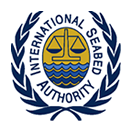 Polymetallic nodules or manganese crusts are rock concretions that form at the seabed and contain many valuable metals like iron, manganese, nickel, copper and cobalt. Such metals are also found in sulphide deposit, accumulations of sulphur minerals which form near volcanic vents at the seabed. This map shows the presence of these deep-sea mineral resources in different sampling locations.
Polymetallic nodules or manganese crusts are rock concretions that form at the seabed and contain many valuable metals like iron, manganese, nickel, copper and cobalt. Such metals are also found in sulphide deposit, accumulations of sulphur minerals which form near volcanic vents at the seabed. This map shows the presence of these deep-sea mineral resources in different sampling locations.Dredging areas
 Dredging is an excavation activity usually carried out underwater, in shallow seas or freshwater areas with the purpose of gathering and relocating bottom sediments to widen and/or deepen harbours and shipping lanes, reshape the coastline or protect against erosion and flooding. This map shows the locations where dredging activities are taking place as well as their purpose. The information is the result of the aggregation and harmonisation of datasets provided by several sources from all across the EU.
Dredging is an excavation activity usually carried out underwater, in shallow seas or freshwater areas with the purpose of gathering and relocating bottom sediments to widen and/or deepen harbours and shipping lanes, reshape the coastline or protect against erosion and flooding. This map shows the locations where dredging activities are taking place as well as their purpose. The information is the result of the aggregation and harmonisation of datasets provided by several sources from all across the EU.Hydrocarbon reservoir
 Hydrocarbons like petroleum, natural gas, coal and bitumen are the primary energy source in our current society. They are formed by the degradation of organic material over millions of years in thick sedimentary sequences, called hydrocarbon reservoirs, deep beneath the earth’s surface. These reservoirs are largely confined to the continental shelves, continental slopes, continental rises, and small ocean basins. This map shows the location and extent of hydrocarbon reservoirs in the European marine region.
Hydrocarbons like petroleum, natural gas, coal and bitumen are the primary energy source in our current society. They are formed by the degradation of organic material over millions of years in thick sedimentary sequences, called hydrocarbon reservoirs, deep beneath the earth’s surface. These reservoirs are largely confined to the continental shelves, continental slopes, continental rises, and small ocean basins. This map shows the location and extent of hydrocarbon reservoirs in the European marine region.Marine sediment extraction
 Sediments at the seafloor like sand and gravel are useful construction materials. Furthermore, they can be used to restore beaches and protect against coastal erosion. This map shows the location where marine sediments are extracted as well as the end use of the extracted material. The information is the result of the aggregation and harmonisation of datasets provided by several EU and non-EU sources and is updated every year.
Sediments at the seafloor like sand and gravel are useful construction materials. Furthermore, they can be used to restore beaches and protect against coastal erosion. This map shows the location where marine sediments are extracted as well as the end use of the extracted material. The information is the result of the aggregation and harmonisation of datasets provided by several EU and non-EU sources and is updated every year.Mean underwater depth
 This map shows the bathymetry, the average depth of the water column, in the European region with a resolution of 1/16 - arc minute (~ 115 meter), as well as the topography of the land or terrestrial areas. The bathymetric map was derived from individual bathymetric surveys and composite Digital Terrain Data/Models (cDTM).
This map shows the bathymetry, the average depth of the water column, in the European region with a resolution of 1/16 - arc minute (~ 115 meter), as well as the topography of the land or terrestrial areas. The bathymetric map was derived from individual bathymetric surveys and composite Digital Terrain Data/Models (cDTM).Offshore hydrocarbon extraction boreholes
 Hydrocarbons like petroleum and natural gas are a primary energy source for current society. These hydrocarbons are extracted from sediment layers deep beneath the seabed or the land surface by drilling boreholes. This map shows the location and operational status of offshore hydrocarbon extraction boreholes in the European region. The information is the result of the aggregation and harmonisation of datasets provided by several sources from all across the EU as well as Norway, the UK and Montenegro and is updated every year.
Hydrocarbons like petroleum and natural gas are a primary energy source for current society. These hydrocarbons are extracted from sediment layers deep beneath the seabed or the land surface by drilling boreholes. This map shows the location and operational status of offshore hydrocarbon extraction boreholes in the European region. The information is the result of the aggregation and harmonisation of datasets provided by several sources from all across the EU as well as Norway, the UK and Montenegro and is updated every year.Seabed sediment accumulation rates
 Sediments are accumulations of particles like gravel, sand and clay as well as shells and other biological material. The rate at which these sediments accumulate at the seabed ranges widely depending on the location, being highest near river mouths and lowest at the deep ocean floor.This map shows the seabed sediment accumulation rates at different locations in the European marine region. The rates were determined by dating of the sediment or estimated from acoustic-seismic and sediment core data.
Sediments are accumulations of particles like gravel, sand and clay as well as shells and other biological material. The rate at which these sediments accumulate at the seabed ranges widely depending on the location, being highest near river mouths and lowest at the deep ocean floor.This map shows the seabed sediment accumulation rates at different locations in the European marine region. The rates were determined by dating of the sediment or estimated from acoustic-seismic and sediment core data.Seabed sediments
 Sediments are accumulations of particles like gravel, sand and clay as well as shells, nodules and other biological material. When these sediments become buried and compacted, they form sedimentary rocks. This map shows the characteristics of the sediment at the seabed in different sampling locations.
Sediments are accumulations of particles like gravel, sand and clay as well as shells, nodules and other biological material. When these sediments become buried and compacted, they form sedimentary rocks. This map shows the characteristics of the sediment at the seabed in different sampling locations.Seabed substrates
 Sediments are accumulations of particles like gravel, sand and mud. When these sediments become buried and compacted, they form sedimentary rocks. The type of sediment that covers the seafloor is called the seabed substrate. This map shows the seabed substrate of the European marine region at 1: 250 000 scale and includes five seabed substrate classes defined according to the Folk classification scheme as well as an additional class for rock and boulders.
Sediments are accumulations of particles like gravel, sand and mud. When these sediments become buried and compacted, they form sedimentary rocks. The type of sediment that covers the seafloor is called the seabed substrate. This map shows the seabed substrate of the European marine region at 1: 250 000 scale and includes five seabed substrate classes defined according to the Folk classification scheme as well as an additional class for rock and boulders.Seafloor lithology
 The lithology of a rock unit is a description of its physical characteristics such as colour, texture, grain size, or mineral composition. It may be either a detailed description of these characteristics or be a summary of the gross physical character of a rock. This map shows the lithology of the rock layers at the seafloor in the European marine region.
The lithology of a rock unit is a description of its physical characteristics such as colour, texture, grain size, or mineral composition. It may be either a detailed description of these characteristics or be a summary of the gross physical character of a rock. This map shows the lithology of the rock layers at the seafloor in the European marine region.Seafloor stratigraphy
 Stratigraphy is the description of the successions of rock layers (strata) that have accumulated through time. Based on the stratigraphy of the earth, geologists have subdivided its history in a system of hierarchical time periods known as the Geological Time Scale. This map shows the geological age of the rock layers at the seafloor in the European marine region.
Stratigraphy is the description of the successions of rock layers (strata) that have accumulated through time. Based on the stratigraphy of the earth, geologists have subdivided its history in a system of hierarchical time periods known as the Geological Time Scale. This map shows the geological age of the rock layers at the seafloor in the European marine region.Submarine fluid emissions
 The sediment and rock layers below the seafloor contain water but also other fluids like petroleum, methane, carbon dioxide and gasses that result from the degradation of organic material. These so-called submarine fluids are under high pressure, causing them to migrate to the seafloor along faults and fissures. When the fluids reach the seafloor, they leak into the water column in a process termed fluid emission. If sediments are mixed in with these fluids it forms a high-pressure mud which can erupt at the seafloor creating a mud-volcano. This map shows the location of these fluid emission sites and mud volcanoes of non-volcanic origin.The information was collected by various national and regional mapping projects and compiled from the literature.
The sediment and rock layers below the seafloor contain water but also other fluids like petroleum, methane, carbon dioxide and gasses that result from the degradation of organic material. These so-called submarine fluids are under high pressure, causing them to migrate to the seafloor along faults and fissures. When the fluids reach the seafloor, they leak into the water column in a process termed fluid emission. If sediments are mixed in with these fluids it forms a high-pressure mud which can erupt at the seafloor creating a mud-volcano. This map shows the location of these fluid emission sites and mud volcanoes of non-volcanic origin.The information was collected by various national and regional mapping projects and compiled from the literature. Submarine landslides
 Landslides are ground movements such as rock falls, avalanches, deep failures of slopes, and shallow debris flows. They can also occur underwater, in which case they are called submarine landslides. This map shows the different kinds of submarine landslides found on or buried below the seabed and in outcrop. The information was collected by various national and regional mapping projects and compiled from the literature.
Landslides are ground movements such as rock falls, avalanches, deep failures of slopes, and shallow debris flows. They can also occur underwater, in which case they are called submarine landslides. This map shows the different kinds of submarine landslides found on or buried below the seabed and in outcrop. The information was collected by various national and regional mapping projects and compiled from the literature.Submarine volcanoes
 Submarine volcanoes are underwater vents or fissures in the earth's surface from which magma can erupt. A large number of submarine volcanoes are located near areas of tectonic plate movement. Although most submarine volcanoes are located in the depths of seas and oceans, some also exist in shallow water, and these can discharge material into the atmosphere during an eruption. This map shows the location and morphology of the submarine volcanoes in the European marine region.
Submarine volcanoes are underwater vents or fissures in the earth's surface from which magma can erupt. A large number of submarine volcanoes are located near areas of tectonic plate movement. Although most submarine volcanoes are located in the depths of seas and oceans, some also exist in shallow water, and these can discharge material into the atmosphere during an eruption. This map shows the location and morphology of the submarine volcanoes in the European marine region.Submerged landscapes
 In the past, repeated ice ages caused sea level to fluctuate by more than 100 m. As a result, many of the ancient landscapes, home to our human ancestors, have become submerged and hidden from view. This map shows the known topographic and archaeological features of these submerged landscapes in Europe. The information was collected by EMODnet geology, building on the work of many other projects like SPLASHCOS, SASMAP and MEDFLOOD.
In the past, repeated ice ages caused sea level to fluctuate by more than 100 m. As a result, many of the ancient landscapes, home to our human ancestors, have become submerged and hidden from view. This map shows the known topographic and archaeological features of these submerged landscapes in Europe. The information was collected by EMODnet geology, building on the work of many other projects like SPLASHCOS, SASMAP and MEDFLOOD.Tectonic lines
 Tectonics describe the structure and movement of the earth’s crust and explains many geological processes like mountain building, volcanism and earthquakes. Fault lines are cracks that divide parts of the crust moving with respect to each other. This map shows the fault lines in the European marine region.
Tectonics describe the structure and movement of the earth’s crust and explains many geological processes like mountain building, volcanism and earthquakes. Fault lines are cracks that divide parts of the crust moving with respect to each other. This map shows the fault lines in the European marine region.Underwater depth contours
 Contour lines or isobaths (i.e. imaginary lines on a map connecting all points having the same depth below the water surface) are based on the average underwater depth, which is the underwater equivalent to topography. This map shows the contour lines for the following depths: 50, 100, 200, 500, 1000, 2000, and 5000 meters.
Contour lines or isobaths (i.e. imaginary lines on a map connecting all points having the same depth below the water surface) are based on the average underwater depth, which is the underwater equivalent to topography. This map shows the contour lines for the following depths: 50, 100, 200, 500, 1000, 2000, and 5000 meters.Sea life
Marine bird observations
 This map shows the marine bird observations available in the European Ocean Biodiversity Information System (EurOBIS) database. The European node of the international Ocean Biodiversity Information System (OBIS) publishes distribution data on marine species, collected within European marine waters or collected by European researchers outside European marine waters.
This map shows the marine bird observations available in the European Ocean Biodiversity Information System (EurOBIS) database. The European node of the international Ocean Biodiversity Information System (OBIS) publishes distribution data on marine species, collected within European marine waters or collected by European researchers outside European marine waters.Marine species observed per sea region
 This map shows the number of species and observations per sea region based on the information collected by the European Ocean Biogeographic Information System (EurOBIS). The European node of the international Ocean Biogeographic Information System (OBIS) publishes distribution data on marine species, collected within European marine waters or collected by European researchers outside European marine waters.
This map shows the number of species and observations per sea region based on the information collected by the European Ocean Biogeographic Information System (EurOBIS). The European node of the international Ocean Biogeographic Information System (OBIS) publishes distribution data on marine species, collected within European marine waters or collected by European researchers outside European marine waters.Zooplankton (Acartia) abundance in winter
 This map shows the abundance of Acartia, a copepod (zooplankton) species, across European waters in the winter. Data on abundance have been collected with the Continuous Plankton Recorder (CPR). A 'copepod' is a type of zooplankton, a planktonic crustacean distantly related to shrimp and crabs. These tiny Crustaceans are usually the dominant members of the zooplankton, and are major food organisms for small fish.
This map shows the abundance of Acartia, a copepod (zooplankton) species, across European waters in the winter. Data on abundance have been collected with the Continuous Plankton Recorder (CPR). A 'copepod' is a type of zooplankton, a planktonic crustacean distantly related to shrimp and crabs. These tiny Crustaceans are usually the dominant members of the zooplankton, and are major food organisms for small fish.Zooplankton (Acartia) abundances in autumn
 This map shows the abundance of Acartia, a copepod (zooplankton) species, across European waters in autumn. Data on abundance have been collected with the Continuous Plankton Recorder (CPR). A 'copepod' is a type of zooplankton, a planktonic crustacean distantly related to shrimp and crabs. These tiny Crustaceans are usually the dominant members of the zooplankton, and are major food organisms for small fish.
This map shows the abundance of Acartia, a copepod (zooplankton) species, across European waters in autumn. Data on abundance have been collected with the Continuous Plankton Recorder (CPR). A 'copepod' is a type of zooplankton, a planktonic crustacean distantly related to shrimp and crabs. These tiny Crustaceans are usually the dominant members of the zooplankton, and are major food organisms for small fish.Zooplankton (Acartia) abundances in spring
 This map shows the abundance of Acartia, a copepod (zooplankton) species, across European waters in Spring. Data on abundance have been collected with the Continuous Plankton Recorder (CPR). A 'copepod' is a type of zooplankton, a planktonic crustacean distantly related to shrimp and crabs. These tiny Crustaceans are usually the dominant members of the zooplankton, and are major food organisms for small fish.
This map shows the abundance of Acartia, a copepod (zooplankton) species, across European waters in Spring. Data on abundance have been collected with the Continuous Plankton Recorder (CPR). A 'copepod' is a type of zooplankton, a planktonic crustacean distantly related to shrimp and crabs. These tiny Crustaceans are usually the dominant members of the zooplankton, and are major food organisms for small fish.Zooplankton (Acartia) abundances in summer
 This map shows the abundance of Acartia, a copepod (zooplankton) species, across European waters in the summer. Data on abundance have been collected with the Continuous Plankton Recorder (CPR). A 'copepod' is a type of zooplankton, a planktonic crustacean distantly related to shrimp and crabs. These tiny Crustaceans are usually the dominant members of the zooplankton, and are major food organisms for small fish.
This map shows the abundance of Acartia, a copepod (zooplankton) species, across European waters in the summer. Data on abundance have been collected with the Continuous Plankton Recorder (CPR). A 'copepod' is a type of zooplankton, a planktonic crustacean distantly related to shrimp and crabs. These tiny Crustaceans are usually the dominant members of the zooplankton, and are major food organisms for small fish.Zooplankton (Calanus finmarchicus) abundance in autumn
 This map shows the abundance of Calanus finmarchicus, a copepod (zooplankton) species, across European waters in autumn. Data on abundance have been collected with the Continuous Plankton Recorder (CPR). A 'copepod' is a type of zooplankton, a planktonic crustacean distantly related to shrimp and crabs. These tiny Crustaceans are usually the dominant members of the zooplankton, and are major food organisms for small fish.
This map shows the abundance of Calanus finmarchicus, a copepod (zooplankton) species, across European waters in autumn. Data on abundance have been collected with the Continuous Plankton Recorder (CPR). A 'copepod' is a type of zooplankton, a planktonic crustacean distantly related to shrimp and crabs. These tiny Crustaceans are usually the dominant members of the zooplankton, and are major food organisms for small fish.Zooplankton (Calanus finmarchicus) abundance in spring
 This map shows the abundance of Calanus finmarchicus, a copepod (zooplankton) species, across European waters in spring. Data on abundance have been collected with the Continuous Plankton Recorder (CPR). A 'copepod' is a type of zooplankton, a planktonic crustacean distantly related to shrimp and crabs. These tiny Crustaceans are usually the dominant members of the zooplankton, and are major food organisms for small fish.
This map shows the abundance of Calanus finmarchicus, a copepod (zooplankton) species, across European waters in spring. Data on abundance have been collected with the Continuous Plankton Recorder (CPR). A 'copepod' is a type of zooplankton, a planktonic crustacean distantly related to shrimp and crabs. These tiny Crustaceans are usually the dominant members of the zooplankton, and are major food organisms for small fish.Zooplankton (Calanus finmarchicus) abundance in summer
 This map shows the abundance of Calanus finmarchicus, a copepod (zooplankton) species, across European waters in the summer. Data on abundance have been collected with the Continuous Plankton Recorder (CPR). A 'copepod' is a type of zooplankton, a planktonic crustacean distantly related to shrimp and crabs. These tiny Crustaceans are usually the dominant members of the zooplankton, and are major food organisms for small fish.
This map shows the abundance of Calanus finmarchicus, a copepod (zooplankton) species, across European waters in the summer. Data on abundance have been collected with the Continuous Plankton Recorder (CPR). A 'copepod' is a type of zooplankton, a planktonic crustacean distantly related to shrimp and crabs. These tiny Crustaceans are usually the dominant members of the zooplankton, and are major food organisms for small fish.Zooplankton (Calanus finmarchicus) abundance in winter
 This map shows the abundance of Calanus finmarchicus, a copepod (zooplankton) species, across European waters in the winter. Data on abundance have been collected with the Continuous Plankton Recorder (CPR). A 'copepod' is a type of zooplankton, a planktonic crustacean distantly related to shrimp and crabs. These tiny Crustaceans are usually the dominant members of the zooplankton, and are major food organisms for small fish.
This map shows the abundance of Calanus finmarchicus, a copepod (zooplankton) species, across European waters in the winter. Data on abundance have been collected with the Continuous Plankton Recorder (CPR). A 'copepod' is a type of zooplankton, a planktonic crustacean distantly related to shrimp and crabs. These tiny Crustaceans are usually the dominant members of the zooplankton, and are major food organisms for small fish.Zooplankton (Temora longicornis) abundance in autumn
 This map shows the abundance of Temora longicornis, a copepod (zooplankton) species, across European waters in Autumn. Data on abundance have been collected with the Continuous Plankton Recorder (CPR). A 'copepod' is a type of zooplankton, a planktonic crustacean distantly related to shrimp and crabs. These tiny Crustaceans are usually the dominant members of the zooplankton, and are major food organisms for small fish.
This map shows the abundance of Temora longicornis, a copepod (zooplankton) species, across European waters in Autumn. Data on abundance have been collected with the Continuous Plankton Recorder (CPR). A 'copepod' is a type of zooplankton, a planktonic crustacean distantly related to shrimp and crabs. These tiny Crustaceans are usually the dominant members of the zooplankton, and are major food organisms for small fish.Zooplankton (Temora longicornis) abundance in spring
 This map shows the abundance of Temora longicornis, a copepod (zooplankton) species, across European waters in spring. Data on abundance have been collected with the Continuous Plankton Recorder (CPR). A 'copepod' is a type of zooplankton, a planktonic crustacean distantly related to shrimp and crabs. These tiny Crustaceans are usually the dominant members of the zooplankton, and are major food organisms for small fish.
This map shows the abundance of Temora longicornis, a copepod (zooplankton) species, across European waters in spring. Data on abundance have been collected with the Continuous Plankton Recorder (CPR). A 'copepod' is a type of zooplankton, a planktonic crustacean distantly related to shrimp and crabs. These tiny Crustaceans are usually the dominant members of the zooplankton, and are major food organisms for small fish.Zooplankton (Temora longicornis) abundance in summer
 This map shows the abundance of Temora longicornis, a copepod (zooplankton) species, across European waters in the summer. Data on abundance have been collected with the Continuous Plankton Recorder (CPR). A 'copepod' is a type of zooplankton, a planktonic crustacean distantly related to shrimp and crabs. These tiny Crustaceans are usually the dominant members of the zooplankton, and are major food organisms for small fish.
This map shows the abundance of Temora longicornis, a copepod (zooplankton) species, across European waters in the summer. Data on abundance have been collected with the Continuous Plankton Recorder (CPR). A 'copepod' is a type of zooplankton, a planktonic crustacean distantly related to shrimp and crabs. These tiny Crustaceans are usually the dominant members of the zooplankton, and are major food organisms for small fish.Zooplankton (Temora longicornis) abundance in winter
 This map shows the abundance of Temora longicornis, a copepod (zooplankton) species, across European waters in the winter. Data on abundance have been collected with the Continuous Plankton Recorder (CPR). A 'copepod' is a type of zooplankton, a planktonic crustacean distantly related to shrimp and crabs. These tiny Crustaceans are usually the dominant members of the zooplankton, and are major food organisms for small fish.
This map shows the abundance of Temora longicornis, a copepod (zooplankton) species, across European waters in the winter. Data on abundance have been collected with the Continuous Plankton Recorder (CPR). A 'copepod' is a type of zooplankton, a planktonic crustacean distantly related to shrimp and crabs. These tiny Crustaceans are usually the dominant members of the zooplankton, and are major food organisms for small fish.Seabed habitats
Coralligenous Habitats
 This map shows modelled spatial distributions of coralligenous outcrops and mäerl beds across the Mediterranean Sea. These bioconstructions are typical Mediterranean underwater seascapes, comprising coralline algal frameworks that grow in dim light conditions. They are the result of the building activities of algal and animal constructors, counterbalanced by physical, as well as biological, eroding processes. Because of their extent, biodiversity and production, coralligenous and mäerl habitats rank among the most important ecosystems in the Mediterranean Sea, and they are considered of great significance both for fisheries and natural carbon sequestration.
This map shows modelled spatial distributions of coralligenous outcrops and mäerl beds across the Mediterranean Sea. These bioconstructions are typical Mediterranean underwater seascapes, comprising coralline algal frameworks that grow in dim light conditions. They are the result of the building activities of algal and animal constructors, counterbalanced by physical, as well as biological, eroding processes. Because of their extent, biodiversity and production, coralligenous and mäerl habitats rank among the most important ecosystems in the Mediterranean Sea, and they are considered of great significance both for fisheries and natural carbon sequestration.Habitat Descriptors - Biological zones
 This maps shows the classified biological zones for all European waters used in the EMODnet broad-scale seabed habitat model (EUSeaMap) . It is one of the several habitat descriptors used to determine the final habitat type. Biological zones are determined using a variety of physical variables and proxies.
This maps shows the classified biological zones for all European waters used in the EMODnet broad-scale seabed habitat model (EUSeaMap) . It is one of the several habitat descriptors used to determine the final habitat type. Biological zones are determined using a variety of physical variables and proxies.Habitat classification by EUNIS 2019
 This map shows predictive EUNIS seabed habitat map for the European seas. The map follows the EUNIS 2007-11-classification system where applicable, and uses the most detailed classifications predicted by the model. The EUNIS habitat classification is a comprehensive pan-European system to facilitate the harmonised description and collection of data across Europe through the use of criteria for habitat identification. The classification has been enriched by additional habitats where no appropriate EUNIS habitat exists or where data are lacking. The model includes the sublittoral zone only; due to the high variability of the littoral zone, a lack of detailed substrate data and the resolution of the model, it is difficult to predict littoral habitats at this scale.
This map shows predictive EUNIS seabed habitat map for the European seas. The map follows the EUNIS 2007-11-classification system where applicable, and uses the most detailed classifications predicted by the model. The EUNIS habitat classification is a comprehensive pan-European system to facilitate the harmonised description and collection of data across Europe through the use of criteria for habitat identification. The classification has been enriched by additional habitats where no appropriate EUNIS habitat exists or where data are lacking. The model includes the sublittoral zone only; due to the high variability of the littoral zone, a lack of detailed substrate data and the resolution of the model, it is difficult to predict littoral habitats at this scale.Maerl Habitats
 This map shows modelled spatial distributions of mäerl beds across the Mediterranean Sea. These bioconstructions are typical Mediterranean underwater seascapes, comprising coralline algal frameworks that grow in dim light conditions. They are the result of the building activities of algal and animal constructors, counterbalanced by physical, as well as biological, eroding processes. Because of their extent, biodiversity and production, mäerl habitats rank among the most important ecosystems in the Mediterranean Sea, and they are considered of great significance both for fisheries and carbon regulation.
This map shows modelled spatial distributions of mäerl beds across the Mediterranean Sea. These bioconstructions are typical Mediterranean underwater seascapes, comprising coralline algal frameworks that grow in dim light conditions. They are the result of the building activities of algal and animal constructors, counterbalanced by physical, as well as biological, eroding processes. Because of their extent, biodiversity and production, mäerl habitats rank among the most important ecosystems in the Mediterranean Sea, and they are considered of great significance both for fisheries and carbon regulation.Posidonia oceanica distribution (seagrass species)
 This map presents the distribution of Posidonia oceanica (commonly known as Neptune grass or Mediterranean tape weed), a seagrass species that is endemic to the Mediterranean Sea. It forms large underwater meadows that are an important part of the ecosystem. The fruit is free floating and known in Italy as 'the olive of the sea' (l'oliva di mare). Balls of fibrous material from its foliage, known as egagropili, wash up to nearby shorelines.
This map presents the distribution of Posidonia oceanica (commonly known as Neptune grass or Mediterranean tape weed), a seagrass species that is endemic to the Mediterranean Sea. It forms large underwater meadows that are an important part of the ecosystem. The fruit is free floating and known in Italy as 'the olive of the sea' (l'oliva di mare). Balls of fibrous material from its foliage, known as egagropili, wash up to nearby shorelines.Predicted climate change impact on the American plaice habitat
 Climate change is predicted to have far-reaching consequences for the deep-sea environment like seawater acidification, warming, loss of oxygen and decreased food availability at the seafloor. These changes are projected to threaten many commercial deep-sea fishes, cold-water coral reefs and the ecosystem services they provide. The map shows the predicted loss, preservation (refugia) and gain in habitat for the American plaice (Hippoglossoides platessoides) in the future (2081-2100) under a business-as-usual climate change scenario. The study providing these data is part of the Horizon 2020 ATLAS project, a transatlantic assessment and deep-water ecosystem-based spatial management plan for Europe.
Climate change is predicted to have far-reaching consequences for the deep-sea environment like seawater acidification, warming, loss of oxygen and decreased food availability at the seafloor. These changes are projected to threaten many commercial deep-sea fishes, cold-water coral reefs and the ecosystem services they provide. The map shows the predicted loss, preservation (refugia) and gain in habitat for the American plaice (Hippoglossoides platessoides) in the future (2081-2100) under a business-as-usual climate change scenario. The study providing these data is part of the Horizon 2020 ATLAS project, a transatlantic assessment and deep-water ecosystem-based spatial management plan for Europe.Predicted climate change impact on the Atlantic cod habitat
 Climate change is predicted to have far-reaching consequences for the deep-sea environment like seawater acidification, warming, loss of oxygen and decreased food availability at the seafloor. These changes are projected to threaten many commercial deep-sea fishes, cold-water coral reefs and the ecosystem services they provide. The map shows the predicted loss, preservation (refugia) and gain in habitat for the Atlantic cod (Gadus morhua) in the future (2081-2100) under a business-as-usual climate change scenario. The study providing these data is part of the Horizon 2020 ATLAS project, a transatlantic assessment and deep-water ecosystem-based spatial management plan for Europe.
Climate change is predicted to have far-reaching consequences for the deep-sea environment like seawater acidification, warming, loss of oxygen and decreased food availability at the seafloor. These changes are projected to threaten many commercial deep-sea fishes, cold-water coral reefs and the ecosystem services they provide. The map shows the predicted loss, preservation (refugia) and gain in habitat for the Atlantic cod (Gadus morhua) in the future (2081-2100) under a business-as-usual climate change scenario. The study providing these data is part of the Horizon 2020 ATLAS project, a transatlantic assessment and deep-water ecosystem-based spatial management plan for Europe.Predicted climate change impact on the Greenland halibut habitat
 Climate change is predicted to have far-reaching consequences for the deep-sea environment like seawater acidification, warming, loss of oxygen and decreased food availability at the seafloor. These changes are projected to threaten many commercial deep-sea fishes, cold-water coral reefs and the ecosystem services they provide. The map shows the predicted loss, preservation (refugia) and gain in habitat for the Greenland halibut (Reinhardtius hippoglossoides) in the future (2081-2100) under a business-as-usual climate change scenario. The study providing these data is part of the Horizon 2020 ATLAS project, a transatlantic assessment and deep-water ecosystem-based spatial management plan for Europe.
Climate change is predicted to have far-reaching consequences for the deep-sea environment like seawater acidification, warming, loss of oxygen and decreased food availability at the seafloor. These changes are projected to threaten many commercial deep-sea fishes, cold-water coral reefs and the ecosystem services they provide. The map shows the predicted loss, preservation (refugia) and gain in habitat for the Greenland halibut (Reinhardtius hippoglossoides) in the future (2081-2100) under a business-as-usual climate change scenario. The study providing these data is part of the Horizon 2020 ATLAS project, a transatlantic assessment and deep-water ecosystem-based spatial management plan for Europe.Predicted climate change impact on the armoured sea fan coral habitat
 Climate change is predicted to have far-reaching consequences for the deep-sea environment like seawater acidification, warming, loss of oxygen and decreased food availability at the seafloor. These changes are projected to threaten many commercial deep-sea fishes, cold-water coral reefs and the ecosystem services they provide. The map shows the predicted loss, preservation (refugia) and gain in habitat for the armoured sea fan coral (Acanthogorgia armata) in the future (2081-2100) under a business-as-usual climate change scenario. The study providing these data is part of the Horizon 2020 ATLAS project, a transatlantic assessment and deep-water ecosystem-based spatial management plan for Europe.
Climate change is predicted to have far-reaching consequences for the deep-sea environment like seawater acidification, warming, loss of oxygen and decreased food availability at the seafloor. These changes are projected to threaten many commercial deep-sea fishes, cold-water coral reefs and the ecosystem services they provide. The map shows the predicted loss, preservation (refugia) and gain in habitat for the armoured sea fan coral (Acanthogorgia armata) in the future (2081-2100) under a business-as-usual climate change scenario. The study providing these data is part of the Horizon 2020 ATLAS project, a transatlantic assessment and deep-water ecosystem-based spatial management plan for Europe.Predicted climate change impact on the blackbelly rosefish habitat
 Climate change is predicted to have far-reaching consequences for the deep-sea environment like seawater acidification, warming, loss of oxygen and decreased food availability at the seafloor. These changes are projected to threaten many commercial deep-sea fishes, cold-water coral reefs and the ecosystem services they provide. The map shows the predicted loss, preservation (refugia) and gain in habitat for the blackbelly rosefish (Helicolenus dactylopterus) in the future (2081-2100) under a business-as-usual climate change scenario. The study providing these data is part of the Horizon 2020 ATLAS project, a transatlantic assessment and deep-water ecosystem-based spatial management plan for Europe.
Climate change is predicted to have far-reaching consequences for the deep-sea environment like seawater acidification, warming, loss of oxygen and decreased food availability at the seafloor. These changes are projected to threaten many commercial deep-sea fishes, cold-water coral reefs and the ecosystem services they provide. The map shows the predicted loss, preservation (refugia) and gain in habitat for the blackbelly rosefish (Helicolenus dactylopterus) in the future (2081-2100) under a business-as-usual climate change scenario. The study providing these data is part of the Horizon 2020 ATLAS project, a transatlantic assessment and deep-water ecosystem-based spatial management plan for Europe.Predicted climate change impact on the bonsai bamboo coral habitat
 Climate change is predicted to have far-reaching consequences for the deep-sea environment like seawater acidification, warming, loss of oxygen and decreased food availability at the seafloor. These changes are projected to threaten many commercial deep-sea fishes, cold-water coral reefs and the ecosystem services they provide. The map shows the predicted loss, preservation (refugia) and gain in habitat for the bonsai bamboo coral (Acanella arbuscula) in the future (2081-2100) under a business-as-usual climate change scenario. The study providing these data is part of the Horizon 2020 ATLAS project, a transatlantic assessment and deep-water ecosystem-based spatial management plan for Europe
Climate change is predicted to have far-reaching consequences for the deep-sea environment like seawater acidification, warming, loss of oxygen and decreased food availability at the seafloor. These changes are projected to threaten many commercial deep-sea fishes, cold-water coral reefs and the ecosystem services they provide. The map shows the predicted loss, preservation (refugia) and gain in habitat for the bonsai bamboo coral (Acanella arbuscula) in the future (2081-2100) under a business-as-usual climate change scenario. The study providing these data is part of the Horizon 2020 ATLAS project, a transatlantic assessment and deep-water ecosystem-based spatial management plan for EuropePredicted climate change impact on the bubblegum coral habitat
 Climate change is predicted to have far-reaching consequences for the deep-sea environment like seawater acidification, warming, loss of oxygen and decreased food availability at the seafloor. These changes are projected to threaten many commercial deep-sea fishes, cold-water coral reefs and the ecosystem services they provide. The map shows the predicted loss, preservation (refugia) and gain in habitat for the bubblegum coral (Paragorgia arborea) in the future (2081-2100) under a business-as-usual climate change scenario. The study providing these data is part of the Horizon 2020 ATLAS project, a transatlantic assessment and deep-water ecosystem-based spatial management plan for Europe.
Climate change is predicted to have far-reaching consequences for the deep-sea environment like seawater acidification, warming, loss of oxygen and decreased food availability at the seafloor. These changes are projected to threaten many commercial deep-sea fishes, cold-water coral reefs and the ecosystem services they provide. The map shows the predicted loss, preservation (refugia) and gain in habitat for the bubblegum coral (Paragorgia arborea) in the future (2081-2100) under a business-as-usual climate change scenario. The study providing these data is part of the Horizon 2020 ATLAS project, a transatlantic assessment and deep-water ecosystem-based spatial management plan for Europe.Predicted climate change impact on the cockscomb cup coral habitat
 Climate change is predicted to have far-reaching consequences for the deep-sea environment like seawater acidification, warming, loss of oxygen and decreased food availability at the seafloor. These changes are projected to threaten many commercial deep-sea fishes, cold-water coral reefs and the ecosystem services they provide. The map shows the predicted loss, preservation (refugia) and gain in habitat for the cockscomb cup coral (Desmophyllum dianthus) in the future (2081-2100) under a business-as-usual climate change scenario. The study providing these data is part of the Horizon 2020 ATLAS project, a transatlantic assessment and deep-water ecosystem-based spatial management plan for Europe.
Climate change is predicted to have far-reaching consequences for the deep-sea environment like seawater acidification, warming, loss of oxygen and decreased food availability at the seafloor. These changes are projected to threaten many commercial deep-sea fishes, cold-water coral reefs and the ecosystem services they provide. The map shows the predicted loss, preservation (refugia) and gain in habitat for the cockscomb cup coral (Desmophyllum dianthus) in the future (2081-2100) under a business-as-usual climate change scenario. The study providing these data is part of the Horizon 2020 ATLAS project, a transatlantic assessment and deep-water ecosystem-based spatial management plan for Europe.Predicted climate change impact on the deepwater redfish habitat
 Climate change is predicted to have far-reaching consequences for the deep-sea environment like seawater acidification, warming, loss of oxygen and decreased food availability at the seafloor. These changes are projected to threaten many commercial deep-sea fishes, cold-water coral reefs and the ecosystem services they provide. The map shows the predicted loss, preservation (refugia) and gain in habitat for the deepwater redfish (Sebastes mentella) in the future (2081-2100) under a business-as-usual climate change scenario. The study providing these data is part of the Horizon 2020 ATLAS project, a transatlantic assessment and deep-water ecosystem-based spatial management plan for Europe.
Climate change is predicted to have far-reaching consequences for the deep-sea environment like seawater acidification, warming, loss of oxygen and decreased food availability at the seafloor. These changes are projected to threaten many commercial deep-sea fishes, cold-water coral reefs and the ecosystem services they provide. The map shows the predicted loss, preservation (refugia) and gain in habitat for the deepwater redfish (Sebastes mentella) in the future (2081-2100) under a business-as-usual climate change scenario. The study providing these data is part of the Horizon 2020 ATLAS project, a transatlantic assessment and deep-water ecosystem-based spatial management plan for Europe.Predicted climate change impact on the rock grenadier fish habitat
 Climate change is predicted to have far-reaching consequences for the deep-sea environment like seawater acidification, warming, loss of oxygen and decreased food availability at the seafloor. These changes are projected to threaten many commercial deep-sea fishes, cold-water coral reefs and the ecosystem services they provide. The map shows the predicted loss, preservation (refugia) and gain in habitat for the rock grenadier fish (Coryphaenoides rupestris) in the future (2081-2100) under a business-as-usual climate change scenario. The study providing these data is part of the Horizon 2020 ATLAS project, a transatlantic assessment and deep-water ecosystem-based spatial management plan for Europe.
Climate change is predicted to have far-reaching consequences for the deep-sea environment like seawater acidification, warming, loss of oxygen and decreased food availability at the seafloor. These changes are projected to threaten many commercial deep-sea fishes, cold-water coral reefs and the ecosystem services they provide. The map shows the predicted loss, preservation (refugia) and gain in habitat for the rock grenadier fish (Coryphaenoides rupestris) in the future (2081-2100) under a business-as-usual climate change scenario. The study providing these data is part of the Horizon 2020 ATLAS project, a transatlantic assessment and deep-water ecosystem-based spatial management plan for Europe.Predicted climate change impact on the white coral habitat
 Climate change is predicted to have far-reaching consequences for the deep-sea environment like seawater acidification, warming, loss of oxygen and decreased food availability at the seafloor. These changes are projected to threaten many commercial deep-sea fishes, cold-water coral reefs and the ecosystem services they provide. The map shows the predicted loss, preservation (refugia) and gain in habitat for the white coral (Madrepora oculata) in the future (2081-2100) under a business-as-usual climate change scenario. The study providing these data is part of the Horizon 2020 ATLAS project, a transatlantic assessment and deep-water ecosystem-based spatial management plan for Europe.
Climate change is predicted to have far-reaching consequences for the deep-sea environment like seawater acidification, warming, loss of oxygen and decreased food availability at the seafloor. These changes are projected to threaten many commercial deep-sea fishes, cold-water coral reefs and the ecosystem services they provide. The map shows the predicted loss, preservation (refugia) and gain in habitat for the white coral (Madrepora oculata) in the future (2081-2100) under a business-as-usual climate change scenario. The study providing these data is part of the Horizon 2020 ATLAS project, a transatlantic assessment and deep-water ecosystem-based spatial management plan for Europe.Predicted climate change impact on the white stony coral habitat
 Climate change is predicted to have far-reaching consequences for the deep-sea environment like seawater acidification, warming, loss of oxygen and decreased food availability at the seafloor. These changes are projected to threaten many commercial deep-sea fishes, cold-water coral reefs and the ecosystem services they provide. The map shows the predicted loss, preservation (refugia) and gain in habitat for the white stony coral (Lophelia pertusa) in the future (2081-2100) under a business-as-usual climate change scenario. The study providing these data is part of the Horizon 2020 ATLAS project, a transatlantic assessment and deep-water ecosystem-based spatial management plan for Europe.
Climate change is predicted to have far-reaching consequences for the deep-sea environment like seawater acidification, warming, loss of oxygen and decreased food availability at the seafloor. These changes are projected to threaten many commercial deep-sea fishes, cold-water coral reefs and the ecosystem services they provide. The map shows the predicted loss, preservation (refugia) and gain in habitat for the white stony coral (Lophelia pertusa) in the future (2081-2100) under a business-as-usual climate change scenario. The study providing these data is part of the Horizon 2020 ATLAS project, a transatlantic assessment and deep-water ecosystem-based spatial management plan for Europe.Predictive habitat map (MSFD)
 This map shows the predictive seabed habitat map for the European seas . The map has been created based on the classified habitat descriptors used to determine the final habitat. It follows the Marine Strategy Framework Directive (MSFD) predominant habitats classification system where applicable, aggregating the model outputs where necessary. The MSFD was adopted on 17 June 2008 and aims to protect more effectively the marine environment across Europe.
This map shows the predictive seabed habitat map for the European seas . The map has been created based on the classified habitat descriptors used to determine the final habitat. It follows the Marine Strategy Framework Directive (MSFD) predominant habitats classification system where applicable, aggregating the model outputs where necessary. The MSFD was adopted on 17 June 2008 and aims to protect more effectively the marine environment across Europe. Security
Accident density
 This map shows accident density for ships in the seas around the European Union with data supplied by the European Maritime Safety Agency (EMSA) in the year 2009. Factors such as the weather, the nature of the coastline and traffic density have a significant effect on the number and types of accidents that occur in a region. European maritime security is a shared need for the welfare and prosperity of the EU. The coast guard therefore plays an important role in our society.
This map shows accident density for ships in the seas around the European Union with data supplied by the European Maritime Safety Agency (EMSA) in the year 2009. Factors such as the weather, the nature of the coastline and traffic density have a significant effect on the number and types of accidents that occur in a region. European maritime security is a shared need for the welfare and prosperity of the EU. The coast guard therefore plays an important role in our society.Integrated maritime surveillance projects
 This map shows the location of Integrated Maritime Surveillance (IMS) projects in Europe chartered by the European Commission (EC), with the information provided by the EC. IMS provides relevant public authorities at European Union (EU), regional and national level with means to exchange information across sectors and borders with a view to effectively understand activities and events at sea. Integrating maritime surveillance is a necessity with a view to ensuring safer, more secure and cleaner seas. These are fundamental conditions to fostering sustainable economic growth in a globalising world.
This map shows the location of Integrated Maritime Surveillance (IMS) projects in Europe chartered by the European Commission (EC), with the information provided by the EC. IMS provides relevant public authorities at European Union (EU), regional and national level with means to exchange information across sectors and borders with a view to effectively understand activities and events at sea. Integrating maritime surveillance is a necessity with a view to ensuring safer, more secure and cleaner seas. These are fundamental conditions to fostering sustainable economic growth in a globalising world.Major oil spill incidents
 This map shows the location of the major oil spill incidents in European seas for the years 2007-2008, with data supplied by the European Maritime Safety Agency (EMSA). In the marine environment, oil spills are very harmful to life, especially to marine mammals and seabirds. As oil is less dense than salt water, it floats and forms a thin film at the sea surface called an oil slick. The floating oil sticks to the fur and feathers of marine mammals and birds, eliminating their insulating and water repelling properties and exposing them to the cold and harsh environment. Furthermore, they can become poisoned by swallowing the oil in an effort to clean themselves. Since the massive volume of oil that is being transported, accidents have resulted in large oil spills.
This map shows the location of the major oil spill incidents in European seas for the years 2007-2008, with data supplied by the European Maritime Safety Agency (EMSA). In the marine environment, oil spills are very harmful to life, especially to marine mammals and seabirds. As oil is less dense than salt water, it floats and forms a thin film at the sea surface called an oil slick. The floating oil sticks to the fur and feathers of marine mammals and birds, eliminating their insulating and water repelling properties and exposing them to the cold and harsh environment. Furthermore, they can become poisoned by swallowing the oil in an effort to clean themselves. Since the massive volume of oil that is being transported, accidents have resulted in large oil spills.Oil spill response vessels
 This map shows the location of oil spill response vessels as well as their capacity to store polluted water (in cubic meters) for the year 2013, with information provided by the European Maritime Safety Agency (EMSA). Since the massive volume of oil that is being transported, accidents have resulted in large oil spills. In the marine environment, these oil spills are very harmful to life, especially to marine mammals and seabirds. As oil is less dense than salt water, it floats and forms a thin film at the sea surface called an oil slick. The floating oil sticks to the fur and feathers of marine mammals and birds, eliminating their insulating and water repelling properties and exposing them to the cold and harsh environment. Furthermore, they can become poisoned by swallowing the oil in an effort to clean themselves. European Maritime Safety Agency (EMSA) has set up a network of marine pollution response vessels that allows rapid and efficient clean up of oil spills.
This map shows the location of oil spill response vessels as well as their capacity to store polluted water (in cubic meters) for the year 2013, with information provided by the European Maritime Safety Agency (EMSA). Since the massive volume of oil that is being transported, accidents have resulted in large oil spills. In the marine environment, these oil spills are very harmful to life, especially to marine mammals and seabirds. As oil is less dense than salt water, it floats and forms a thin film at the sea surface called an oil slick. The floating oil sticks to the fur and feathers of marine mammals and birds, eliminating their insulating and water repelling properties and exposing them to the cold and harsh environment. Furthermore, they can become poisoned by swallowing the oil in an effort to clean themselves. European Maritime Safety Agency (EMSA) has set up a network of marine pollution response vessels that allows rapid and efficient clean up of oil spills.Spatial planning
Coastal and maritime atlases
Marine Regions of Europe
Maritime spatial planning projects
 This map shows the location of Maritime Spatial Planning (MSP) projects in Europe. Maritime Spatial Planning is about planning when and where human activities take place at sea, to ensure these are as efficient and sustainable as possible. Maritime Spatial Planning involves stakeholders in a transparent way in the planning of maritime activities and works across borders and sectors to ensure human activities at sea take place in an efficient, safe and sustainable way.More information
This map shows the location of Maritime Spatial Planning (MSP) projects in Europe. Maritime Spatial Planning is about planning when and where human activities take place at sea, to ensure these are as efficient and sustainable as possible. Maritime Spatial Planning involves stakeholders in a transparent way in the planning of maritime activities and works across borders and sectors to ensure human activities at sea take place in an efficient, safe and sustainable way.More information(2009-2022)
Tourism
Maritime museums
European Maritime Heritage - This map shows the main European maritime museums including the ones listed by European Maritime Heritage (EMH). European maritime museums offer unique experiences to discover our maritime history. They ensure that ancient and historical artefacts, and vessels are preserved in optimum conditions, and are accessible for general interest, for academic study and for public education.
Nights spent at tourist accommodation establishments by coastal/non-coastal areas
 Tourism is an important driver of the economy in coastal regions but may also adversely impact coastal communities and ecosystems. In order to asses these impacts and develop sustainable coastal tourism management, there is a need to track the evolution of tourism along the different European coasts. One way to do this is by measuring the number of nights people stay in tourist accommodation establishments in coastal regions.This map shows the number of nights spent at tourist accommodation establishments by coastal and non-coastal area (from 2012 onwards). More info
Tourism is an important driver of the economy in coastal regions but may also adversely impact coastal communities and ecosystems. In order to asses these impacts and develop sustainable coastal tourism management, there is a need to track the evolution of tourism along the different European coasts. One way to do this is by measuring the number of nights people stay in tourist accommodation establishments in coastal regions.This map shows the number of nights spent at tourist accommodation establishments by coastal and non-coastal area (from 2012 onwards). More infoNumber of beds per square kilometre (1990-2011)
Number of establishments, bedrooms and bed-places by coastal/non-coastal areas
 Tourism is an important driver of the economy in coastal regions but may also adversely impact coastal communities and ecosystems. In order to asses these impacts and develop sustainable coastal tourism management, there is a need to track the evolution of tourism along the different European coasts. One way to do this is by measuring the number of establishments, bedrooms and bed-places in coastal regions.This map shows the number of establishments, bedrooms and bed-places by coastal and non-coastal area (from 2012 onwards). More info
Tourism is an important driver of the economy in coastal regions but may also adversely impact coastal communities and ecosystems. In order to asses these impacts and develop sustainable coastal tourism management, there is a need to track the evolution of tourism along the different European coasts. One way to do this is by measuring the number of establishments, bedrooms and bed-places in coastal regions.This map shows the number of establishments, bedrooms and bed-places by coastal and non-coastal area (from 2012 onwards). More infoPublic aquariums
International Aquarium Forum - This map shows over 100 public aquariums in Europe, listed by the International Aquarium Forum (IAF) for Europe. A trip to the aquarium is always an enriching experience. Histories of seafarers, physiology of marine animals, ecological facts about different marine habitats and the importance of keeping our seas clean are just some examples of the kind of information you can find there.
State of bathing waters
UNESCO world heritage
UNESCO - In this map you will find the location of maritime and coastal UNESCO World Heritage sites to visit in Europe and all around the world. There, you can learn about history and travel back in time to understand our societies from a cultural, social, environmental, and economic point of view, and the rich legacies they have left. These sites which are part of the World Heritage List are considered by the World Heritage Committee as having outstanding universal value.
Trade
First Sales of Fish (Alaska Pollock)
 As part of the Common Fisheries Policy (CFP), the EU Market Observatory for Fisheries and Aquaculture products (EUMOFA) monitors the volume, value and price of fishery and aquaculture products from the first sale to retail stage, including imports and exports. The first sale is the landed fish that is sold or registered at an auction centre to registered buyers or to producer organisations. First sales may differ from landings since they do not cover fish that is landed by vessels owned by processing companies or direct sales to processors. This map shows the location of auction centres for the monthly first sales in Belgium, Germany, Denmark, Estonia, France, Ireland, Italy, Latvia, Lithuania, the Netherlands, Norway, Poland, Portugal, Spain, Sweden and the UK. Click on a location to get more information on the volume, value and price of the first sales. The information in this map was aggregated by EUMOFA from national administrations and commercial sources and made available through EMODnet Human Activities.
As part of the Common Fisheries Policy (CFP), the EU Market Observatory for Fisheries and Aquaculture products (EUMOFA) monitors the volume, value and price of fishery and aquaculture products from the first sale to retail stage, including imports and exports. The first sale is the landed fish that is sold or registered at an auction centre to registered buyers or to producer organisations. First sales may differ from landings since they do not cover fish that is landed by vessels owned by processing companies or direct sales to processors. This map shows the location of auction centres for the monthly first sales in Belgium, Germany, Denmark, Estonia, France, Ireland, Italy, Latvia, Lithuania, the Netherlands, Norway, Poland, Portugal, Spain, Sweden and the UK. Click on a location to get more information on the volume, value and price of the first sales. The information in this map was aggregated by EUMOFA from national administrations and commercial sources and made available through EMODnet Human Activities.First Sales of Fish (Cod)
 As part of the Common Fisheries Policy (CFP), the EU Market Observatory for Fisheries and Aquaculture products (EUMOFA) monitors the volume, value and price of fishery and aquaculture products from the first sale to retail stage, including imports and exports. The first sale is the landed fish that is sold or registered at an auction centre to registered buyers or to producer organisations. First sales may differ from landings since they do not cover fish that is landed by vessels owned by processing companies or direct sales to processors. This map shows the location of auction centres for the monthly first sales in Belgium, Germany, Denmark, Estonia, France, Ireland, Italy, Latvia, Lithuania, the Netherlands, Norway, Poland, Portugal, Spain, Sweden and the UK. Click on a location to get more information on the volume, value and price of the first sales. The information in this map was aggregated by EUMOFA from national administrations and commercial sources and made available through EMODnet Human Activities.
As part of the Common Fisheries Policy (CFP), the EU Market Observatory for Fisheries and Aquaculture products (EUMOFA) monitors the volume, value and price of fishery and aquaculture products from the first sale to retail stage, including imports and exports. The first sale is the landed fish that is sold or registered at an auction centre to registered buyers or to producer organisations. First sales may differ from landings since they do not cover fish that is landed by vessels owned by processing companies or direct sales to processors. This map shows the location of auction centres for the monthly first sales in Belgium, Germany, Denmark, Estonia, France, Ireland, Italy, Latvia, Lithuania, the Netherlands, Norway, Poland, Portugal, Spain, Sweden and the UK. Click on a location to get more information on the volume, value and price of the first sales. The information in this map was aggregated by EUMOFA from national administrations and commercial sources and made available through EMODnet Human Activities.First Sales of Fish (Herring)
 As part of the Common Fisheries Policy (CFP), the EU Market Observatory for Fisheries and Aquaculture products (EUMOFA) monitors the volume, value and price of fishery and aquaculture products from the first sale to retail stage, including imports and exports. The first sale is the landed fish that is sold or registered at an auction centre to registered buyers or to producer organisations. First sales may differ from landings since they do not cover fish that is landed by vessels owned by processing companies or direct sales to processors. This map shows the location of auction centres for the monthly first sales in Belgium, Germany, Denmark, Estonia, France, Ireland, Italy, Latvia, Lithuania, the Netherlands, Norway, Poland, Portugal, Spain, Sweden and the UK. Click on a location to get more information on the volume, value and price of the first sales. The information in this map was aggregated by EUMOFA from national administrations and commercial sources and made available through EMODnet Human Activities.
As part of the Common Fisheries Policy (CFP), the EU Market Observatory for Fisheries and Aquaculture products (EUMOFA) monitors the volume, value and price of fishery and aquaculture products from the first sale to retail stage, including imports and exports. The first sale is the landed fish that is sold or registered at an auction centre to registered buyers or to producer organisations. First sales may differ from landings since they do not cover fish that is landed by vessels owned by processing companies or direct sales to processors. This map shows the location of auction centres for the monthly first sales in Belgium, Germany, Denmark, Estonia, France, Ireland, Italy, Latvia, Lithuania, the Netherlands, Norway, Poland, Portugal, Spain, Sweden and the UK. Click on a location to get more information on the volume, value and price of the first sales. The information in this map was aggregated by EUMOFA from national administrations and commercial sources and made available through EMODnet Human Activities.First Sales of Fish (Mussel)
 As part of the Common Fisheries Policy (CFP), the EU Market Observatory for Fisheries and Aquaculture products (EUMOFA) monitors the volume, value and price of fishery and aquaculture products from the first sale to retail stage, including imports and exports. The first sale is the landed fish that is sold or registered at an auction centre to registered buyers or to producer organisations. First sales may differ from landings since they do not cover fish that is landed by vessels owned by processing companies or direct sales to processors. This map shows the location of auction centres for the monthly first sales in Belgium, Germany, Denmark, Estonia, France, Ireland, Italy, Latvia, Lithuania, the Netherlands, Norway, Poland, Portugal, Spain, Sweden and the UK. Click on a location to get more information on the volume, value and price of the first sales. The information in this map was aggregated by EUMOFA from national administrations and commercial sources and made available through EMODnet Human Activities.
As part of the Common Fisheries Policy (CFP), the EU Market Observatory for Fisheries and Aquaculture products (EUMOFA) monitors the volume, value and price of fishery and aquaculture products from the first sale to retail stage, including imports and exports. The first sale is the landed fish that is sold or registered at an auction centre to registered buyers or to producer organisations. First sales may differ from landings since they do not cover fish that is landed by vessels owned by processing companies or direct sales to processors. This map shows the location of auction centres for the monthly first sales in Belgium, Germany, Denmark, Estonia, France, Ireland, Italy, Latvia, Lithuania, the Netherlands, Norway, Poland, Portugal, Spain, Sweden and the UK. Click on a location to get more information on the volume, value and price of the first sales. The information in this map was aggregated by EUMOFA from national administrations and commercial sources and made available through EMODnet Human Activities.First Sales of Fish (Salmon)
 As part of the Common Fisheries Policy (CFP), the EU Market Observatory for Fisheries and Aquaculture products (EUMOFA) monitors the volume, value and price of fishery and aquaculture products from the first sale to retail stage, including imports and exports. The first sale is the landed fish that is sold or registered at an auction centre to registered buyers or to producer organisations. First sales may differ from landings since they do not cover fish that is landed by vessels owned by processing companies or direct sales to processors. This map shows the location of auction centres for the monthly first sales in Belgium, Germany, Denmark, Estonia, France, Ireland, Italy, Latvia, Lithuania, the Netherlands, Norway, Poland, Portugal, Spain, Sweden and the UK. Click on a location to get more information on the volume, value and price of the first sales. The information in this map was aggregated by EUMOFA from national administrations and commercial sources and made available through EMODnet Human Activities.
As part of the Common Fisheries Policy (CFP), the EU Market Observatory for Fisheries and Aquaculture products (EUMOFA) monitors the volume, value and price of fishery and aquaculture products from the first sale to retail stage, including imports and exports. The first sale is the landed fish that is sold or registered at an auction centre to registered buyers or to producer organisations. First sales may differ from landings since they do not cover fish that is landed by vessels owned by processing companies or direct sales to processors. This map shows the location of auction centres for the monthly first sales in Belgium, Germany, Denmark, Estonia, France, Ireland, Italy, Latvia, Lithuania, the Netherlands, Norway, Poland, Portugal, Spain, Sweden and the UK. Click on a location to get more information on the volume, value and price of the first sales. The information in this map was aggregated by EUMOFA from national administrations and commercial sources and made available through EMODnet Human Activities.First Sales of Fish (Shrimps)
 As part of the Common Fisheries Policy (CFP), the EU Market Observatory for Fisheries and Aquaculture products (EUMOFA) monitors the volume, value and price of fishery and aquaculture products from the first sale to retail stage, including imports and exports. The first sale is the landed fish that is sold or registered at an auction centre to registered buyers or to producer organisations. First sales may differ from landings since they do not cover fish that is landed by vessels owned by processing companies or direct sales to processors. This map shows the location of auction centres for the monthly first sales in Belgium, Germany, Denmark, Estonia, France, Ireland, Italy, Latvia, Lithuania, the Netherlands, Norway, Poland, Portugal, Spain, Sweden and the UK. Click on a location to get more information on the volume, value and price of the first sales. The information in this map was aggregated by EUMOFA from national administrations and commercial sources and made available through EMODnet Human Activities.
As part of the Common Fisheries Policy (CFP), the EU Market Observatory for Fisheries and Aquaculture products (EUMOFA) monitors the volume, value and price of fishery and aquaculture products from the first sale to retail stage, including imports and exports. The first sale is the landed fish that is sold or registered at an auction centre to registered buyers or to producer organisations. First sales may differ from landings since they do not cover fish that is landed by vessels owned by processing companies or direct sales to processors. This map shows the location of auction centres for the monthly first sales in Belgium, Germany, Denmark, Estonia, France, Ireland, Italy, Latvia, Lithuania, the Netherlands, Norway, Poland, Portugal, Spain, Sweden and the UK. Click on a location to get more information on the volume, value and price of the first sales. The information in this map was aggregated by EUMOFA from national administrations and commercial sources and made available through EMODnet Human Activities.First Sales of Fish (Tuna)
 As part of the Common Fisheries Policy (CFP), the EU Market Observatory for Fisheries and Aquaculture products (EUMOFA) monitors the volume, value and price of fishery and aquaculture products from the first sale to retail stage, including imports and exports. The first sale is the landed fish that is sold or registered at an auction centre to registered buyers or to producer organisations. First sales may differ from landings since they do not cover fish that is landed by vessels owned by processing companies or direct sales to processors. This map shows the location of auction centres for the monthly first sales in Belgium, Germany, Denmark, Estonia, France, Ireland, Italy, Latvia, Lithuania, the Netherlands, Norway, Poland, Portugal, Spain, Sweden and the UK. Click on a location to get more information on the volume, value and price of the first sales. The information in this map was aggregated by EUMOFA from national administrations and commercial sources and made available through EMODnet Human Activities.
As part of the Common Fisheries Policy (CFP), the EU Market Observatory for Fisheries and Aquaculture products (EUMOFA) monitors the volume, value and price of fishery and aquaculture products from the first sale to retail stage, including imports and exports. The first sale is the landed fish that is sold or registered at an auction centre to registered buyers or to producer organisations. First sales may differ from landings since they do not cover fish that is landed by vessels owned by processing companies or direct sales to processors. This map shows the location of auction centres for the monthly first sales in Belgium, Germany, Denmark, Estonia, France, Ireland, Italy, Latvia, Lithuania, the Netherlands, Norway, Poland, Portugal, Spain, Sweden and the UK. Click on a location to get more information on the volume, value and price of the first sales. The information in this map was aggregated by EUMOFA from national administrations and commercial sources and made available through EMODnet Human Activities.Fisheries products processing sector
EUMOFA - This map shows the production value of the fisheries product processing sector.
Trade of fisheries and aquaculture products (value)
Trade of fisheries and aquaculture products (volume)
Transport
Electricity trans-european networks
This map shows the Trans-European Energy Networks (TEN-Es) for electricity. The Trans-European Networks for Energy (TEN-E) strategy is focused on linking the energy infrastructure of EU countries. TEN-Es are integral to the European Union's overall energy policy objectives, increasing competitiveness in the electricity and gas markets, reinforcing security of supply, and protecting the environment.
Ferry routes
Main ports (goods traffic)
Main ports (locations)
 Europe's ports are vital gateways, linking its transport corridors to the rest of the world. 74% of goods entering or leaving Europe go by sea. But ports are not only great for moving goods around, they also constitute energy hubs for conventional and renewable energies. Furthermore, ports generate employment and it is estimated that 400 million passengers embark and disembark in European ports every year. This map comprises the locations of EU main ports. It results of the aggregation and harmonization of datasets provided to EUROSTAT by ports in EU Member States, the UK and Norway.
Europe's ports are vital gateways, linking its transport corridors to the rest of the world. 74% of goods entering or leaving Europe go by sea. But ports are not only great for moving goods around, they also constitute energy hubs for conventional and renewable energies. Furthermore, ports generate employment and it is estimated that 400 million passengers embark and disembark in European ports every year. This map comprises the locations of EU main ports. It results of the aggregation and harmonization of datasets provided to EUROSTAT by ports in EU Member States, the UK and Norway.Main ports (passengers traffic)
 Europe's ports are vital gateways, linking its transport corridors to the rest of the world. It is estimated that 400 million passengers embark and disembark in European ports every year. This map shows passengers traffic in the EU main ports. Data are reported in thousand passengers (excluding cruise passengers) by direction and traffic type.
Europe's ports are vital gateways, linking its transport corridors to the rest of the world. It is estimated that 400 million passengers embark and disembark in European ports every year. This map shows passengers traffic in the EU main ports. Data are reported in thousand passengers (excluding cruise passengers) by direction and traffic type.Main ports (vessels traffic)
 Europe's ports are vital gateways, linking its transport corridors to the rest of the world. 74% of goods entering or leaving Europe go by sea. But ports are not only great for moving goods around, they also constitute energy hubs for conventional and renewable energies. Furthermore, ports generate employment and it is estimated that 400 million passengers embark and disembark in European ports every year. This map shows marine vessel traffic in the EU main ports.
Europe's ports are vital gateways, linking its transport corridors to the rest of the world. 74% of goods entering or leaving Europe go by sea. But ports are not only great for moving goods around, they also constitute energy hubs for conventional and renewable energies. Furthermore, ports generate employment and it is estimated that 400 million passengers embark and disembark in European ports every year. This map shows marine vessel traffic in the EU main ports.Marine traffic density map
MarineTraffic.com - The European seas are a major hub of maritime traffic. Knowledge of where the vessel traffic is taking place is pivotal for marine spatial planning (e.g. for offshore wind energy parks and subsea cables and pipelines) and for assessing the impact of human activities (e.g. fishing, offshore construction) on marine ecosystems. This map shows accumulated data collected on ship positions so as to enable the creation of density maps so that anyone can get a picture of the most traveled sea routes around the globe.
Motorways of the sea
 This map show the European motorways of the sea. Motorways of the Sea aims to promote green, viable, attractive and efficient sea-based transport links integrated in the entire transport chain. The European Commission proposed the development of “Motorways of the Sea” as a real competitive alternative to land transport. Their implementation should help to rebalance the EU transport system.
This map show the European motorways of the sea. Motorways of the Sea aims to promote green, viable, attractive and efficient sea-based transport links integrated in the entire transport chain. The European Commission proposed the development of “Motorways of the Sea” as a real competitive alternative to land transport. Their implementation should help to rebalance the EU transport system.Ports
 Europe's ports are vital gateways, linking its transport corridors to the rest of the world. 74% of goods entering or leaving Europe go by sea. But ports are not only great for moving goods around, they also constitute energy hubs for conventional and renewable energies. Furthermore, ports generate employment and it is estimated that 400 million passengers embark and disembark in European ports every year. This map shows the European ports listed in the United Nations Code list for Trade and Transport Locations.
Europe's ports are vital gateways, linking its transport corridors to the rest of the world. 74% of goods entering or leaving Europe go by sea. But ports are not only great for moving goods around, they also constitute energy hubs for conventional and renewable energies. Furthermore, ports generate employment and it is estimated that 400 million passengers embark and disembark in European ports every year. This map shows the European ports listed in the United Nations Code list for Trade and Transport Locations.Traffic of goods by port
 Europe's ports are vital gateways, linking its transport corridors to the rest of the world. 74% of goods entering or leaving Europe go by sea. This map shows the total gross weight* of goods transported into and out of each port. (*The gross weight of goods, also covers packaging and the vehicle in which the goods are carried)
Europe's ports are vital gateways, linking its transport corridors to the rest of the world. 74% of goods entering or leaving Europe go by sea. This map shows the total gross weight* of goods transported into and out of each port. (*The gross weight of goods, also covers packaging and the vehicle in which the goods are carried)Traffic of passengers by port
Transport - cities and greater cities
 This map shows the evolution of the number of registered cars per 1000 population in cities and greater cities by the sea. The indicator is derived from the variables collected by the European Statistical System and data on European cities were collected to contribute towards the improvement of the quality of urban life. It supports the exchange of experience among European cities; it helps to identify best practices; it facilitates benchmarking at the European level and provides information on the dynamics within the cities and with their surroundings.
This map shows the evolution of the number of registered cars per 1000 population in cities and greater cities by the sea. The indicator is derived from the variables collected by the European Statistical System and data on European cities were collected to contribute towards the improvement of the quality of urban life. It supports the exchange of experience among European cities; it helps to identify best practices; it facilitates benchmarking at the European level and provides information on the dynamics within the cities and with their surroundings.(2000-2018)
Vessel density 2021 (all)
 The European seas are a major hub of maritime traffic. Knowledge of where the vessel traffic is taking place is pivotal for marine spatial planning (e.g. for offshore wind energy parks and subsea cables and pipelines) and for assessing the impact of human activities (e.g. fishing, offshore construction) on marine ecosystems. This map shows the maritime traffic on the European seas in 2021. The vessel density is expressed as the number of hours per month that ships spent in each square kilometre. The map was calculated from a large dataset of Automatic Identification System (AIS) messages which contain the locations of the ship on-board transponders. This was done using a novel big data analysis workflow developed by EMODnet Human Activities. The map reveals the main transport routes, fishing grounds and offshore construction sites. The European Atlas of the Seas also contains vessel density maps for each ship type (e.g. cargo, fishing, dredging and underwater ops and others) allowing you to see where these different activities are taking place.
The European seas are a major hub of maritime traffic. Knowledge of where the vessel traffic is taking place is pivotal for marine spatial planning (e.g. for offshore wind energy parks and subsea cables and pipelines) and for assessing the impact of human activities (e.g. fishing, offshore construction) on marine ecosystems. This map shows the maritime traffic on the European seas in 2021. The vessel density is expressed as the number of hours per month that ships spent in each square kilometre. The map was calculated from a large dataset of Automatic Identification System (AIS) messages which contain the locations of the ship on-board transponders. This was done using a novel big data analysis workflow developed by EMODnet Human Activities. The map reveals the main transport routes, fishing grounds and offshore construction sites. The European Atlas of the Seas also contains vessel density maps for each ship type (e.g. cargo, fishing, dredging and underwater ops and others) allowing you to see where these different activities are taking place.Vessel density 2021 (cargo)
 The European seas are a major hub of maritime traffic. Knowledge of where the vessel traffic is taking place is pivotal for marine spatial planning (e.g. for offshore wind energy parks and subsea cables and pipelines) and for assessing the impact of human activities (e.g. fishing, offshore construction) on marine ecosystems. This map shows the maritime traffic on the European seas in 2021 for the following ship type: cargo. The vessel density is expressed as the number of hours per month that ships spent in each square kilometre. The map was calculated from a large dataset of Automatic Identification System (AIS) messages which contain the locations of the ship on-board transponders. This was done using a novel big data analysis workflow developed by EMODnet Human Activities.
The European seas are a major hub of maritime traffic. Knowledge of where the vessel traffic is taking place is pivotal for marine spatial planning (e.g. for offshore wind energy parks and subsea cables and pipelines) and for assessing the impact of human activities (e.g. fishing, offshore construction) on marine ecosystems. This map shows the maritime traffic on the European seas in 2021 for the following ship type: cargo. The vessel density is expressed as the number of hours per month that ships spent in each square kilometre. The map was calculated from a large dataset of Automatic Identification System (AIS) messages which contain the locations of the ship on-board transponders. This was done using a novel big data analysis workflow developed by EMODnet Human Activities.Vessel density 2021 (dredging or underwater ops)
 The European seas are a major hub of maritime traffic. Knowledge of where the vessel traffic is taking place is pivotal for marine spatial planning (e.g. for offshore wind energy parks and subsea cables and pipelines) and for assessing the impact of human activities (e.g. fishing, offshore construction) on marine ecosystems. This map shows the maritime traffic on the European seas in 2021 for the following ship type: dredging or underwater ops. The vessel density is expressed as the number of hours per month that ships spent in each square kilometre. The map was calculated from a large dataset of Automatic Identification System (AIS) messages which contain the locations of the ship on-board transponders. This was done using a novel big data analysis workflow developed by EMODnet Human Activities.
The European seas are a major hub of maritime traffic. Knowledge of where the vessel traffic is taking place is pivotal for marine spatial planning (e.g. for offshore wind energy parks and subsea cables and pipelines) and for assessing the impact of human activities (e.g. fishing, offshore construction) on marine ecosystems. This map shows the maritime traffic on the European seas in 2021 for the following ship type: dredging or underwater ops. The vessel density is expressed as the number of hours per month that ships spent in each square kilometre. The map was calculated from a large dataset of Automatic Identification System (AIS) messages which contain the locations of the ship on-board transponders. This was done using a novel big data analysis workflow developed by EMODnet Human Activities.Vessel density 2021 (fishing)
 The European seas are a major hub of maritime traffic. Knowledge of where the vessel traffic is taking place is pivotal for marine spatial planning (e.g. for offshore wind energy parks and subsea cables and pipelines) and for assessing the impact of human activities (e.g. fishing, offshore construction) on marine ecosystems. This map shows the maritime traffic on the European seas in 2021 for the following ship type: fishing. The vessel density is expressed as the number of hours per month that ships spent in each square kilometre. The map was calculated from a large dataset of Automatic Identification System (AIS) messages which contain the locations of the ship on-board transponders. This was done using a novel big data analysis workflow developed by EMODnet Human Activities.
The European seas are a major hub of maritime traffic. Knowledge of where the vessel traffic is taking place is pivotal for marine spatial planning (e.g. for offshore wind energy parks and subsea cables and pipelines) and for assessing the impact of human activities (e.g. fishing, offshore construction) on marine ecosystems. This map shows the maritime traffic on the European seas in 2021 for the following ship type: fishing. The vessel density is expressed as the number of hours per month that ships spent in each square kilometre. The map was calculated from a large dataset of Automatic Identification System (AIS) messages which contain the locations of the ship on-board transponders. This was done using a novel big data analysis workflow developed by EMODnet Human Activities.Vessel density 2021 (high speed craft)
 The European seas are a major hub of maritime traffic. Knowledge of where the vessel traffic is taking place is pivotal for marine spatial planning (e.g. for offshore wind energy parks and subsea cables and pipelines) and for assessing the impact of human activities (e.g. fishing, offshore construction) on marine ecosystems. This map shows the maritime traffic on the European seas in 2021 for the following ship type: high speed craft. The vessel density is expressed as the number of hours per month that ships spent in each square kilometre. The map was calculated from a large dataset of Automatic Identification System (AIS) messages which contain the locations of the ship on-board transponders. This was done using a novel big data analysis workflow developed by EMODnet Human Activities.
The European seas are a major hub of maritime traffic. Knowledge of where the vessel traffic is taking place is pivotal for marine spatial planning (e.g. for offshore wind energy parks and subsea cables and pipelines) and for assessing the impact of human activities (e.g. fishing, offshore construction) on marine ecosystems. This map shows the maritime traffic on the European seas in 2021 for the following ship type: high speed craft. The vessel density is expressed as the number of hours per month that ships spent in each square kilometre. The map was calculated from a large dataset of Automatic Identification System (AIS) messages which contain the locations of the ship on-board transponders. This was done using a novel big data analysis workflow developed by EMODnet Human Activities.Vessel density 2021 (military and law enforcement)
 The European seas are a major hub of maritime traffic. Knowledge of where the vessel traffic is taking place is pivotal for marine spatial planning (e.g. for offshore wind energy parks and subsea cables and pipelines) and for assessing the impact of human activities (e.g. fishing, offshore construction) on marine ecosystems. This map shows the maritime traffic on the European seas in 2021 for the following ship type: military and law enforcement. The vessel density is expressed as the number of hours per month that ships spent in each square kilometre. The map was calculated from a large dataset of Automatic Identification System (AIS) messages which contain the locations of the ship on-board transponders. This was done using a novel big data analysis workflow developed by EMODnet Human Activities.
The European seas are a major hub of maritime traffic. Knowledge of where the vessel traffic is taking place is pivotal for marine spatial planning (e.g. for offshore wind energy parks and subsea cables and pipelines) and for assessing the impact of human activities (e.g. fishing, offshore construction) on marine ecosystems. This map shows the maritime traffic on the European seas in 2021 for the following ship type: military and law enforcement. The vessel density is expressed as the number of hours per month that ships spent in each square kilometre. The map was calculated from a large dataset of Automatic Identification System (AIS) messages which contain the locations of the ship on-board transponders. This was done using a novel big data analysis workflow developed by EMODnet Human Activities.Vessel density 2021 (other)
 The European seas are a major hub of maritime traffic. Knowledge of where the vessel traffic is taking place is pivotal for marine spatial planning (e.g. for offshore wind energy parks and subsea cables and pipelines) and for assessing the impact of human activities (e.g. fishing, offshore construction) on marine ecosystems. This map shows the maritime traffic on the European seas in 2021 for the following ship type: other. The vessel density is expressed as the number of hours per month that ships spent in each square kilometre. The map was calculated from a large dataset of Automatic Identification System (AIS) messages which contain the locations of the ship on-board transponders. This was done using a novel big data analysis workflow developed by EMODnet Human Activities.
The European seas are a major hub of maritime traffic. Knowledge of where the vessel traffic is taking place is pivotal for marine spatial planning (e.g. for offshore wind energy parks and subsea cables and pipelines) and for assessing the impact of human activities (e.g. fishing, offshore construction) on marine ecosystems. This map shows the maritime traffic on the European seas in 2021 for the following ship type: other. The vessel density is expressed as the number of hours per month that ships spent in each square kilometre. The map was calculated from a large dataset of Automatic Identification System (AIS) messages which contain the locations of the ship on-board transponders. This was done using a novel big data analysis workflow developed by EMODnet Human Activities.Vessel density 2021 (passenger)
 The European seas are a major hub of maritime traffic. Knowledge of where the vessel traffic is taking place is pivotal for marine spatial planning (e.g. for offshore wind energy parks and subsea cables and pipelines) and for assessing the impact of human activities (e.g. fishing, offshore construction) on marine ecosystems. This map shows the maritime traffic on the European seas in 2021 for the following ship type: passenger. The vessel density is expressed as the number of hours per month that ships spent in each square kilometre. The map was calculated from a large dataset of Automatic Identification System (AIS) messages which contain the locations of the ship on-board transponders. This was done using a novel big data analysis workflow developed by EMODnet Human Activities.
The European seas are a major hub of maritime traffic. Knowledge of where the vessel traffic is taking place is pivotal for marine spatial planning (e.g. for offshore wind energy parks and subsea cables and pipelines) and for assessing the impact of human activities (e.g. fishing, offshore construction) on marine ecosystems. This map shows the maritime traffic on the European seas in 2021 for the following ship type: passenger. The vessel density is expressed as the number of hours per month that ships spent in each square kilometre. The map was calculated from a large dataset of Automatic Identification System (AIS) messages which contain the locations of the ship on-board transponders. This was done using a novel big data analysis workflow developed by EMODnet Human Activities.Vessel density 2021 (pleasure craft)
 The European seas are a major hub of maritime traffic. Knowledge of where the vessel traffic is taking place is pivotal for marine spatial planning (e.g. for offshore wind energy parks and subsea cables and pipelines) and for assessing the impact of human activities (e.g. fishing, offshore construction) on marine ecosystems. This map shows the maritime traffic on the European seas in 2021 for the following ship type: pleasure craft. The vessel density is expressed as the number of hours per month that ships spent in each square kilometre. The map was calculated from a large dataset of Automatic Identification System (AIS) messages which contain the locations of the ship on-board transponders. This was done using a novel big data analysis workflow developed by EMODnet Human Activities.
The European seas are a major hub of maritime traffic. Knowledge of where the vessel traffic is taking place is pivotal for marine spatial planning (e.g. for offshore wind energy parks and subsea cables and pipelines) and for assessing the impact of human activities (e.g. fishing, offshore construction) on marine ecosystems. This map shows the maritime traffic on the European seas in 2021 for the following ship type: pleasure craft. The vessel density is expressed as the number of hours per month that ships spent in each square kilometre. The map was calculated from a large dataset of Automatic Identification System (AIS) messages which contain the locations of the ship on-board transponders. This was done using a novel big data analysis workflow developed by EMODnet Human Activities.Vessel density 2021 (sailing)
 The European seas are a major hub of maritime traffic. Knowledge of where the vessel traffic is taking place is pivotal for marine spatial planning (e.g. for offshore wind energy parks and subsea cables and pipelines) and for assessing the impact of human activities (e.g. fishing, offshore construction) on marine ecosystems. This map shows the maritime traffic on the European seas in 2021 for the following ship type: sailing. The vessel density is expressed as the number of hours per month that ships spent in each square kilometre. The map was calculated from a large dataset of Automatic Identification System (AIS) messages which contain the locations of the ship on-board transponders. This was done using a novel big data analysis workflow developed by EMODnet Human Activities.
The European seas are a major hub of maritime traffic. Knowledge of where the vessel traffic is taking place is pivotal for marine spatial planning (e.g. for offshore wind energy parks and subsea cables and pipelines) and for assessing the impact of human activities (e.g. fishing, offshore construction) on marine ecosystems. This map shows the maritime traffic on the European seas in 2021 for the following ship type: sailing. The vessel density is expressed as the number of hours per month that ships spent in each square kilometre. The map was calculated from a large dataset of Automatic Identification System (AIS) messages which contain the locations of the ship on-board transponders. This was done using a novel big data analysis workflow developed by EMODnet Human Activities.Vessel density 2021 (service)
 The European seas are a major hub of maritime traffic. Knowledge of where the vessel traffic is taking place is pivotal for marine spatial planning (e.g. for offshore wind energy parks and subsea cables and pipelines) and for assessing the impact of human activities (e.g. fishing, offshore construction) on marine ecosystems. This map shows the maritime traffic on the European seas in 2021 for the following ship type: service. The vessel density is expressed as the number of hours per month that ships spent in each square kilometre. The map was calculated from a large dataset of Automatic Identification System (AIS) messages which contain the locations of the ship on-board transponders. This was done using a novel big data analysis workflow developed by EMODnet Human Activities.
The European seas are a major hub of maritime traffic. Knowledge of where the vessel traffic is taking place is pivotal for marine spatial planning (e.g. for offshore wind energy parks and subsea cables and pipelines) and for assessing the impact of human activities (e.g. fishing, offshore construction) on marine ecosystems. This map shows the maritime traffic on the European seas in 2021 for the following ship type: service. The vessel density is expressed as the number of hours per month that ships spent in each square kilometre. The map was calculated from a large dataset of Automatic Identification System (AIS) messages which contain the locations of the ship on-board transponders. This was done using a novel big data analysis workflow developed by EMODnet Human Activities.Vessel density 2021 (tanker)
 The European seas are a major hub of maritime traffic. Knowledge of where the vessel traffic is taking place is pivotal for marine spatial planning (e.g. for offshore wind energy parks and subsea cables and pipelines) and for assessing the impact of human activities (e.g. fishing, offshore construction) on marine ecosystems. This map shows the maritime traffic on the European seas in 2021 for the following ship type: tanker. The vessel density is expressed as the number of hours per month that ships spent in each square kilometre. The map was calculated from a large dataset of Automatic Identification System (AIS) messages which contain the locations of the ship on-board transponders. This was done using a novel big data analysis workflow developed by EMODnet Human Activities.
The European seas are a major hub of maritime traffic. Knowledge of where the vessel traffic is taking place is pivotal for marine spatial planning (e.g. for offshore wind energy parks and subsea cables and pipelines) and for assessing the impact of human activities (e.g. fishing, offshore construction) on marine ecosystems. This map shows the maritime traffic on the European seas in 2021 for the following ship type: tanker. The vessel density is expressed as the number of hours per month that ships spent in each square kilometre. The map was calculated from a large dataset of Automatic Identification System (AIS) messages which contain the locations of the ship on-board transponders. This was done using a novel big data analysis workflow developed by EMODnet Human Activities.Vessel density 2021 (tug and towing)
 The European seas are a major hub of maritime traffic. Knowledge of where the vessel traffic is taking place is pivotal for marine spatial planning (e.g. for offshore wind energy parks and subsea cables and pipelines) and for assessing the impact of human activities (e.g. fishing, offshore construction) on marine ecosystems. This map shows the maritime traffic on the European seas in 2021 for the following ship type: tug and towing. The vessel density is expressed as the number of hours per month that ships spent in each square kilometre. The map was calculated from a large dataset of Automatic Identification System (AIS) messages which contain the locations of the ship on-board transponders. This was done using a novel big data analysis workflow developed by EMODnet Human Activities.
The European seas are a major hub of maritime traffic. Knowledge of where the vessel traffic is taking place is pivotal for marine spatial planning (e.g. for offshore wind energy parks and subsea cables and pipelines) and for assessing the impact of human activities (e.g. fishing, offshore construction) on marine ecosystems. This map shows the maritime traffic on the European seas in 2021 for the following ship type: tug and towing. The vessel density is expressed as the number of hours per month that ships spent in each square kilometre. The map was calculated from a large dataset of Automatic Identification System (AIS) messages which contain the locations of the ship on-board transponders. This was done using a novel big data analysis workflow developed by EMODnet Human Activities.Vessel density 2021 (unknown types)
 The European seas are a major hub of maritime traffic. Knowledge of where the vessel traffic is taking place is pivotal for marine spatial planning (e.g. for offshore wind energy parks and subsea cables and pipelines) and for assessing the impact of human activities (e.g. fishing, offshore construction) on marine ecosystems. This map shows the maritime traffic on the European seas in 2021 for the following ship type: unknown. The vessel density is expressed as the number of hours per month that ships spent in each square kilometre. The map was calculated from a large dataset of Automatic Identification System (AIS) messages which contain the locations of the ship on-board transponders. This was done using a novel big data analysis workflow developed by EMODnet Human Activities.
The European seas are a major hub of maritime traffic. Knowledge of where the vessel traffic is taking place is pivotal for marine spatial planning (e.g. for offshore wind energy parks and subsea cables and pipelines) and for assessing the impact of human activities (e.g. fishing, offshore construction) on marine ecosystems. This map shows the maritime traffic on the European seas in 2021 for the following ship type: unknown. The vessel density is expressed as the number of hours per month that ships spent in each square kilometre. The map was calculated from a large dataset of Automatic Identification System (AIS) messages which contain the locations of the ship on-board transponders. This was done using a novel big data analysis workflow developed by EMODnet Human Activities.Water analysis
Concentration of chlorophyll-a (summer 2012-2017)
 This map shows the presence of Chlorophyll-a in European seas during summer. Chlorophyll concentration is used as a proxy for the biomass (amount) of microscopic plants (phytoplankton). Chlorophyll, in various forms, is bound within the living cells of algae and other phytoplankton found in surface water. Chlorophyll is a key biochemical component in the molecular apparatus that is responsible for photosynthesis, the critical process in which the energy from sunlight is used to produce life-sustaining oxygen. The biomass and types of phytoplankton living in the seas and oceans changes over time and seasons.
This map shows the presence of Chlorophyll-a in European seas during summer. Chlorophyll concentration is used as a proxy for the biomass (amount) of microscopic plants (phytoplankton). Chlorophyll, in various forms, is bound within the living cells of algae and other phytoplankton found in surface water. Chlorophyll is a key biochemical component in the molecular apparatus that is responsible for photosynthesis, the critical process in which the energy from sunlight is used to produce life-sustaining oxygen. The biomass and types of phytoplankton living in the seas and oceans changes over time and seasons.Concentration of chlorophyll-a (autumn 2012-2017)
 This map shows the presence of Chlorophyll-a in European seas during autumn. Chlorophyll concentration is used as a proxy for the biomass (amount) of microscopic plants (phytoplankton). Chlorophyll, in various forms, is bound within the living cells of algae and other phytoplankton found in surface water. Chlorophyll is a key biochemical component in the molecular apparatus that is responsible for photosynthesis, the critical process in which the energy from sunlight is used to produce life-sustaining oxygen. The biomass and types of phytoplankton living in the seas and oceans changes over time and seasons.
This map shows the presence of Chlorophyll-a in European seas during autumn. Chlorophyll concentration is used as a proxy for the biomass (amount) of microscopic plants (phytoplankton). Chlorophyll, in various forms, is bound within the living cells of algae and other phytoplankton found in surface water. Chlorophyll is a key biochemical component in the molecular apparatus that is responsible for photosynthesis, the critical process in which the energy from sunlight is used to produce life-sustaining oxygen. The biomass and types of phytoplankton living in the seas and oceans changes over time and seasons.Concentration of chlorophyll-a (spring 2012-2017)
 This map shows the presence of Chlorophyll-a in European seas during spring. Chlorophyll concentration is used as a proxy for the biomass (amount) of microscopic plants (phytoplankton). Chlorophyll, in various forms, is bound within the living cells of algae and other phytoplankton found in surface water. Chlorophyll is a key biochemical component in the molecular apparatus that is responsible for photosynthesis, the critical process in which the energy from sunlight is used to produce life-sustaining oxygen. The biomass and types of phytoplankton living in the seas and oceans changes over time and seasons.
This map shows the presence of Chlorophyll-a in European seas during spring. Chlorophyll concentration is used as a proxy for the biomass (amount) of microscopic plants (phytoplankton). Chlorophyll, in various forms, is bound within the living cells of algae and other phytoplankton found in surface water. Chlorophyll is a key biochemical component in the molecular apparatus that is responsible for photosynthesis, the critical process in which the energy from sunlight is used to produce life-sustaining oxygen. The biomass and types of phytoplankton living in the seas and oceans changes over time and seasons.Concentration of chlorophyll-a (winter 2012-2017)
 This map shows the presence of Chlorophyll-a in European seas during the winter. Chlorophyll concentration is used as a proxy for the biomass (amount) of microscopic plants (phytoplankton). Chlorophyll, in various forms, is bound within the living cells of algae and other phytoplankton found in surface water. Chlorophyll is a key biochemical component in the molecular apparatus that is responsible for photosynthesis, the critical process in which the energy from sunlight is used to produce life-sustaining oxygen. The biomass and types of phytoplankton living in the seas and oceans changes over time and seasons.
This map shows the presence of Chlorophyll-a in European seas during the winter. Chlorophyll concentration is used as a proxy for the biomass (amount) of microscopic plants (phytoplankton). Chlorophyll, in various forms, is bound within the living cells of algae and other phytoplankton found in surface water. Chlorophyll is a key biochemical component in the molecular apparatus that is responsible for photosynthesis, the critical process in which the energy from sunlight is used to produce life-sustaining oxygen. The biomass and types of phytoplankton living in the seas and oceans changes over time and seasons.Surface water dissolved inorganic nitrogen concentration (autumn 2012-2017)
 This map shows the 2012-2017 average concentration of dissolved inorganic nitrogen (DIN) in surface waters in autumn. DIN is the sum of inorganic nitrogen compounds (nitrate, nitrite and ammonium) dissolved in the water column, which are essential nutrients for the growth of aquatic plants and algae in the ocean. While nitrogen is abundant naturally, river inputs and land runoff of sewage and other fertilizers can cause an excess, which may result in the eutrophication of coastal waters. This happens when an excess of nutrients causes a massive growth (bloom) of algae and plants. This bloom can be toxic by itself, and, in addition, when its organic matter decays, it consumes dissolved oxygen in the water and, in severe eutrophic conditions, may lead to hypoxic and even anoxic conditions. These effects can be deadly to fish and other organisms living near the sea bottom in coastal seas.
This map shows the 2012-2017 average concentration of dissolved inorganic nitrogen (DIN) in surface waters in autumn. DIN is the sum of inorganic nitrogen compounds (nitrate, nitrite and ammonium) dissolved in the water column, which are essential nutrients for the growth of aquatic plants and algae in the ocean. While nitrogen is abundant naturally, river inputs and land runoff of sewage and other fertilizers can cause an excess, which may result in the eutrophication of coastal waters. This happens when an excess of nutrients causes a massive growth (bloom) of algae and plants. This bloom can be toxic by itself, and, in addition, when its organic matter decays, it consumes dissolved oxygen in the water and, in severe eutrophic conditions, may lead to hypoxic and even anoxic conditions. These effects can be deadly to fish and other organisms living near the sea bottom in coastal seas.Surface water dissolved inorganic nitrogen concentration (spring 2012-2017)
 This map shows the 2012-2017 average concentration of dissolved inorganic nitrogen (DIN) in surface waters in spring. DIN is the sum of inorganic nitrogen compounds (nitrate, nitrite and ammonium) dissolved in the water column, which are essential nutrients for the growth of aquatic plants and algae in the ocean. While nitrogen is abundant naturally, river inputs and land runoff of sewage and other fertilizers can cause an excess, which may result in the eutrophication of coastal waters. This happens when an excess of nutrients causes a massive growth (bloom) of algae and plants. This bloom can be toxic by itself, and, in addition, when its organic matter decays, it consumes dissolved oxygen in the water and, in severe eutrophic conditions, may lead to hypoxic and even anoxic conditions. These effects can be deadly to fish and other organisms living near the sea bottom in coastal seas.
This map shows the 2012-2017 average concentration of dissolved inorganic nitrogen (DIN) in surface waters in spring. DIN is the sum of inorganic nitrogen compounds (nitrate, nitrite and ammonium) dissolved in the water column, which are essential nutrients for the growth of aquatic plants and algae in the ocean. While nitrogen is abundant naturally, river inputs and land runoff of sewage and other fertilizers can cause an excess, which may result in the eutrophication of coastal waters. This happens when an excess of nutrients causes a massive growth (bloom) of algae and plants. This bloom can be toxic by itself, and, in addition, when its organic matter decays, it consumes dissolved oxygen in the water and, in severe eutrophic conditions, may lead to hypoxic and even anoxic conditions. These effects can be deadly to fish and other organisms living near the sea bottom in coastal seas.Surface water dissolved inorganic nitrogen concentration (summer 2012-2017)
 This map shows the 2012-2017 average concentration of dissolved inorganic nitrogen (DIN) in surface waters in summer. DIN is the sum of inorganic nitrogen compounds (nitrate, nitrite and ammonium) dissolved in the water column, which are essential nutrients for the growth of aquatic plants and algae in the ocean. While nitrogen is abundant naturally, river inputs and land runoff of sewage and other fertilizers can cause an excess, which may result in the eutrophication of coastal waters. This happens when an excess of nutrients causes a massive growth (bloom) of algae and plants. This bloom can be toxic by itself, and, in addition, when its organic matter decays, it consumes dissolved oxygen in the water and, in severe eutrophic conditions, may lead to hypoxic and even anoxic conditions. These effects can be deadly to fish and other organisms living near the sea bottom in coastal seas.
This map shows the 2012-2017 average concentration of dissolved inorganic nitrogen (DIN) in surface waters in summer. DIN is the sum of inorganic nitrogen compounds (nitrate, nitrite and ammonium) dissolved in the water column, which are essential nutrients for the growth of aquatic plants and algae in the ocean. While nitrogen is abundant naturally, river inputs and land runoff of sewage and other fertilizers can cause an excess, which may result in the eutrophication of coastal waters. This happens when an excess of nutrients causes a massive growth (bloom) of algae and plants. This bloom can be toxic by itself, and, in addition, when its organic matter decays, it consumes dissolved oxygen in the water and, in severe eutrophic conditions, may lead to hypoxic and even anoxic conditions. These effects can be deadly to fish and other organisms living near the sea bottom in coastal seas.Surface water dissolved inorganic nitrogen concentration (winter 2012-2017)
 This map shows the 2012-2017 average concentration of dissolved inorganic nitrogen (DIN) in surface waters in winter. DIN is the sum of inorganic nitrogen compounds (nitrate, nitrite and ammonium) dissolved in the water column, which are essential nutrients for the growth of aquatic plants and algae in the ocean. While nitrogen is abundant naturally, river inputs and land runoff of sewage and other fertilizers can cause an excess, which may result in the eutrophication of coastal waters. This happens when an excess of nutrients causes a massive growth (bloom) of algae and plants. This bloom can be toxic by itself, and, in addition, when its organic matter decays, it consumes dissolved oxygen in the water and, in severe eutrophic conditions, may lead to hypoxic and even anoxic conditions. These effects can be deadly to fish and other organisms living near the sea bottom in coastal seas.
This map shows the 2012-2017 average concentration of dissolved inorganic nitrogen (DIN) in surface waters in winter. DIN is the sum of inorganic nitrogen compounds (nitrate, nitrite and ammonium) dissolved in the water column, which are essential nutrients for the growth of aquatic plants and algae in the ocean. While nitrogen is abundant naturally, river inputs and land runoff of sewage and other fertilizers can cause an excess, which may result in the eutrophication of coastal waters. This happens when an excess of nutrients causes a massive growth (bloom) of algae and plants. This bloom can be toxic by itself, and, in addition, when its organic matter decays, it consumes dissolved oxygen in the water and, in severe eutrophic conditions, may lead to hypoxic and even anoxic conditions. These effects can be deadly to fish and other organisms living near the sea bottom in coastal seas.Water body ammonium 2010 in autumn
 This map shows the concentration of water body ammonium for 2010 in autumn. The term ammonia refers to two chemical species which are in equilibrium in water (NH3, un-ionized and NH4+, ionized). It is a common industrial chemical for synthesis of many nitrogen-containing organic and inorganic chemicals, for manufacture of fertilisers or as a fertiliser itself by direct injection into soils, such as in irrigated cotton. The most common sources of ammonia entering surface waters and groundwaters are domestic sewage and industrial effluents. The term ammonia refers to two chemical species which are in equilibrium in water (NH3, un-ionized and NH4+, ionized). Although the ammonia molecule is a nutrient required for life, excess ammonia may accumulate in the organism and cause alteration of metabolism or increases in body pH. For example, ammonia toxicity is thought to be one of the main causes of unexplained losses in fish hatcheries.
This map shows the concentration of water body ammonium for 2010 in autumn. The term ammonia refers to two chemical species which are in equilibrium in water (NH3, un-ionized and NH4+, ionized). It is a common industrial chemical for synthesis of many nitrogen-containing organic and inorganic chemicals, for manufacture of fertilisers or as a fertiliser itself by direct injection into soils, such as in irrigated cotton. The most common sources of ammonia entering surface waters and groundwaters are domestic sewage and industrial effluents. The term ammonia refers to two chemical species which are in equilibrium in water (NH3, un-ionized and NH4+, ionized). Although the ammonia molecule is a nutrient required for life, excess ammonia may accumulate in the organism and cause alteration of metabolism or increases in body pH. For example, ammonia toxicity is thought to be one of the main causes of unexplained losses in fish hatcheries.Water body ammonium 2010 in spring
 This map shows the concentration of water body ammonium for 2010 in spring. The term ammonia refers to two chemical species which are in equilibrium in water (NH3, un-ionized and NH4+, ionized). It is a common industrial chemical for synthesis of many nitrogen-containing organic and inorganic chemicals, for manufacture of fertilisers or as a fertiliser itself by direct injection into soils, such as in irrigated cotton. The most common sources of ammonia entering surface waters and groundwaters are domestic sewage and industrial effluents. The term ammonia refers to two chemical species which are in equilibrium in water (NH3, un-ionized and NH4+, ionized). Although the ammonia molecule is a nutrient required for life, excess ammonia may accumulate in the organism and cause alteration of metabolism or increases in body pH. For example, ammonia toxicity is thought to be one of the main causes of unexplained losses in fish hatcheries.
This map shows the concentration of water body ammonium for 2010 in spring. The term ammonia refers to two chemical species which are in equilibrium in water (NH3, un-ionized and NH4+, ionized). It is a common industrial chemical for synthesis of many nitrogen-containing organic and inorganic chemicals, for manufacture of fertilisers or as a fertiliser itself by direct injection into soils, such as in irrigated cotton. The most common sources of ammonia entering surface waters and groundwaters are domestic sewage and industrial effluents. The term ammonia refers to two chemical species which are in equilibrium in water (NH3, un-ionized and NH4+, ionized). Although the ammonia molecule is a nutrient required for life, excess ammonia may accumulate in the organism and cause alteration of metabolism or increases in body pH. For example, ammonia toxicity is thought to be one of the main causes of unexplained losses in fish hatcheries.Water body ammonium 2010 in summer
 This map shows the concentration of water body ammonium for 2010 in summer. The term ammonia refers to two chemical species which are in equilibrium in water (NH3, un-ionized and NH4+, ionized). It is a common industrial chemical for synthesis of many nitrogen-containing organic and inorganic chemicals, for manufacture of fertilisers or as a fertiliser itself by direct injection into soils, such as in irrigated cotton. The most common sources of ammonia entering surface waters and groundwaters are domestic sewage and industrial effluents. The term ammonia refers to two chemical species which are in equilibrium in water (NH3, un-ionized and NH4+, ionized). Although the ammonia molecule is a nutrient required for life, excess ammonia may accumulate in the organism and cause alteration of metabolism or increases in body pH. For example, Ammonia toxicity is thought to be one of the main causes of unexplained losses in fish hatcheries.
This map shows the concentration of water body ammonium for 2010 in summer. The term ammonia refers to two chemical species which are in equilibrium in water (NH3, un-ionized and NH4+, ionized). It is a common industrial chemical for synthesis of many nitrogen-containing organic and inorganic chemicals, for manufacture of fertilisers or as a fertiliser itself by direct injection into soils, such as in irrigated cotton. The most common sources of ammonia entering surface waters and groundwaters are domestic sewage and industrial effluents. The term ammonia refers to two chemical species which are in equilibrium in water (NH3, un-ionized and NH4+, ionized). Although the ammonia molecule is a nutrient required for life, excess ammonia may accumulate in the organism and cause alteration of metabolism or increases in body pH. For example, Ammonia toxicity is thought to be one of the main causes of unexplained losses in fish hatcheries.Water body ammonium 2010 in winter
 This map shows the concentration of water body ammonium for 2010 in winter. The term ammonia refers to two chemical species which are in equilibrium in water (NH3, un-ionized and NH4+, ionized). It is a common industrial chemical for synthesis of many nitrogen-containing organic and inorganic chemicals, for manufacture of fertilisers or as a fertiliser itself by direct injection into soils, such as in irrigated cotton. The most common sources of ammonia entering surface waters and groundwaters are domestic sewage and industrial effluents. The term ammonia refers to two chemical species which are in equilibrium in water (NH3, un-ionized and NH4+, ionized). Although the ammonia molecule is a nutrient required for life, excess ammonia may accumulate in the organism and cause alteration of metabolism or increases in body pH. For example, ammonia toxicity is thought to be one of the main causes of unexplained losses in fish hatcheries.
This map shows the concentration of water body ammonium for 2010 in winter. The term ammonia refers to two chemical species which are in equilibrium in water (NH3, un-ionized and NH4+, ionized). It is a common industrial chemical for synthesis of many nitrogen-containing organic and inorganic chemicals, for manufacture of fertilisers or as a fertiliser itself by direct injection into soils, such as in irrigated cotton. The most common sources of ammonia entering surface waters and groundwaters are domestic sewage and industrial effluents. The term ammonia refers to two chemical species which are in equilibrium in water (NH3, un-ionized and NH4+, ionized). Although the ammonia molecule is a nutrient required for life, excess ammonia may accumulate in the organism and cause alteration of metabolism or increases in body pH. For example, ammonia toxicity is thought to be one of the main causes of unexplained losses in fish hatcheries.Water body dissolved oxygen concentration 2012-2017 in autumn
 This map shows the concentration of water body oxygen for 2012-2017 in autumn. Dissolved oxygen in water is crucial for the aquatic life and, together with salinity and temperature, largely defines biological diversity and water quality. If the amount of dissolved oxygen drops below normal levels, that affects the water quality and can lead to eutrophication.
This map shows the concentration of water body oxygen for 2012-2017 in autumn. Dissolved oxygen in water is crucial for the aquatic life and, together with salinity and temperature, largely defines biological diversity and water quality. If the amount of dissolved oxygen drops below normal levels, that affects the water quality and can lead to eutrophication.Water body dissolved oxygen concentration 2012-2017 in spring
 This map shows the concentration of water body oxygen for 2012-2017 in spring. Dissolved oxygen in water is crucial for the aquatic life and, together with salinity and temperature, largely defines biological diversity and water quality. If the amount of dissolved oxygen drops below normal levels, that affects the water quality and can lead to eutrophication.
This map shows the concentration of water body oxygen for 2012-2017 in spring. Dissolved oxygen in water is crucial for the aquatic life and, together with salinity and temperature, largely defines biological diversity and water quality. If the amount of dissolved oxygen drops below normal levels, that affects the water quality and can lead to eutrophication.Water body dissolved oxygen concentration 2012-2017 in summer
 This map shows the concentration of water body oxygen for 2012-2017 in summer. Dissolved oxygen in water is crucial for the aquatic life and, together with salinity and temperature, largely defines biological diversity and water quality. If the amount of dissolved oxygen drops below normal levels, that affects the water quality and can lead to eutrophication.
This map shows the concentration of water body oxygen for 2012-2017 in summer. Dissolved oxygen in water is crucial for the aquatic life and, together with salinity and temperature, largely defines biological diversity and water quality. If the amount of dissolved oxygen drops below normal levels, that affects the water quality and can lead to eutrophication.Water body dissolved oxygen concentration 2012-2017 in winter
 This map shows the concentration of water body oxygen for 2012-2017 in winter. Dissolved oxygen in water is crucial for the aquatic life and, together with salinity and temperature, largely defines biological diversity and water quality. If the amount of dissolved oxygen drops below normal levels that affects the water quality and can lead to eutrophication.
This map shows the concentration of water body oxygen for 2012-2017 in winter. Dissolved oxygen in water is crucial for the aquatic life and, together with salinity and temperature, largely defines biological diversity and water quality. If the amount of dissolved oxygen drops below normal levels that affects the water quality and can lead to eutrophication.Water body phosphate 2012-2017 in autumn
 This map shows the concentration of water body phosphate for 2012-2017 in autumn. Phosphates are chemicals containing the element phosphorus, and they affect water quality by causing excessive growth of algae. Phosphates in water feed algae, which grow out of control in water ecosystems and create imbalances, which destroy other life forms and produce harmful toxins. Excessive amounts of algae cloud the water in an effect called an algal bloom, which reduces the sunlight available to other plants and sometimes kills them. When the algae die, the bacteria that break them down use up dissolved oxygen in the water, depriving and sometimes suffocating other aquatic life.
This map shows the concentration of water body phosphate for 2012-2017 in autumn. Phosphates are chemicals containing the element phosphorus, and they affect water quality by causing excessive growth of algae. Phosphates in water feed algae, which grow out of control in water ecosystems and create imbalances, which destroy other life forms and produce harmful toxins. Excessive amounts of algae cloud the water in an effect called an algal bloom, which reduces the sunlight available to other plants and sometimes kills them. When the algae die, the bacteria that break them down use up dissolved oxygen in the water, depriving and sometimes suffocating other aquatic life.Water body phosphate 2012-2017 in spring
 This map shows the concentration of water body phosphate for 2012-2017 in spring. Phosphates are chemicals containing the element phosphorus, and they affect water quality by causing excessive growth of algae. Phosphates in water feed algae, which grow out of control in water ecosystems and create imbalances, which destroy other life forms and produce harmful toxins. Excessive amounts of algae cloud the water in an effect called an algal bloom, which reduces the sunlight available to other plants and sometimes kills them. When the algae die, the bacteria that break them down use up dissolved oxygen in the water, depriving and sometimes suffocating other aquatic life.
This map shows the concentration of water body phosphate for 2012-2017 in spring. Phosphates are chemicals containing the element phosphorus, and they affect water quality by causing excessive growth of algae. Phosphates in water feed algae, which grow out of control in water ecosystems and create imbalances, which destroy other life forms and produce harmful toxins. Excessive amounts of algae cloud the water in an effect called an algal bloom, which reduces the sunlight available to other plants and sometimes kills them. When the algae die, the bacteria that break them down use up dissolved oxygen in the water, depriving and sometimes suffocating other aquatic life.Water body phosphate 2012-2017 in summer
 This map shows the concentration of water body phosphate for 2012-2017 in summer. Phosphates are chemicals containing the element phosphorus, and they affect water quality by causing excessive growth of algae. Phosphates in water feed algae, which grow out of control in water ecosystems and create imbalances, which destroy other life forms and produce harmful toxins. Excessive amounts of algae cloud the water in an effect called an algal bloom, which reduces the sunlight available to other plants and sometimes kills them. When the algae die, the bacteria that break them down use up dissolved oxygen in the water, depriving and sometimes suffocating other aquatic life.
This map shows the concentration of water body phosphate for 2012-2017 in summer. Phosphates are chemicals containing the element phosphorus, and they affect water quality by causing excessive growth of algae. Phosphates in water feed algae, which grow out of control in water ecosystems and create imbalances, which destroy other life forms and produce harmful toxins. Excessive amounts of algae cloud the water in an effect called an algal bloom, which reduces the sunlight available to other plants and sometimes kills them. When the algae die, the bacteria that break them down use up dissolved oxygen in the water, depriving and sometimes suffocating other aquatic life.Water body phosphate 2012-2017 in winter
 This map shows the concentration of water body phosphate for 2012-2017 in winter. Phosphates are chemicals containing the element phosphorus, and they affect water quality by causing excessive growth of algae. Phosphates in water feed algae, which grow out of control in water ecosystems and create imbalances, which destroy other life forms and produce harmful toxins. Excessive amounts of algae cloud the water in an effect called an algal bloom, which reduces the sunlight available to other plants and sometimes kills them. When the algae die, the bacteria that break them down use up dissolved oxygen in the water, depriving and sometimes suffocating other aquatic life.
This map shows the concentration of water body phosphate for 2012-2017 in winter. Phosphates are chemicals containing the element phosphorus, and they affect water quality by causing excessive growth of algae. Phosphates in water feed algae, which grow out of control in water ecosystems and create imbalances, which destroy other life forms and produce harmful toxins. Excessive amounts of algae cloud the water in an effect called an algal bloom, which reduces the sunlight available to other plants and sometimes kills them. When the algae die, the bacteria that break them down use up dissolved oxygen in the water, depriving and sometimes suffocating other aquatic life.Water body silicate 2012-2017 in autumn
 This map shows the concentration of water body silicate 2012-2017 in autumn. Silicate is a common contaminant in most waters because of the many natural deposits that dissolve in water over time. Natural physical and chemical weathering processes also produce many extremely small particles or colloids of silicate materials. In the water, all sorts of algae require phosphorus and nitrogen as nutrients; but only diatoms (a type of algae) requires silicate for growth. Increased silicate concentration causes increased production in the “trophic levels” of the food chain. This directly relates to the increased zooplankton biomass and increased fish biomass. Increased silicate concentrations will affect the water ecosystem and the possibilities for use of the water system by humans.
This map shows the concentration of water body silicate 2012-2017 in autumn. Silicate is a common contaminant in most waters because of the many natural deposits that dissolve in water over time. Natural physical and chemical weathering processes also produce many extremely small particles or colloids of silicate materials. In the water, all sorts of algae require phosphorus and nitrogen as nutrients; but only diatoms (a type of algae) requires silicate for growth. Increased silicate concentration causes increased production in the “trophic levels” of the food chain. This directly relates to the increased zooplankton biomass and increased fish biomass. Increased silicate concentrations will affect the water ecosystem and the possibilities for use of the water system by humans.Water body silicate 2012-2017 in spring
 This map shows the concentration of water body silicate 2012-2017 in spring. Silicate is a common contaminant in most waters because of the many natural deposits that dissolve in water over time. Natural physical and chemical weathering processes also produce many extremely small particles or colloids of silicate materials. In the water, all sorts of algae require phosphorus and nitrogen as nutrients; but only diatoms (a type of algae) requires silicate for growth. Increased silicate concentration causes increased production in the “trophic levels” of the food chain. This directly relates to the increased zooplankton biomass and increased fish biomass. Increased silicate concentrations will affect the water ecosystem and the possibilities for use of the water system by humans.
This map shows the concentration of water body silicate 2012-2017 in spring. Silicate is a common contaminant in most waters because of the many natural deposits that dissolve in water over time. Natural physical and chemical weathering processes also produce many extremely small particles or colloids of silicate materials. In the water, all sorts of algae require phosphorus and nitrogen as nutrients; but only diatoms (a type of algae) requires silicate for growth. Increased silicate concentration causes increased production in the “trophic levels” of the food chain. This directly relates to the increased zooplankton biomass and increased fish biomass. Increased silicate concentrations will affect the water ecosystem and the possibilities for use of the water system by humans.Water body silicate 2012-2017 in summer
 This map shows the concentration of water body silicate 2012-2017 in summer. Silicate is a common contaminant in most waters because of the many natural deposits that dissolve in water over time. Natural physical and chemical weathering processes also produce many extremely small particles or colloids of silicate materials. In the water, all sorts of algae require phosphorus and nitrogen as nutrients; but only diatoms (a type of algae) requires silicate for growth. Increased silicate concentration causes increased production in the “trophic levels” of the food chain. This directly relates to the increased zooplankton biomass and increased fish biomass. Increased silicate concentrations will affect the water ecosystem and the possibilities for use of the water system by humans.
This map shows the concentration of water body silicate 2012-2017 in summer. Silicate is a common contaminant in most waters because of the many natural deposits that dissolve in water over time. Natural physical and chemical weathering processes also produce many extremely small particles or colloids of silicate materials. In the water, all sorts of algae require phosphorus and nitrogen as nutrients; but only diatoms (a type of algae) requires silicate for growth. Increased silicate concentration causes increased production in the “trophic levels” of the food chain. This directly relates to the increased zooplankton biomass and increased fish biomass. Increased silicate concentrations will affect the water ecosystem and the possibilities for use of the water system by humans.Water body silicate 2012-2017 in winter
 This map shows the concentration of water body silicate for 2012-2017 in winter. Silicate is a common contaminant in most waters because of the many natural deposits that dissolve in water over time. Natural physical and chemical weathering processes also produce many extremely small particles or colloids of silicate materials. In the water, all sorts of algae require phosphorus and nitrogen as nutrients; but only diatoms (a type of algae) requires silicate for growth. Increased silicate concentration causes increased production in the “trophic levels” of the food chain. This directly relates to the increased zooplankton biomass and increased fish biomass. Increased silicate concentrations will affect the water ecosystem and the possibilities for use of the water system by humans.
This map shows the concentration of water body silicate for 2012-2017 in winter. Silicate is a common contaminant in most waters because of the many natural deposits that dissolve in water over time. Natural physical and chemical weathering processes also produce many extremely small particles or colloids of silicate materials. In the water, all sorts of algae require phosphorus and nitrogen as nutrients; but only diatoms (a type of algae) requires silicate for growth. Increased silicate concentration causes increased production in the “trophic levels” of the food chain. This directly relates to the increased zooplankton biomass and increased fish biomass. Increased silicate concentrations will affect the water ecosystem and the possibilities for use of the water system by humans.© European Union, 1995-2020 English български čeština dansk Deutsch ελληνικά español eesti suomi français Gaeilge hrvastski magyar Italiano lietuvių latviešu Malti Nederlands polski português română slovenčina slovenščina svenska


